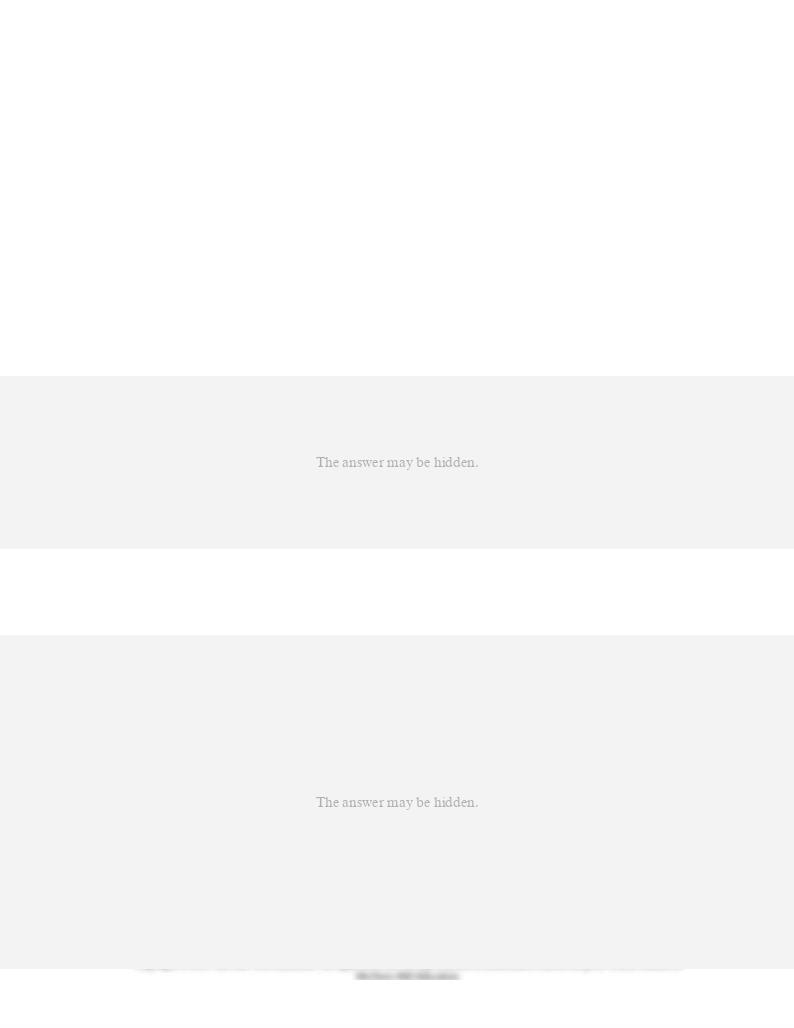
Chapter 04
Market Failures: Public Goods and Externalities
Multiple Choice Questions
1.
Which of the following is an example of a market failure?
2.
Which of the following situations is
not
an example of market failure:
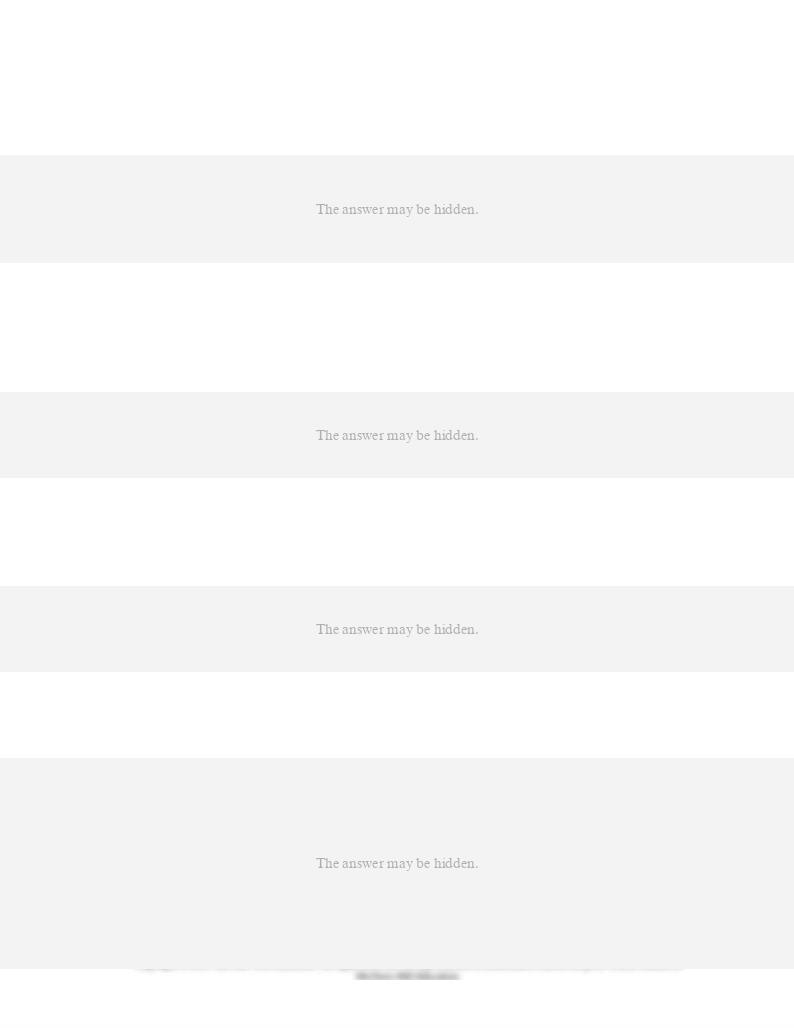
3.
Which of the following statements about market failure is
not
true:
4.
If many people in a community get flu shots, the whole community benefits including those
that did not get flu shots. Therefore, not enough people may decide to get the shots. This is
one illustration of:
5.
When producers do not produce the efficient amount of a product because they are unable to
charge consumers what they are willing to pay for it, then we have a:
6.
When producers do not have to pay the full cost of producing a product, they tend to:
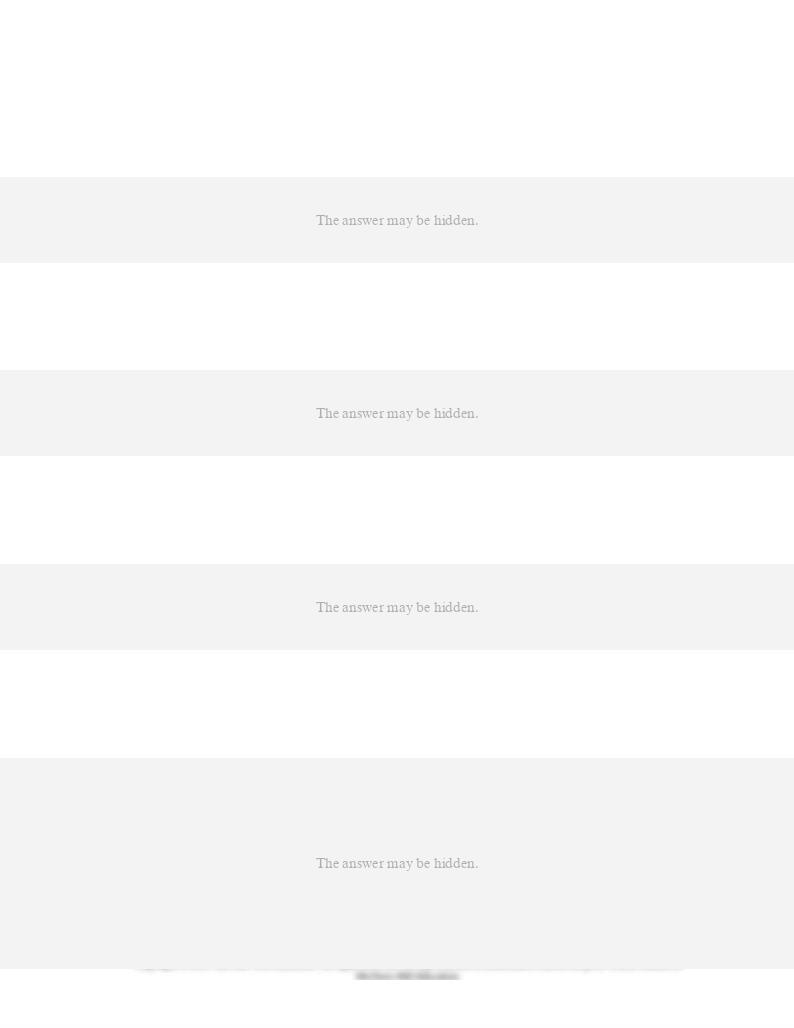
7.
When producers (say, of roads) are not able to make all consumers pay for enjoying their
product (i.e., the roads), they tend to see a:
8.
A competitive market can produce economically efficient outcomes if these conditions are
met,
except
:
9.
The difference between the maximum price a consumer is willing to pay for a product and the
actual price the consumer pays is called:
10.
The value that consumers get (from consuming a product) over and above that they actually
paid for the product is called:
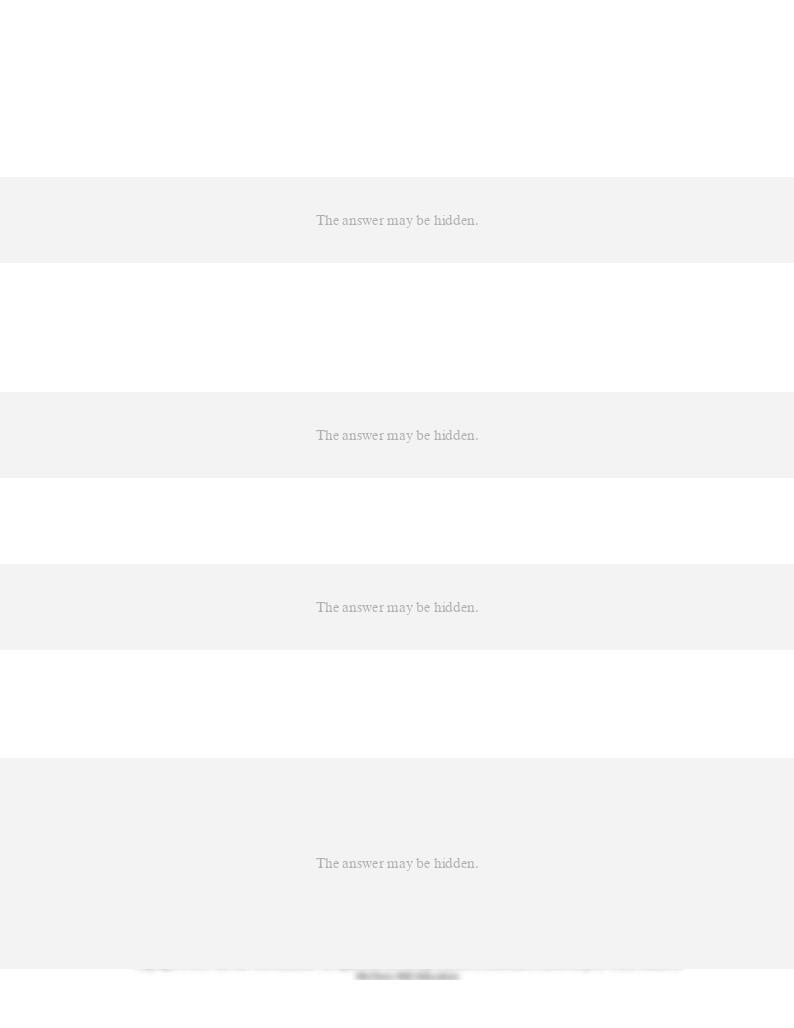
11.
Charlie is willing to pay $10 for a T-shirt that is priced at $9. If Charlie buys the T-shirt, then
his consumer surplus is
12.
In the market for a particular pair of shoes, Jena is willing to pay $75 for a pair while Jane is
willing to pay $85 for a pair. The actual price that each has to pay for a pair of shoes is $65.
What is the combined amount of consumer surplus of Jena and Jane?
13.
Consumer surplus arises in a market because:
14.
If the unit price of a product is P, then the amount of spending that the buyers would need to
pay for a given quantity Q is equal to:

15.
If the price of a product increases:
16.
The equilibrium point in the market is where S and D curve intersect.
Refer to the graph above. At equilibrium, consumer surplus would be represented by the
area:
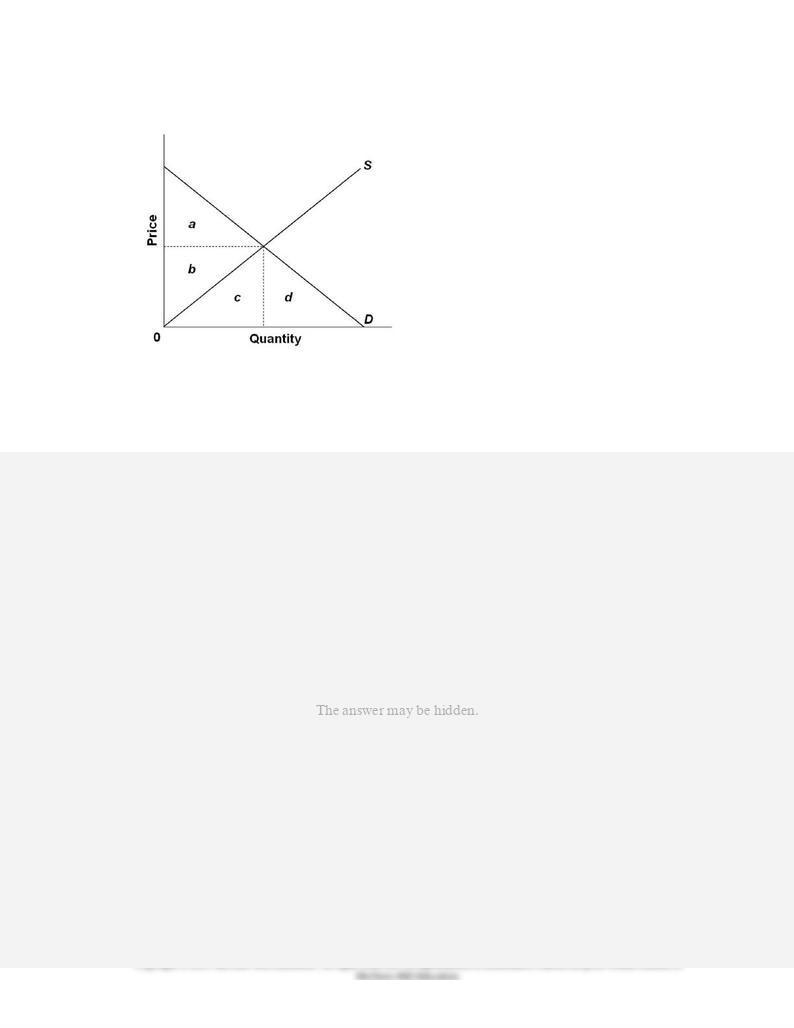
17.
The equilibrium point in the market is where S and D curve intersect.
Refer to the graph above. At equilibrium, the total amount of spending that consumers would
be paying for the product is represented by the area:

18.
The equilibrium point in the market is where S and D curve intersect.
Refer to the graph above. At equilibrium, the total maximum amount that consumers would
have been willing to pay for the product is represented by the area:
19.
The difference between the actual price that a producer receives and the minimum
acceptable price the producer is willing to accept is called the producer:
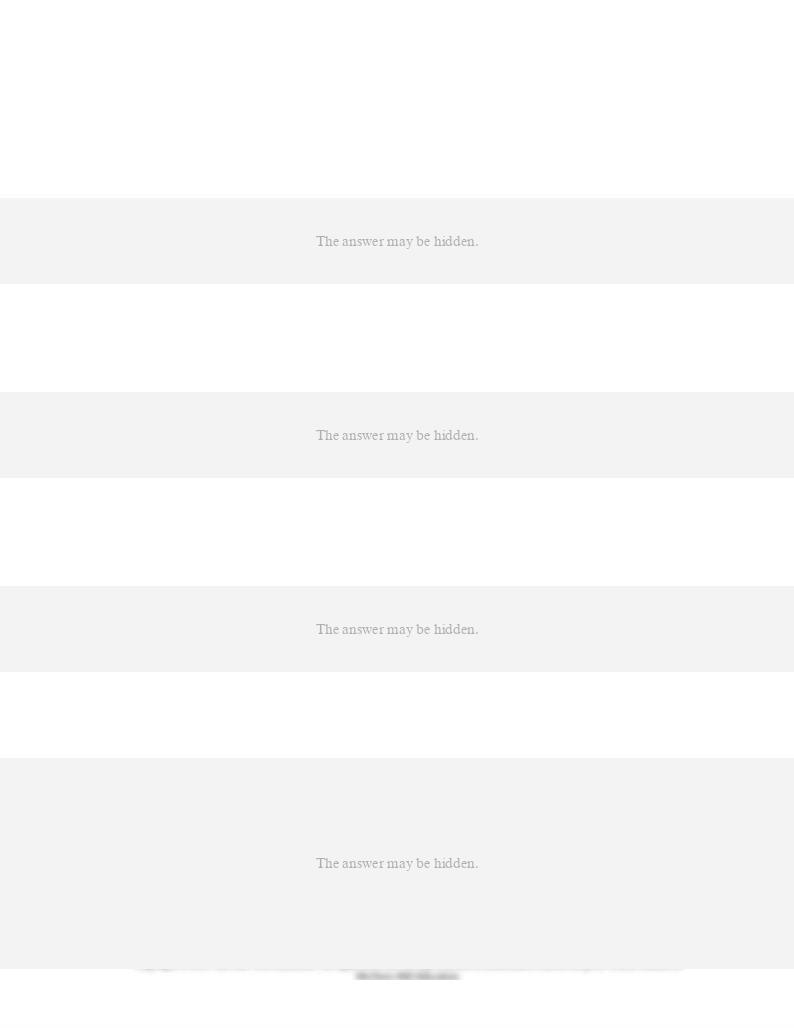
20.
The minimum acceptable price for a product that producer Sam is willing to receive is $15.
The price he could get for the product in the market is $18. How much is Sam's producer
surplus?
21.
The amount of revenues that sellers actually receive over and above the minimum acceptable
amount that they are willing to receive for selling a product is called:
22.
If the unit price of a product is P and buyers buy a given quantity Q, then sellers would collect
total revenues equal to:
23.
The market supply curve indicates the:

24.
At equilibrium in a market for a product, the total revenues received by sellers equal the:
25.
The equilibrium point in the market is where S and D curve intersect.
Refer to the graph above. At equilibrium, the producer surplus would be represented by the
area:
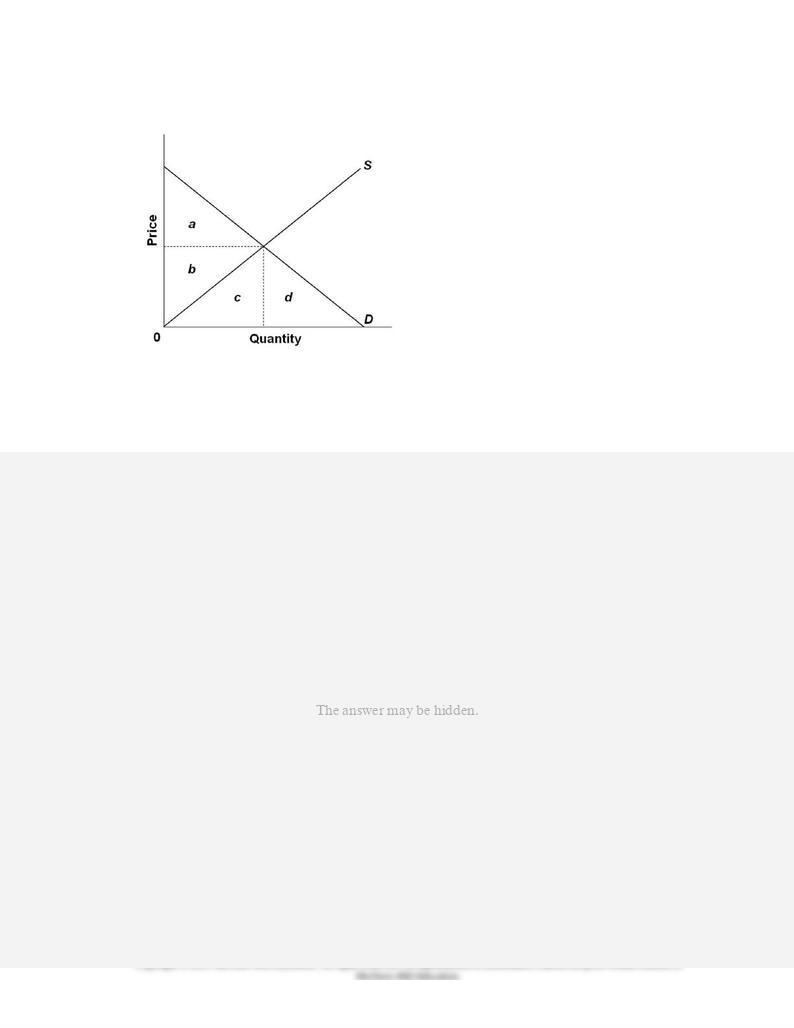
26.
The equilibrium point in the market is where S and D curve intersect.
Refer to the graph above. At equilibrium, the total revenues received by sellers would be
represented by the area:
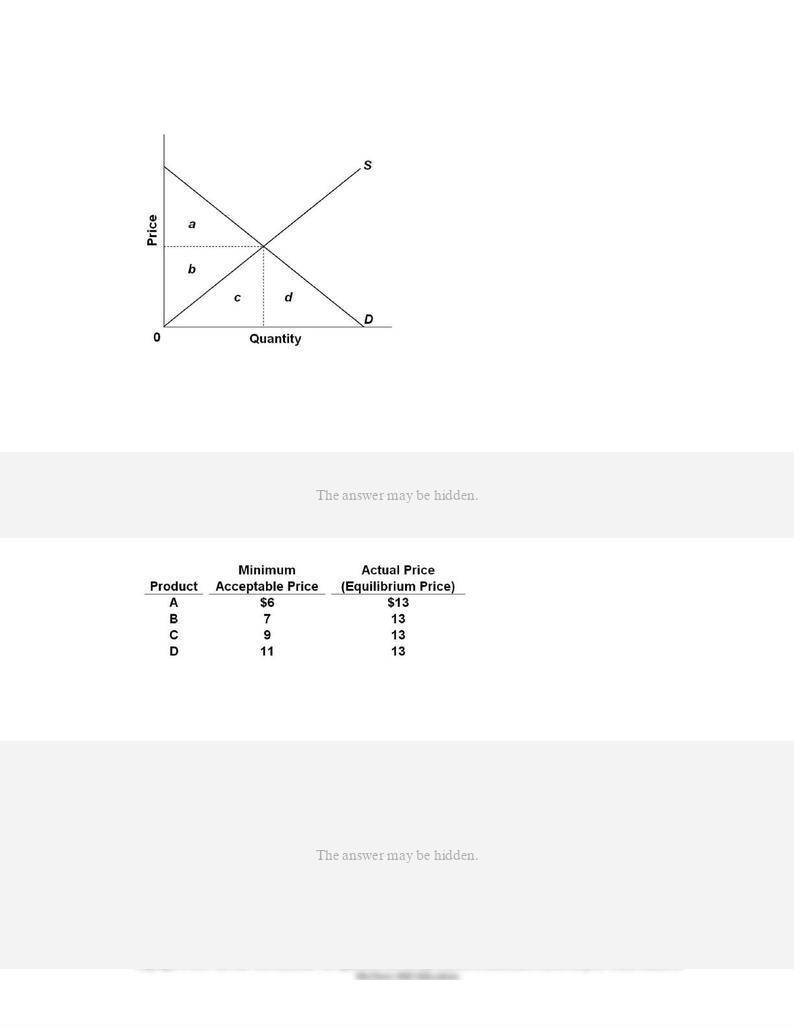
27.
The equilibrium point in the market is where S and D curve intersect.
Refer to the graph above. At equilibrium, the minimum acceptable revenue that sellers would
have been willing to receive is represented by the area:
28.
Refer to the above table. The producer surplus is $4 for producer:
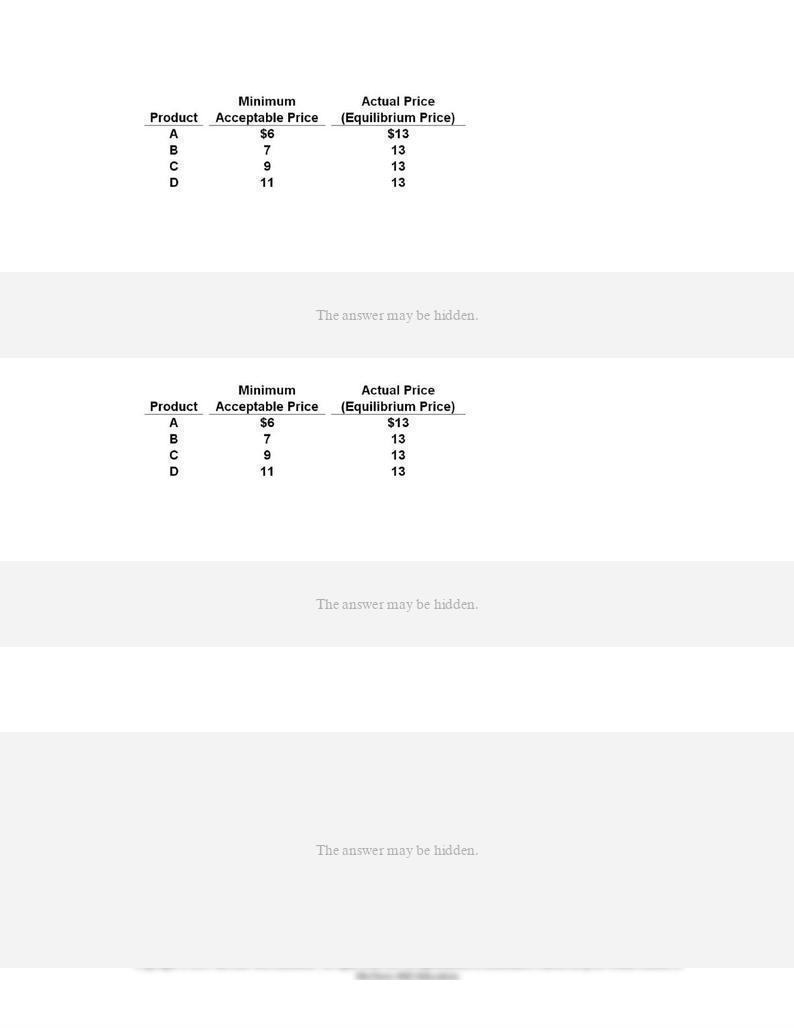
29.
Refer to the above table. What is the producer surplus for all producers A, B, C, and D?
30.
Refer to the above table. If the equilibrium price increases, then the:
31.
When economic efficiency is attained, it implies all of the following,
except
:
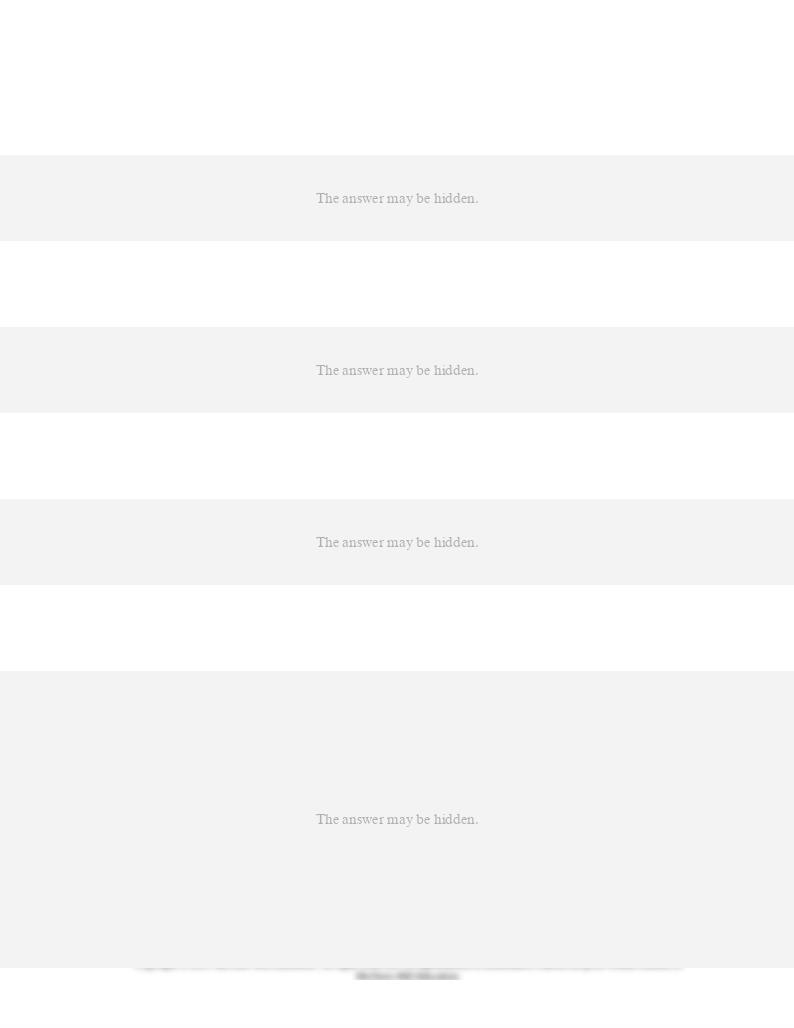
32.
When a competitive market achieves allocative efficiency, it implies that:
33.
Deadweight losses occur when the quantity of an output produced is:
34.
When there is overproduction of a good:
35.
When the marginal benefit of an output exceeds the marginal cost:
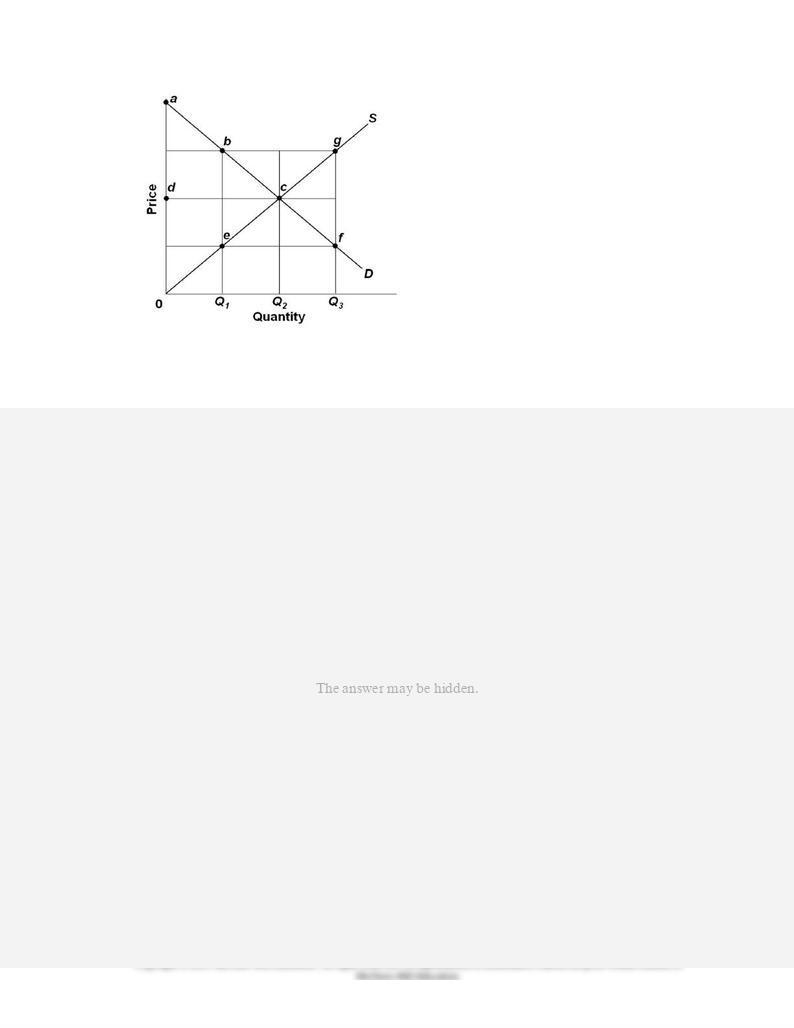
36.
Refer to the above graph. If the output level is Q2, then there will be:
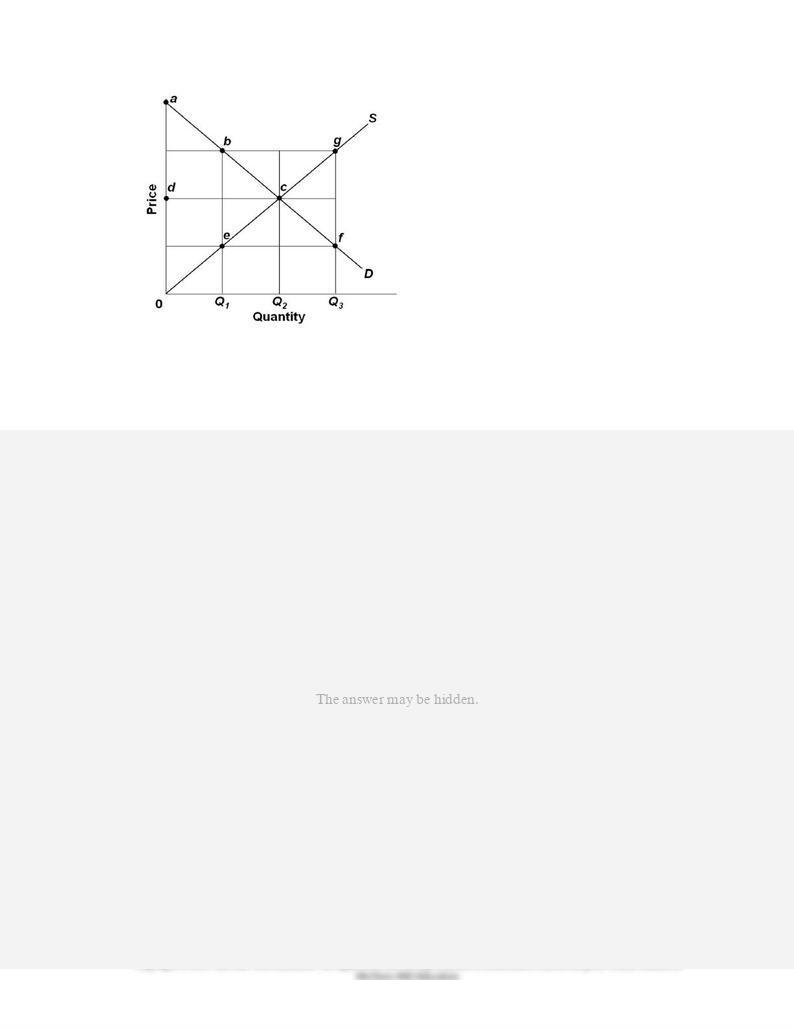
37.
Refer to the above graph. If the output level is Q1, then there are efficiency losses indicated
by the area:
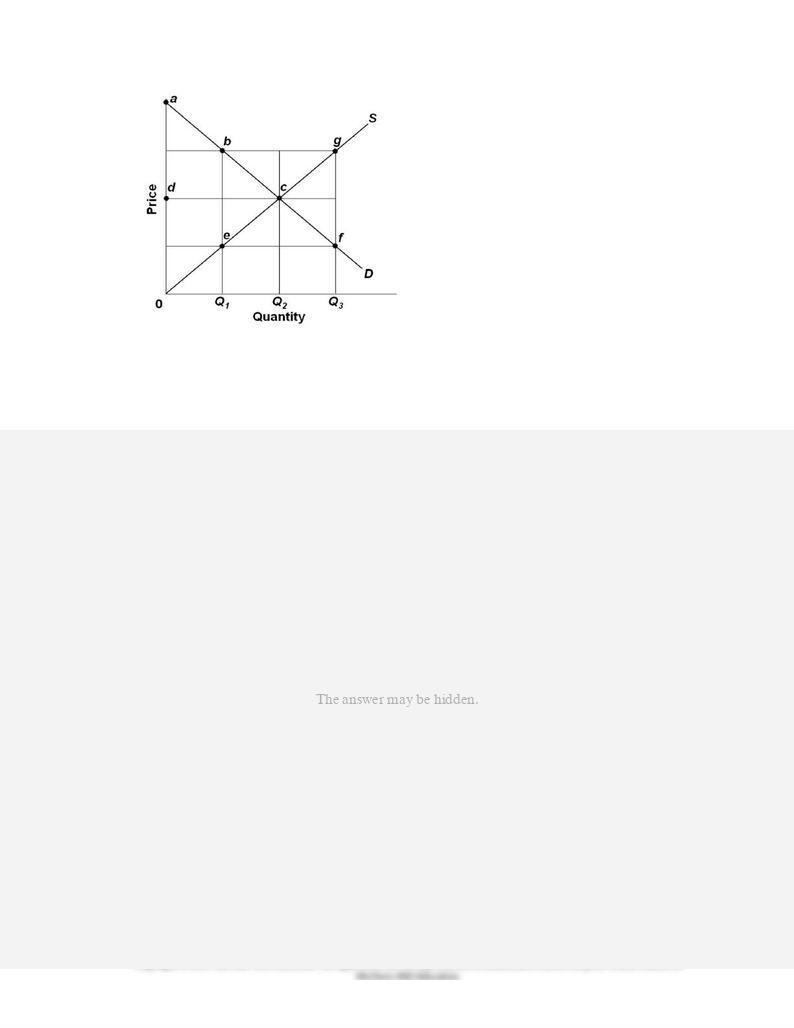
38.
Refer to the above graph. If the output level is Q1, then the sum of the consumer and
producer surplus is:

39.
Refer to the above graph. If the output level increases from Q2 to Q3, then the:
40.
What are the two characteristics that differentiate private goods from public goods?
41.
Private firms can hardly produce a public good profitably because of:
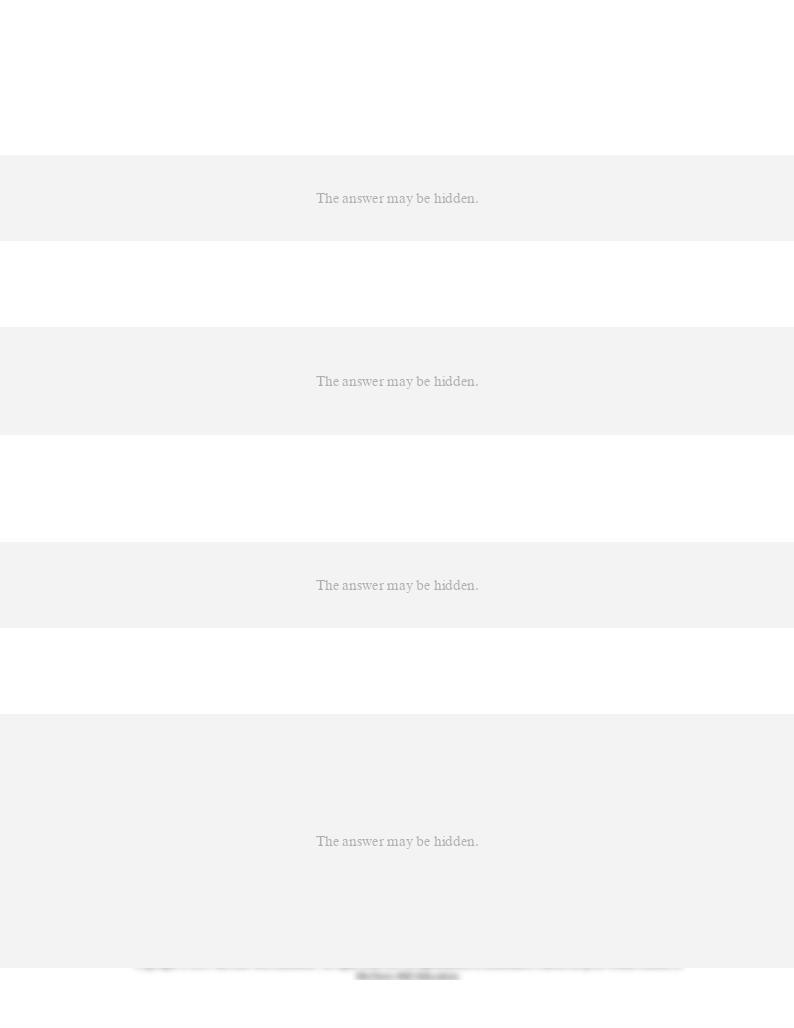
42.
Among the following examples, the one that best illustrates a public good is:
43.
A public good:
44.
Assume there is no way to prevent someone from using an interstate highway, regardless of
whether or not he or she helps pay for it. This characteristic is called:
45.
Which of the following statements concerning a pure public good is false?
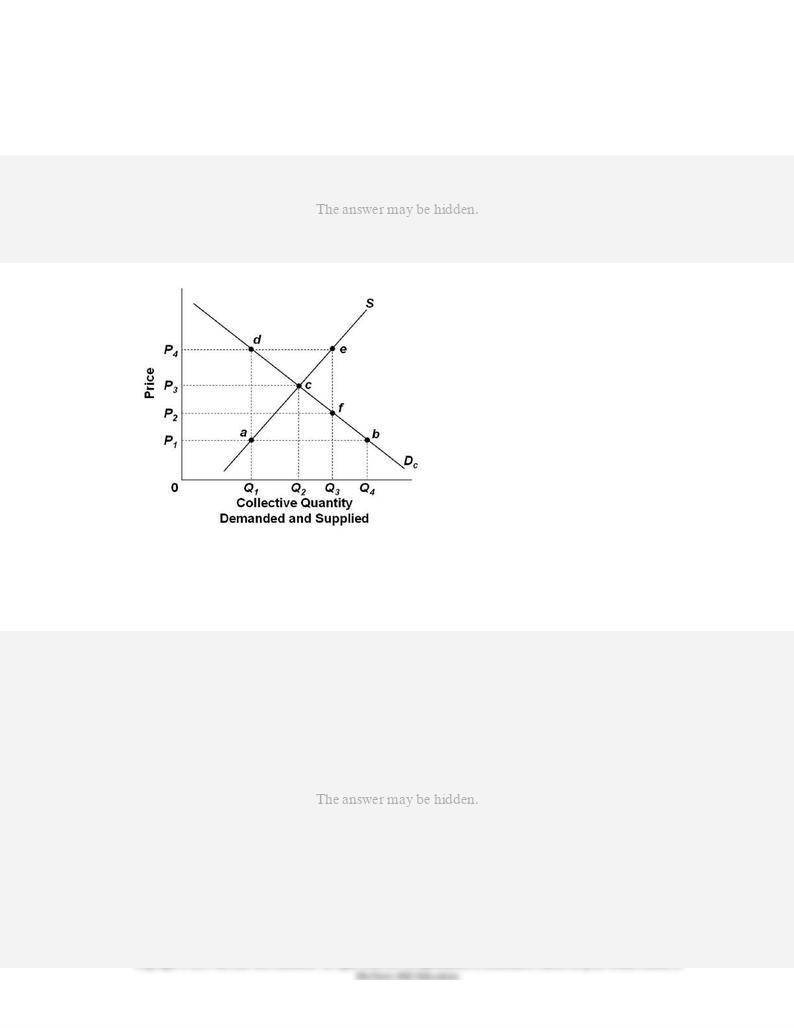
46.
The market demand curve for a public good:
47.
Refer to the above supply and demand graph for a public good. Point
c
on the graph shows
where the:
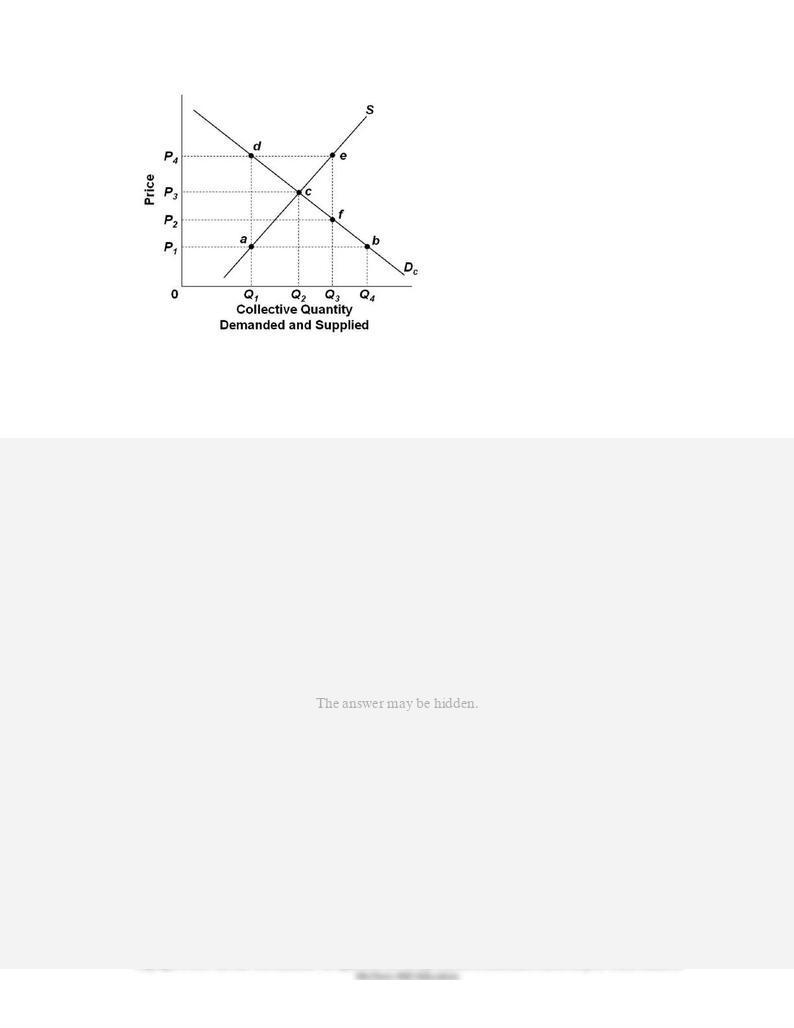
48.
Refer to the above supply and demand graph for a public good. If
Q1
units of the public good
are produced, then:
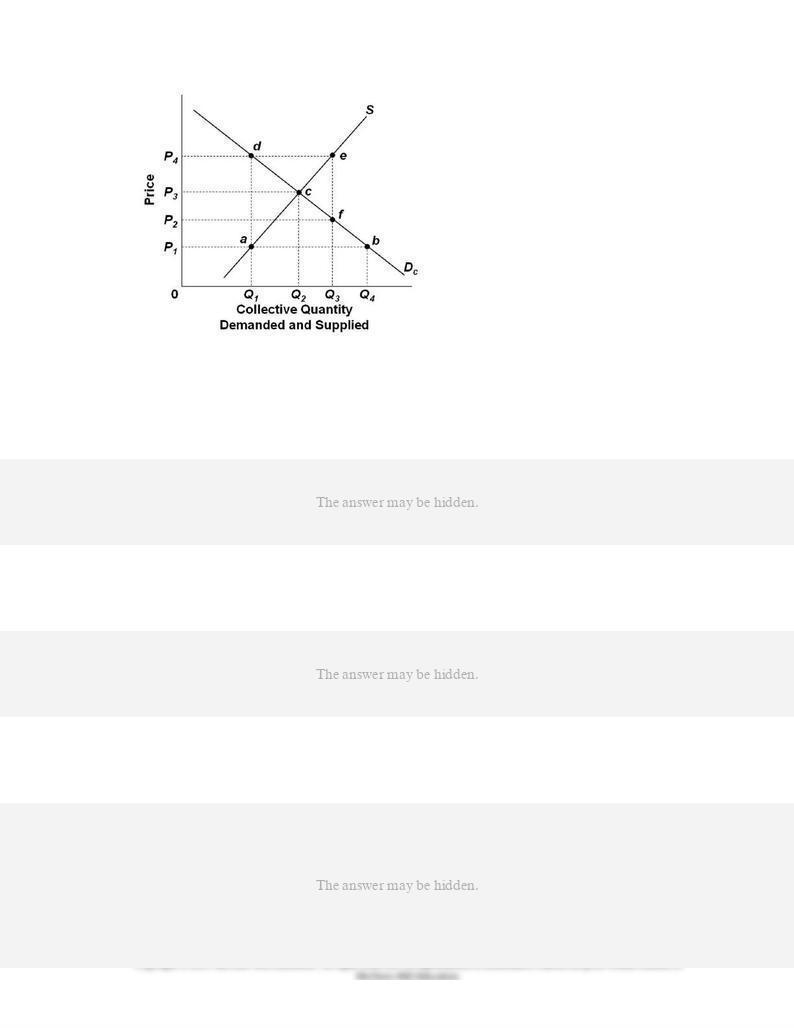
49.
Refer to the above supply and demand graph for a public good. Which line segment would
indicate the amount by which the marginal benefit of this public good exceeds the marginal
cost at a certain quantity?
50.
Street entertainers face the free-rider problem when they perform because of the:
51.
For the music industry, the rise of Internet file-sharing of music has:
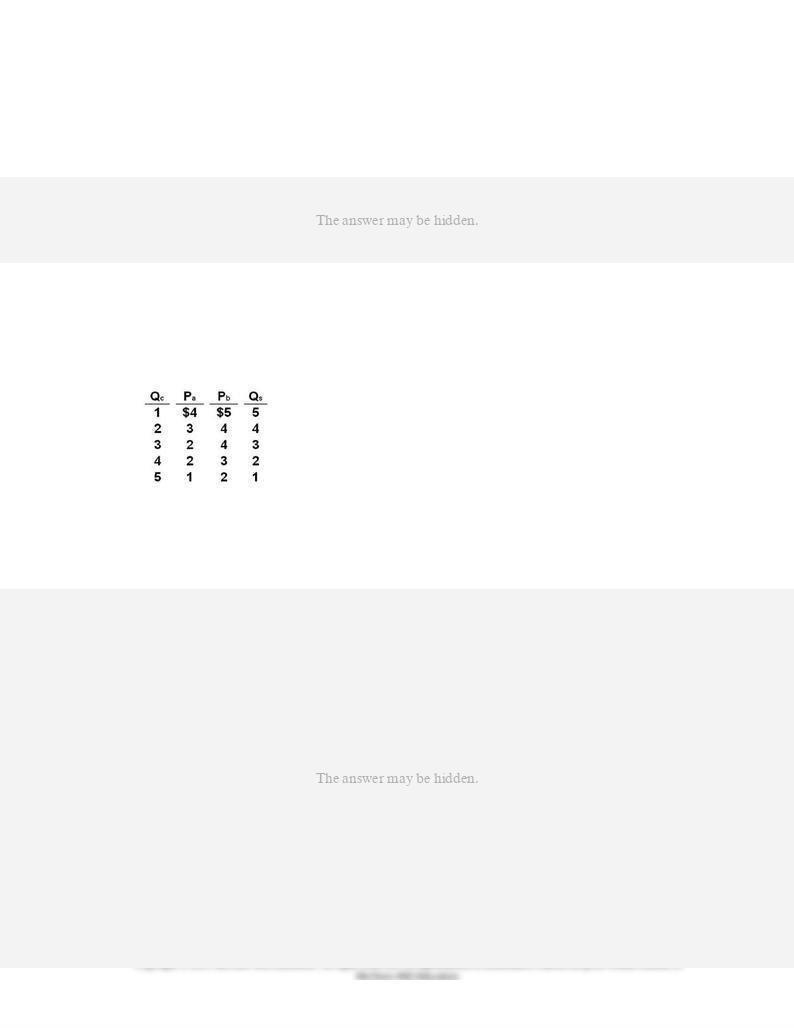
52.
Government can reallocate resources away from private goods towards public goods, usually
through:
53.
Answer the question on the basis of the following information is for public good. Pa and Pb
represent the prices that citizens (a) and (b), the only two people in this nation, are willing to
pay for additional units of a quantity (Qc) of the public good. Qs represents the quantity of the
public good supplied by government at each of the collective prices.
Refer to the above information. The collective willingness of this nation to pay for the fourth
unit of the public good is:

54.
Answer the question on the basis of the following information is for public good. Pa and Pb
represent the prices that citizens (a) and (b), the only two people in this nation, are willing to
pay for additional units of a quantity (Qc) of the public good. Qs represents the quantity of the
public good supplied by government at each of the collective prices.
Refer to the above information. If only 1 unit of this public good is produced, then the
marginal benefit is:
55.
Answer the question on the basis of the following information is for public good. Pa and Pb
represent the prices that citizens (a) and (b), the only two people in this nation, are willing to
pay for additional units of a quantity (Qc) of the public good. Qs represents the quantity of the
public good supplied by government at each of the collective prices.
Refer to the above information. In equilibrium, the marginal benefit and cost of the public
good will be:
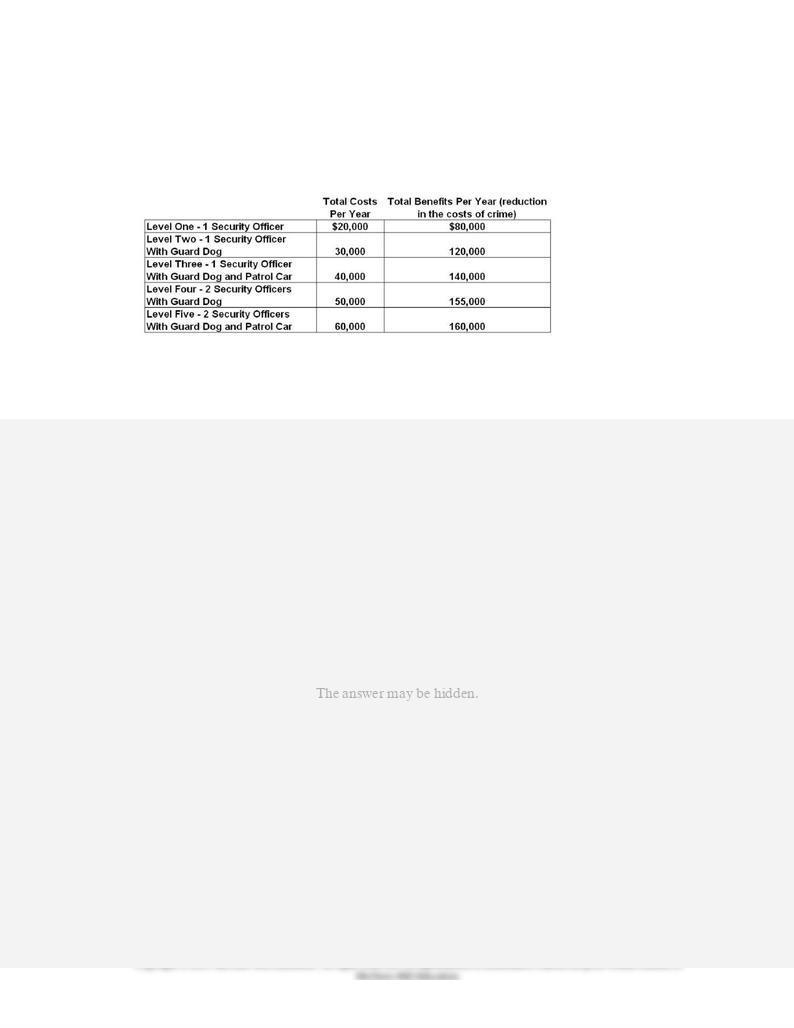
56.
Answer the question based on the following information. Normal University has found it
necessary to institute a crime-control program on its campus to deal with the high costs of
theft and vandalism. The university is now considering several alternative levels of crime
control. This table shows the expected annual costs and benefits of these alternatives.
Refer to the above information. The marginal benefits of crime control for Level Two are:
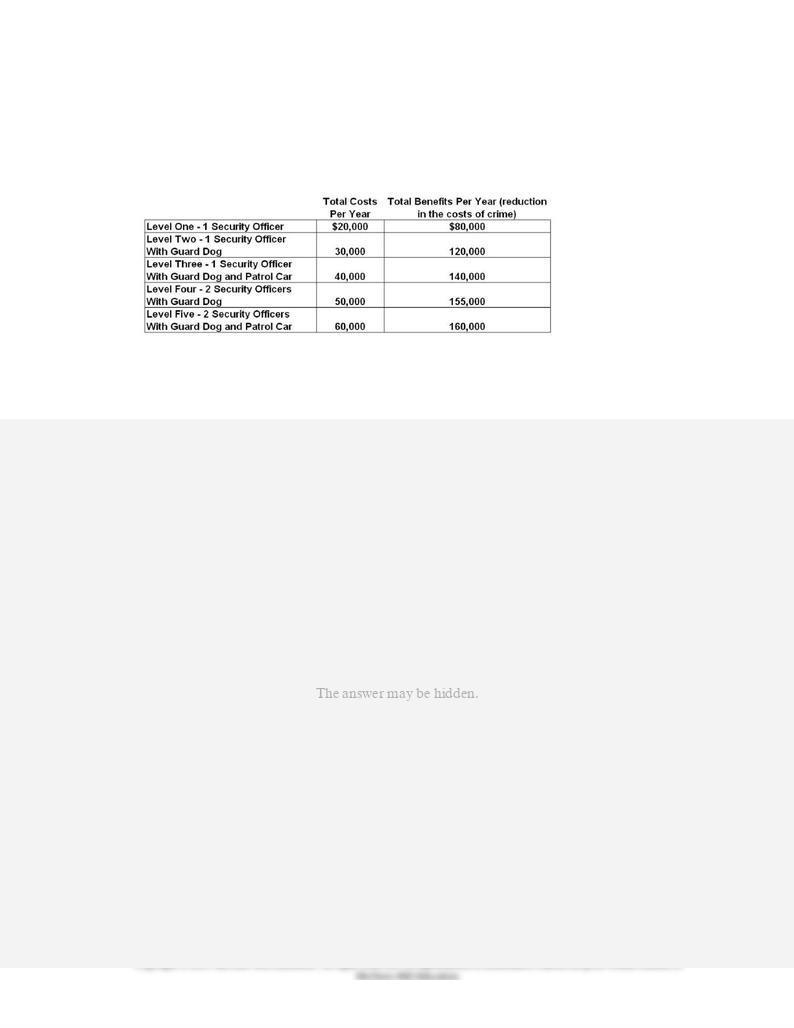
57.
Answer the question based on the following information. Normal University has found it
necessary to institute a crime-control program on its campus to deal with the high costs of
theft and vandalism. The university is now considering several alternative levels of crime
control. This table shows the expected annual costs and benefits of these alternatives.
Refer to the above information. If Normal University undertakes program Level Three:

58.
Answer the question based on the following information. Normal University has found it
necessary to institute a crime-control program on its campus to deal with the high costs of
theft and vandalism. The university is now considering several alternative levels of crime
control. This table shows the expected annual costs and benefits of these alternatives.
Refer to the above information. Based on cost-benefit analysis, Normal University should
undertake Level:
59.
Assume that a government is considering a new social program and may choose to include in
this program any number of four progressively larger projects. The marginal cost and the
marginal benefits of each of the four projects are given in the table.
Refer to the above table and information. What project should the government select to
achieve the maximum net benefit?
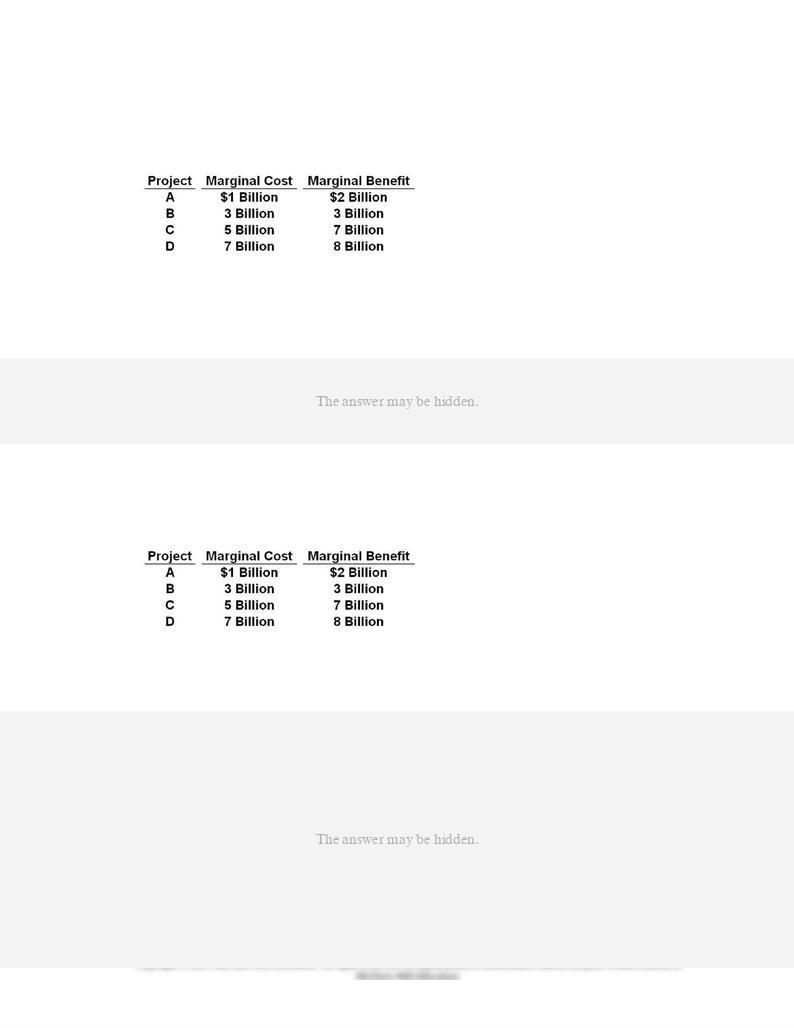
60.
Assume that a government is considering a new social program and may choose to include in
this program any number of four progressively larger projects. The marginal cost and the
marginal benefits of each of the four projects are given in the table.
Refer to the above table and information. What is the total cost and total benefit of doing
projects A, B, and C?
61.
Assume that a government is considering a new social program and may choose to include in
this program any number of four progressively larger projects. The marginal cost and the
marginal benefits of each of the four projects are given in the table.
Refer to the above table and information. What is the net benefit of project D?
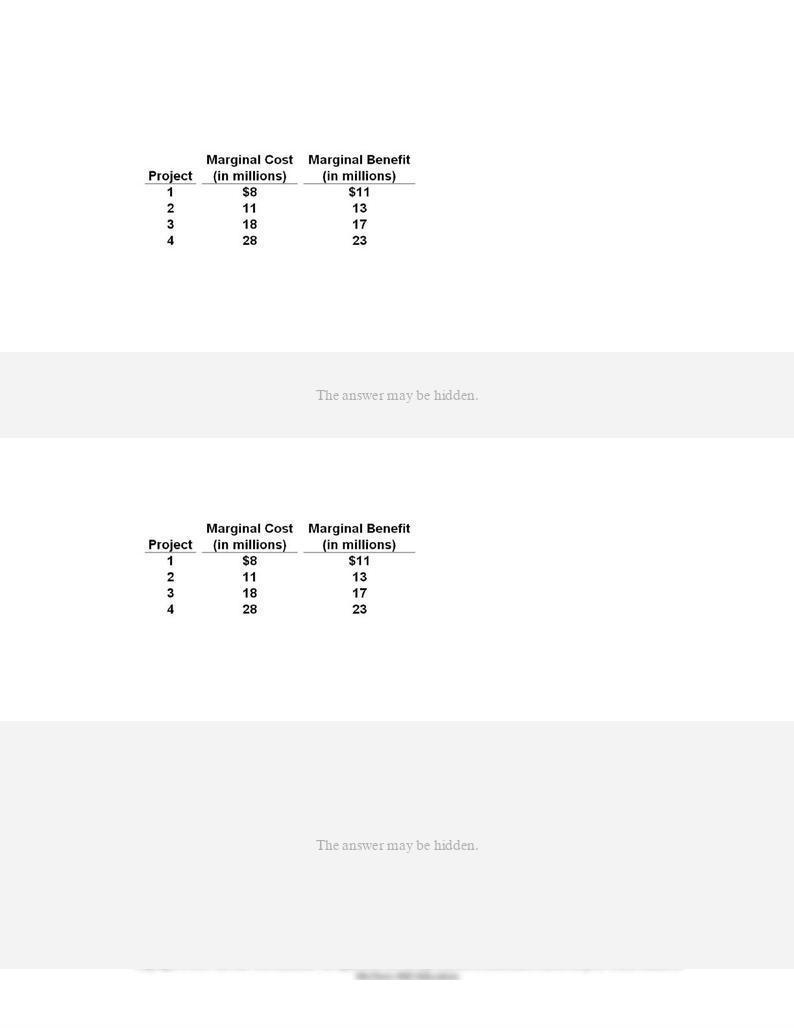
62.
A government is considering undertaking one or more construction projects. The estimated
marginal costs and benefits of each project are given in the table.
Refer to the above table and information. What is the total amount that the government
should spend on construction projects?
63.
A government is considering undertaking one or more construction projects. The estimated
marginal costs and benefits of each project are given in the table.
Refer to the above table and information. What is the total cost and total benefit of projects
1, 2, and 3?
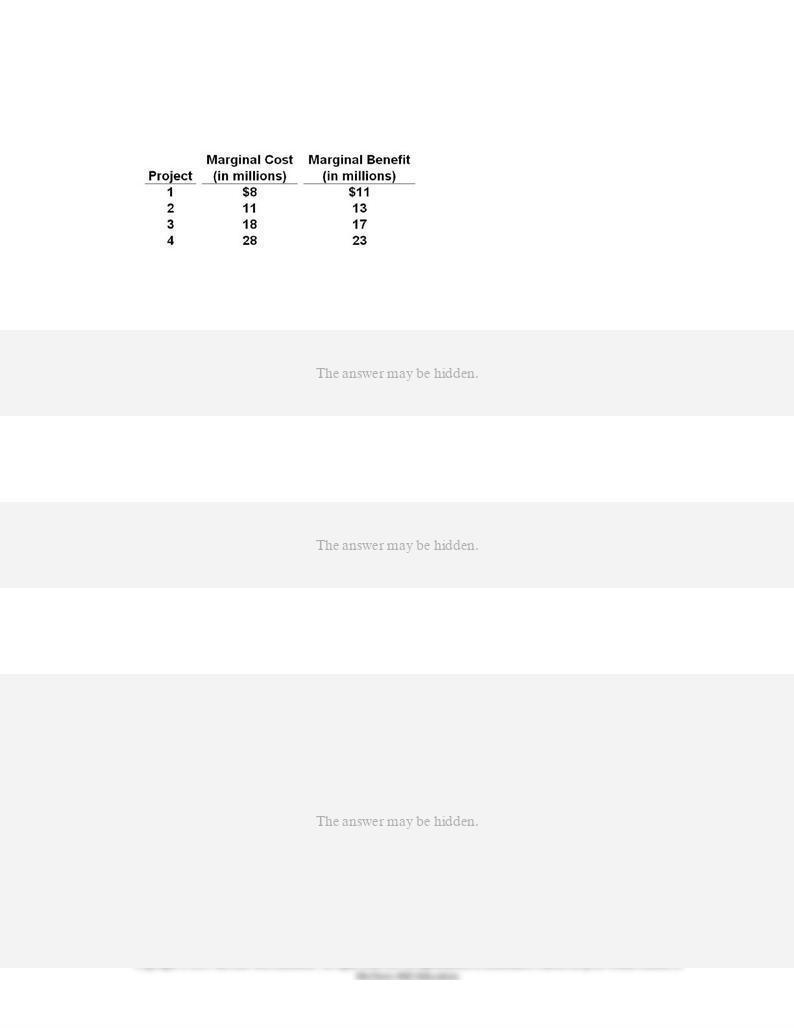
64.
A government is considering undertaking one or more construction projects. The estimated
marginal costs and benefits of each project are given in the table.
Refer to the above table and information. What is the net benefit of project 2?
65.
Which of the following is an example of a negative externality?
66.
In a free-market economy, a product which entails a positive externality will be:
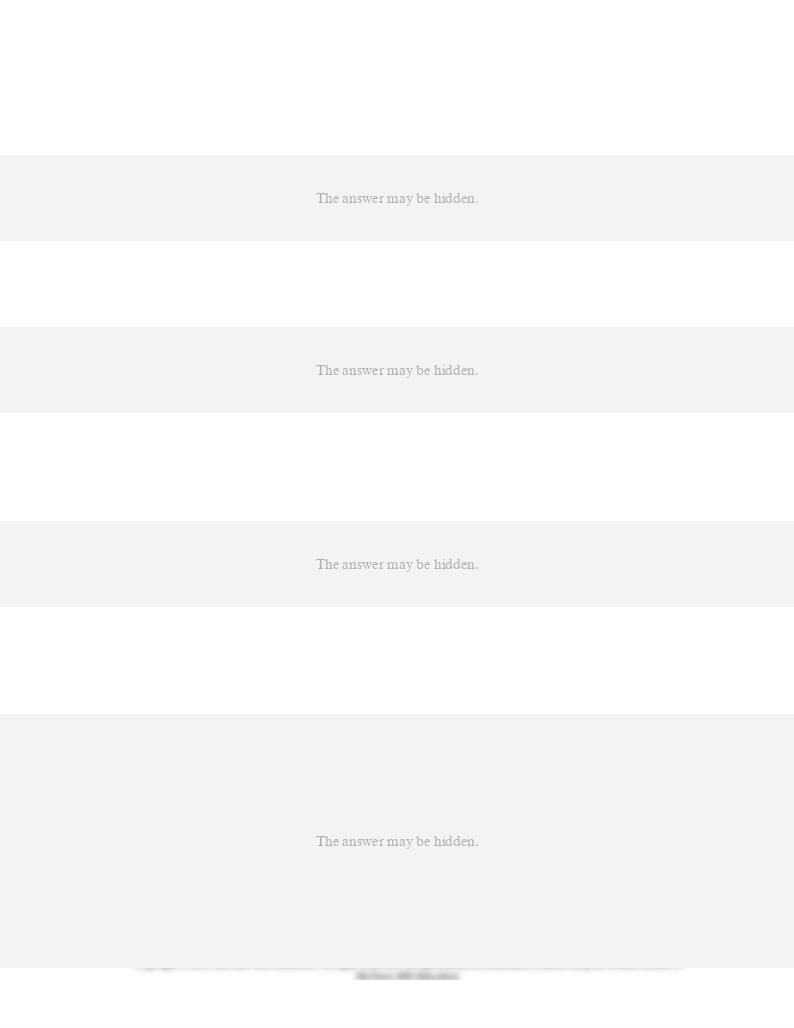
67.
In a situation where an externality occurs, the "third party" refers to those who:
68.
External benefits in consumption refer to benefits accruing to:
69.
If some activity creates external benefits as well as private benefits, then economic theory
suggests that the activity ought to be:
70.
If a good that generates negative externalities were priced to take these negative
externalities into account, then its:
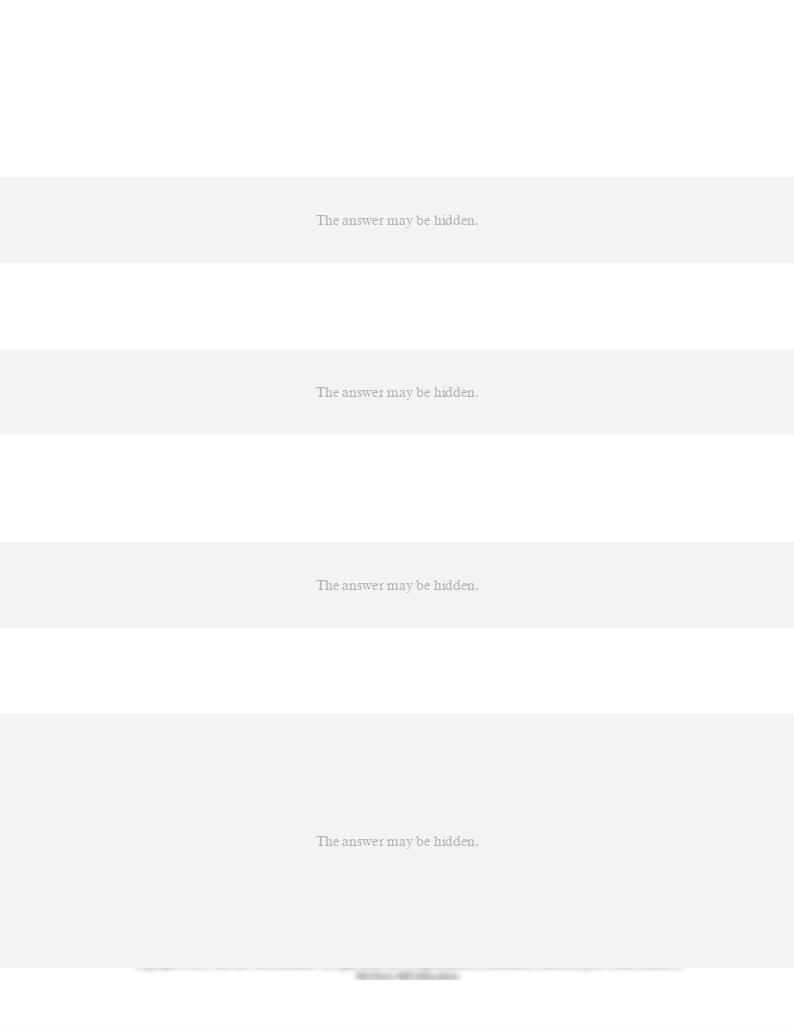
71.
In a market where negative externalities are associated with consumption and production,
the equilibrium will not be efficient because:
72.
If there are external benefits associated with the consumption of a good or service:
73.
If the production of a product or service involves external benefits, then the government can
improve efficiency in the market by:
74.
When the production of a good generates external costs, the firm's supply curve will be:
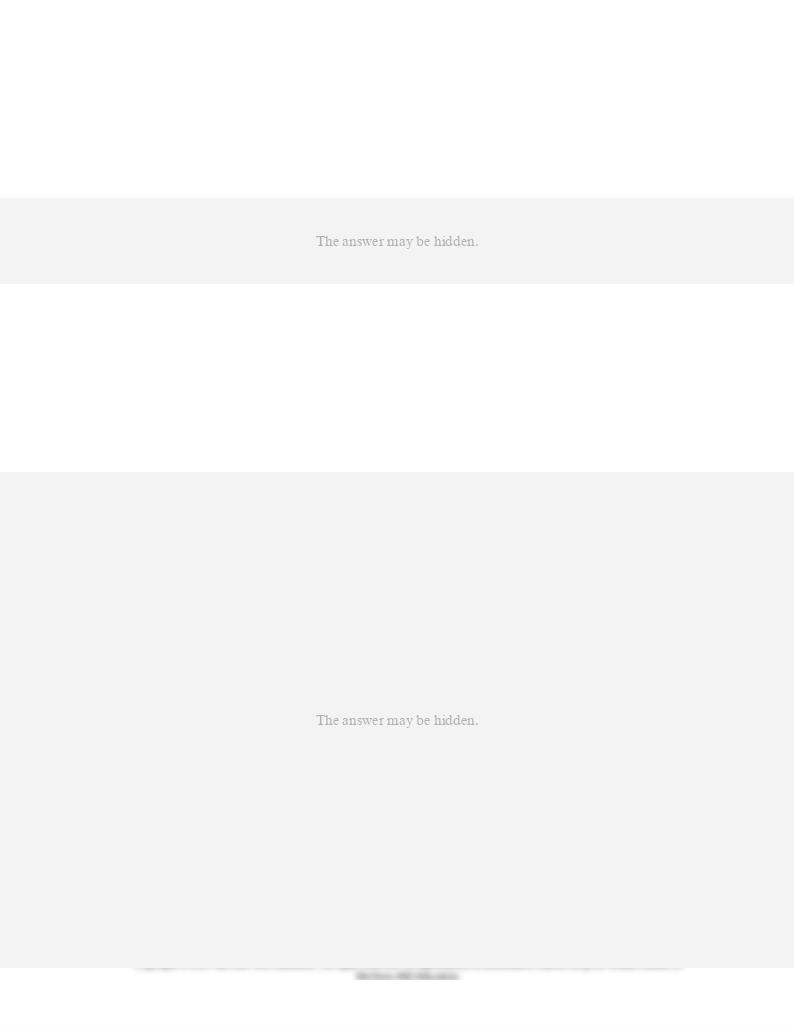
75.
Where there are spillover (or external) benefits from having a particular product in a society,
the government can make the quantity of the product approach the socially optimal level by
doing the following
except
:
76.
It is the custom for paper mills located alongside the Layzee River to discharge waste
products into the river. As a result, operators of hydroelectric power-generating plants
downstream along the river find that they must clean up the river's water before it flows
through their equipment.
In the situation described above, we would expect an:

77.
It is the custom for paper mills located alongside the Layzee River to discharge waste
products into the river. As a result, operators of hydroelectric power-generating plants
downstream along the river find that they must clean up the river's water before it flows
through their equipment.
Refer to the above information. Which of the following policies would be most appropriate for
dealing with this problem?
78.
It is the custom for paper mills located alongside the Layzee River to discharge waste
products into the river. As a result, operators of hydroelectric power-generating plants
downstream along the river find that they must clean up the river's water before it flows
through their equipment.
If the government intervenes and corrects the externality in the situation described above, we
would expect:
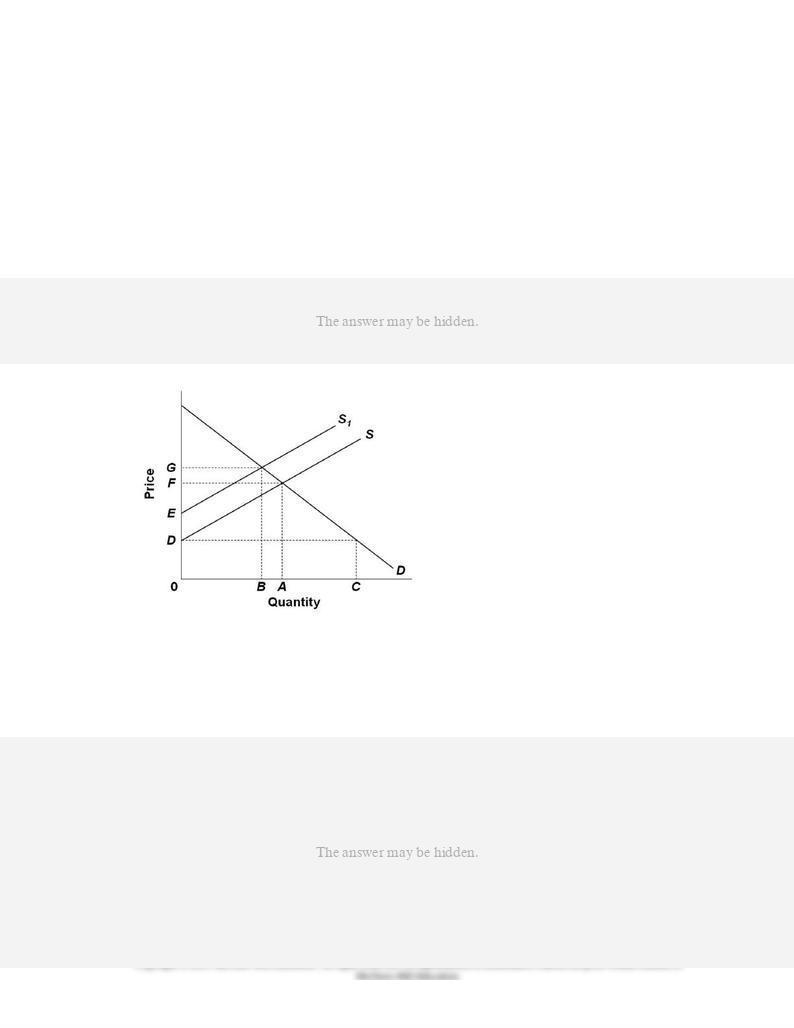
79.
It is the custom for paper mills located alongside the Layzee River to discharge waste
products into the river. As a result, operators of hydroelectric power-generating plants
downstream along the river find that they must clean up the river's water before it flows
through their equipment.
If the government intervenes and corrects the externality in the situation described above, we
would expect:
80.
Refer to the above supply and demand graph. In the graph, line S is the current supply of this
product, while line S1 is the optimal supply from the society's perspective. This figure
suggests that there is (are):
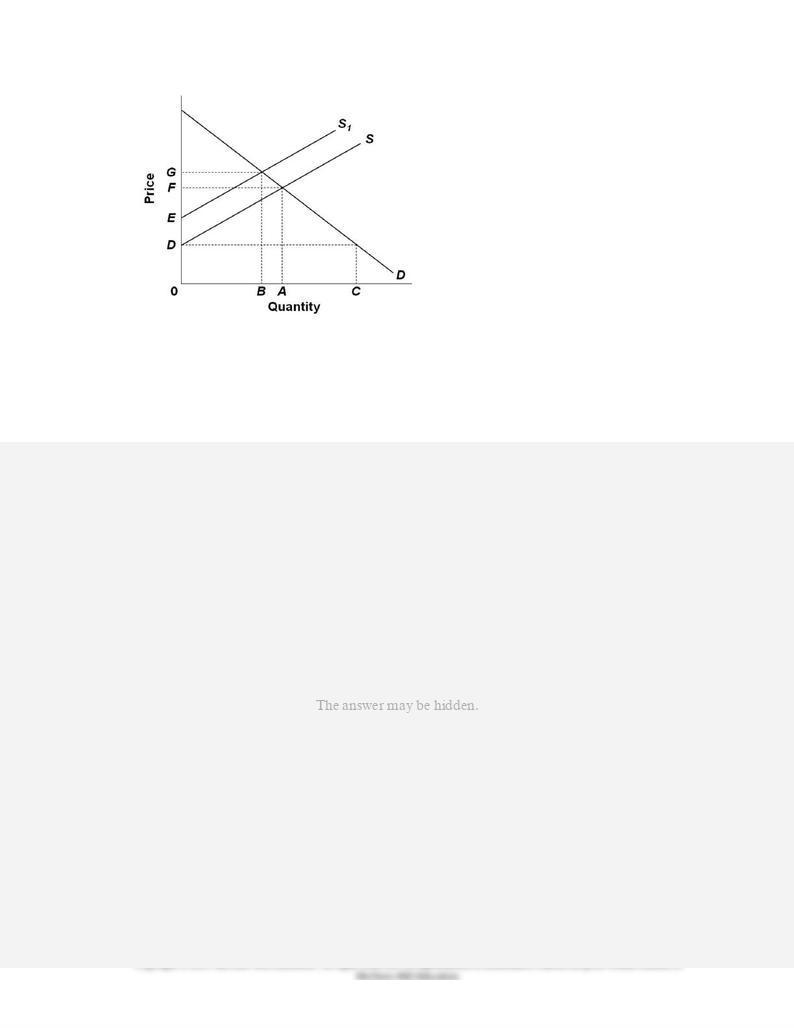
81.
Refer to the above supply and demand graph. In the graph, line S is the current supply of this
product, while line S1 is the optimal supply from the society's perspective. One solution to this
externality problem is to:
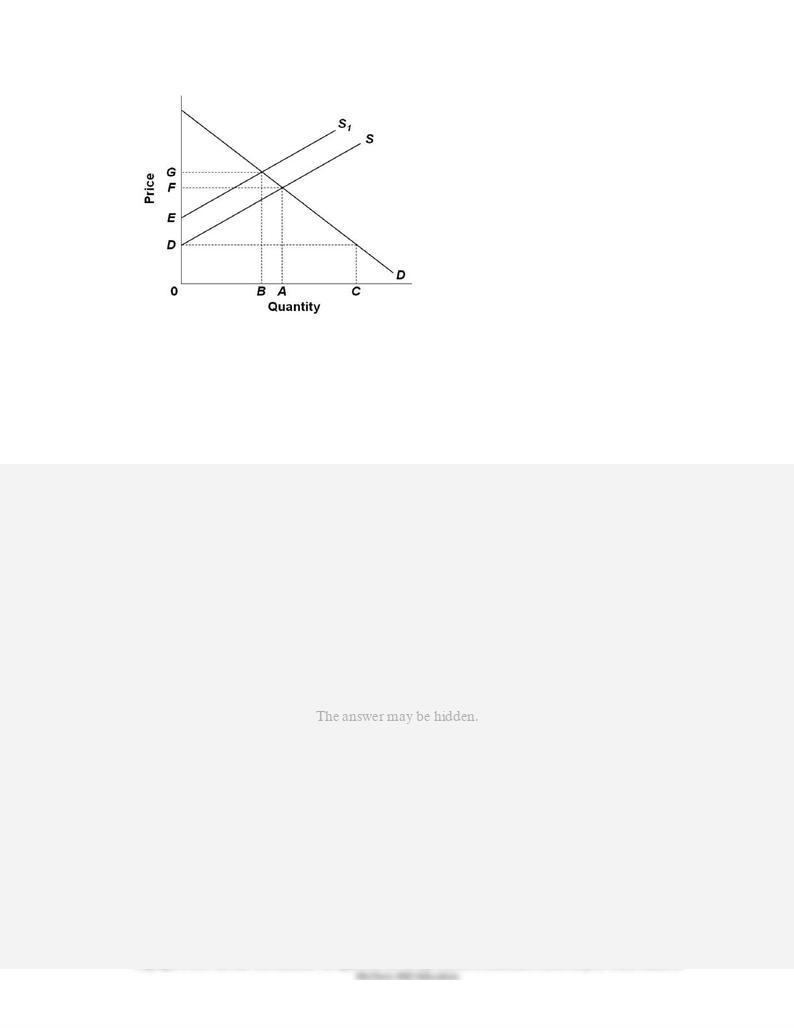
82.
Refer to the above supply and demand graph. In the graph, line S is the current supply of this
product, while line S1 is the optimal supply from the society's perspective. If government
corrects this externality problem and shifts production to the socially optimal level, then the
product price will be equal to:
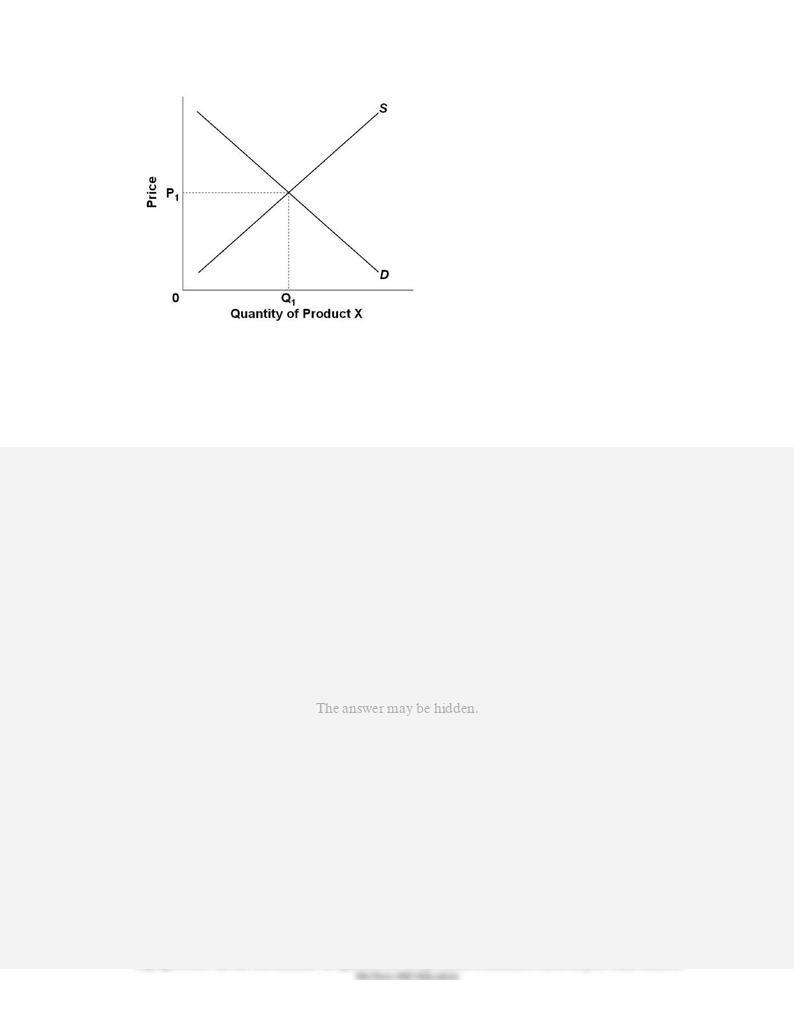
83.
Refer to the above supply and demand graph of Product X. What would happen if the
government taxed the producers of this product because it has negative externalities in
production?
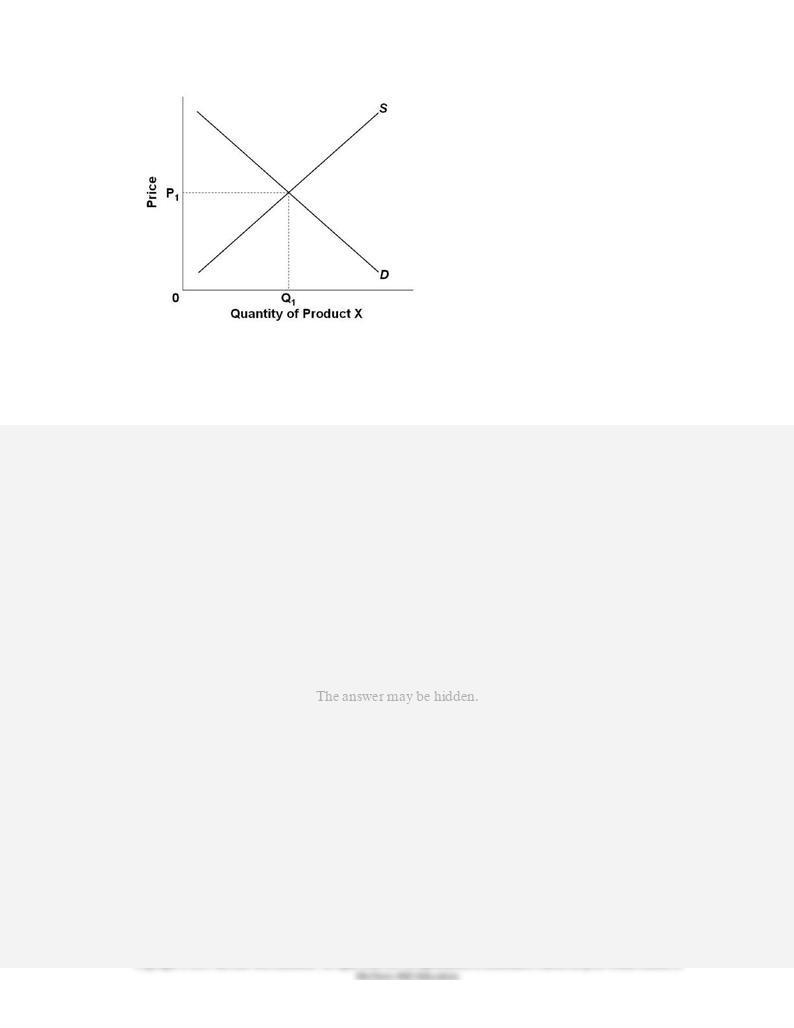
84.
Refer to the above supply and demand graph of Product X. If there are positive externalities
from the consumption of Product X, then the socially optimal demand curve would be:

85.
Refer to the above supply and demand graph of Product X. What would happen if the
government decided to also start providing Product X in the market?
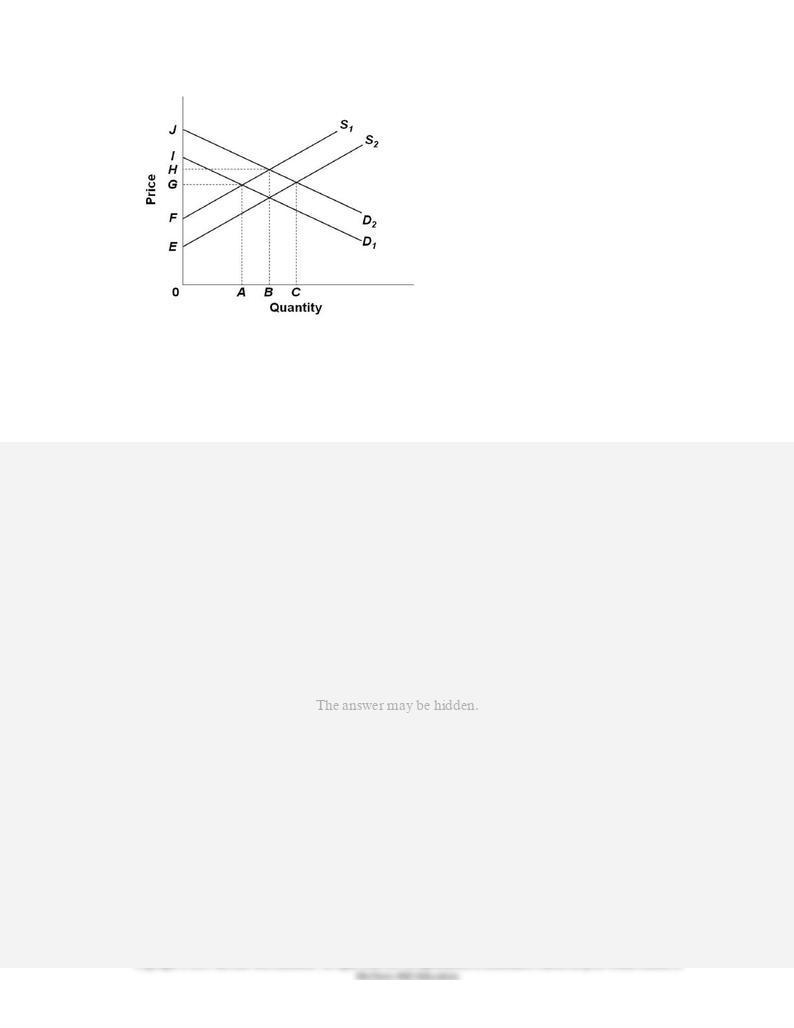
86.
Refer to the above supply and demand graph. S1 and D1 represent the current market supply
and demand, respectively. S2 and D2 represent the socially optimal supply and demand. The
positions of the graphs indicate that there is (are):

87.
Refer to the above supply and demand graph. S1 and D1 represent the current market supply
and demand, respectively. S2 and D2 represent the socially optimal supply and demand. One
way that the government could shift supply to its socially optimal level is to:
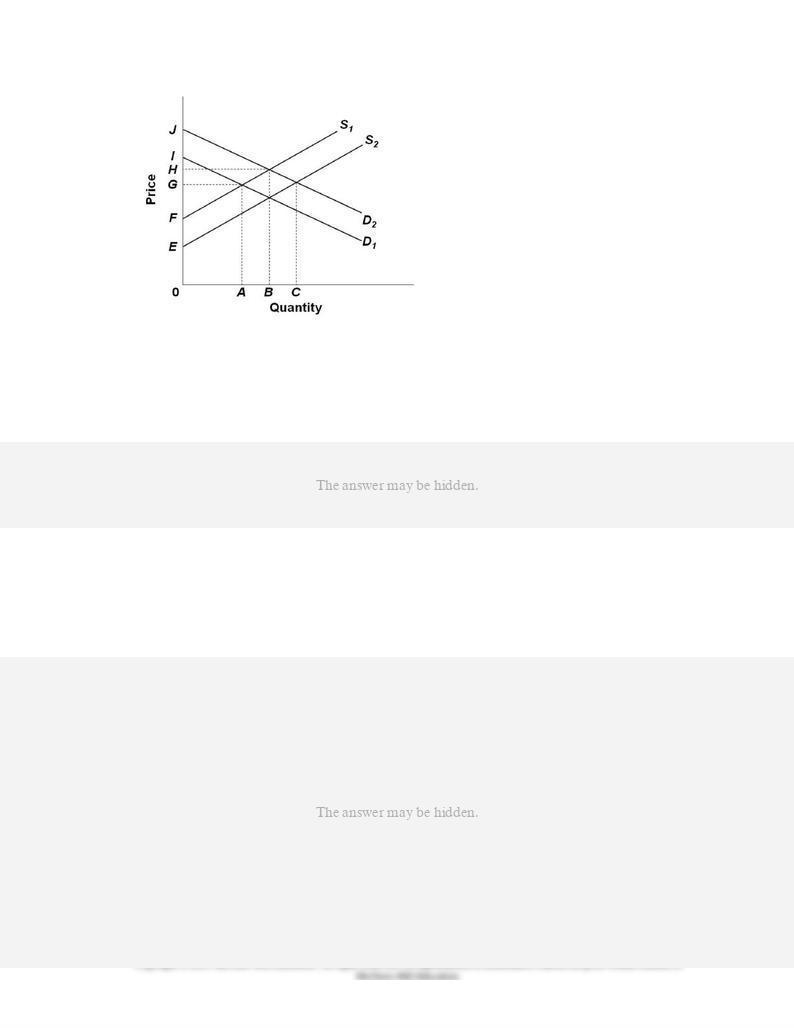
88.
Refer to the above supply and demand graph. S1 and D1 represent the current market supply
and demand, respectively. S2 and D2 represent the socially optimal supply and demand. One
way that the government could shift demand to its socially optimal level is to:
89.
Near an ocean beach, a high-rise building is being constructed that will block the scenic view
of the ocean by the residents of a low-rise building. The Coase theorem suggests that this
type of dispute between the owners of high-rise and low-rise buildings:

90.
According to the Coase Theorem, externality problems:
91.
Which of the following antipollution policies is
least
likely to make use of cost-benefit
analysis?
92.
An emission fee levied against polluting firms will tend to shift the:
93.
It has been proposed that a government agency be charged with the task of determining the
amount of pollution that the atmosphere (or a body of water) can safely absorb, establish
"rights" to this limited amount of pollution, and sell those limited amount of rights to firms.
The firms can then buy and sell these rights among themselves later. This approach is known
as the:
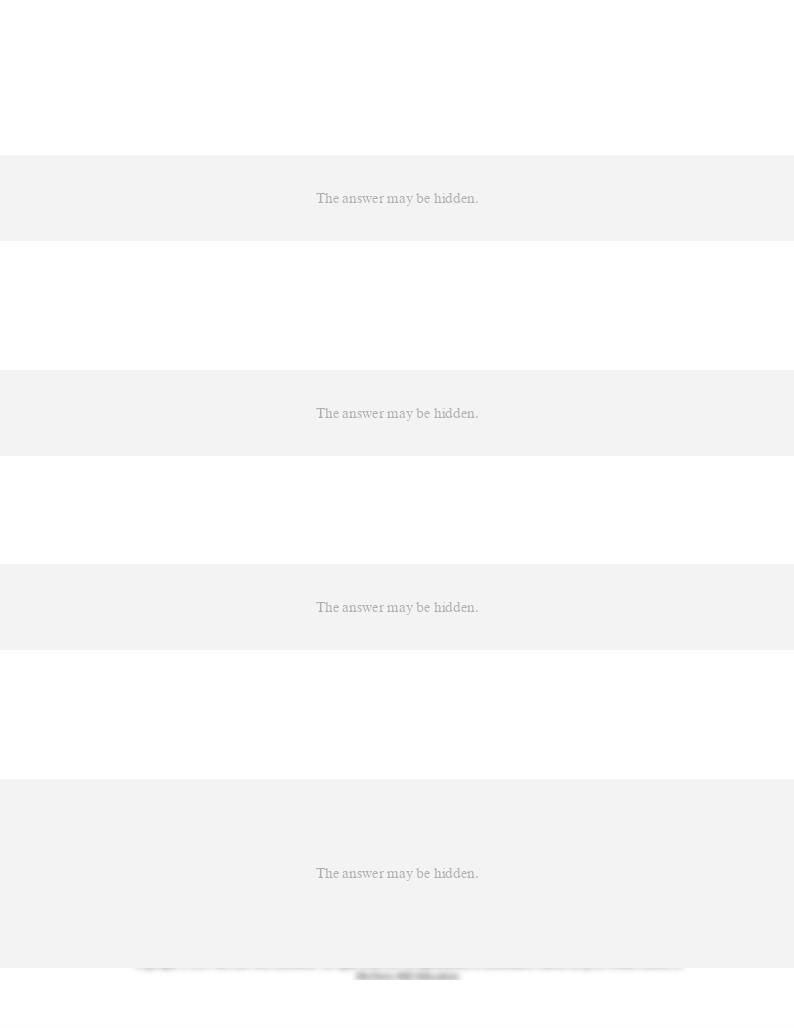
94.
A market for pollution rights can be expected to:
95.
By requiring car producers to install emission control devices on cars, the government forces
these producers to internalize some of the external costs of auto pollution. This will lead to
the equilibrium price of cars:
96.
From an economist's perspective, an important consideration for policies to address global
warming is:
97.
Oftentimes, the socially optimal quantity for a product that imposes external costs on the
society is not zero, but something greater than zero. This is because completely eliminating
the externality would involve:
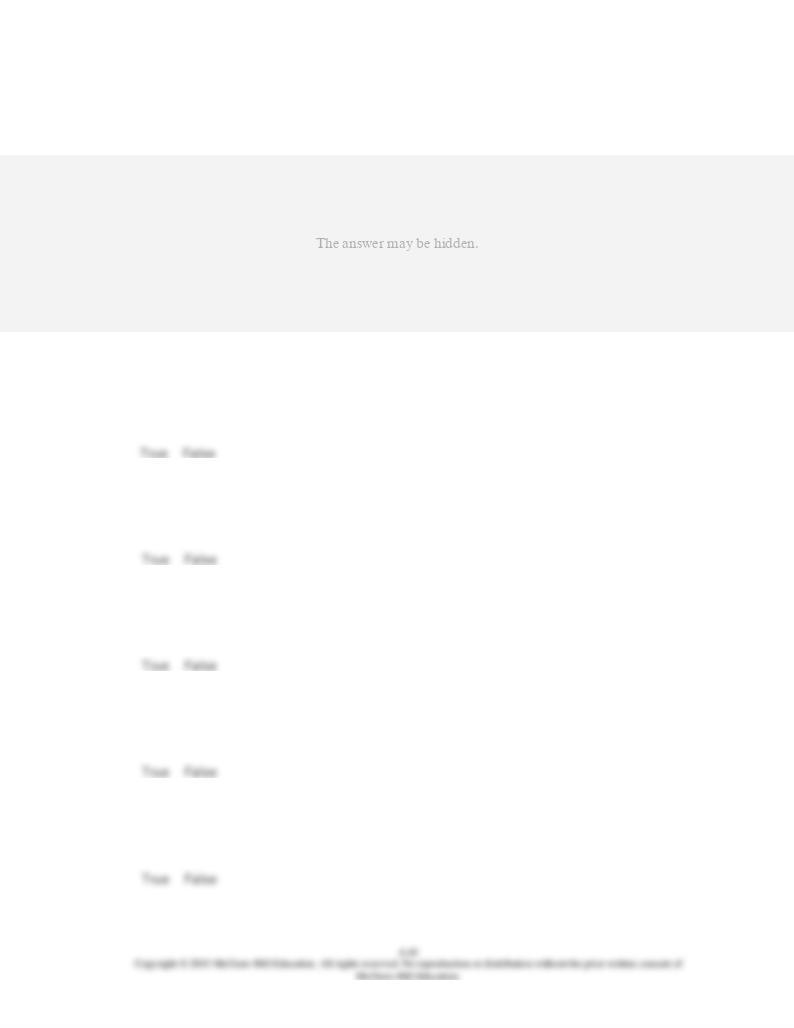
98.
Sometimes, public goods whose benefits are less than their costs still get produced because:
99.
Market failures refer to those situations where the sellers are not producing as much as the
buyers are wanting to buy.
100.
Demand-side market failures refer to those situations when there is a shortage in the market
because buyers want to buy more than what is available in the market.
101.
When a producer cannot get all consumers of their product to pay for enjoying it, such as in
the case of a fireworks display, then we'd have a demand-side market failure.
102.
Whenever there are supply-side market failures in the form of costs that suppliers do not
have to face, then there will be overproduction of the output.
103.
If the consumer is willing to pay a price higher than the actual price of a product, then the
consumer will not buy the product because the consumer surplus will be negative.
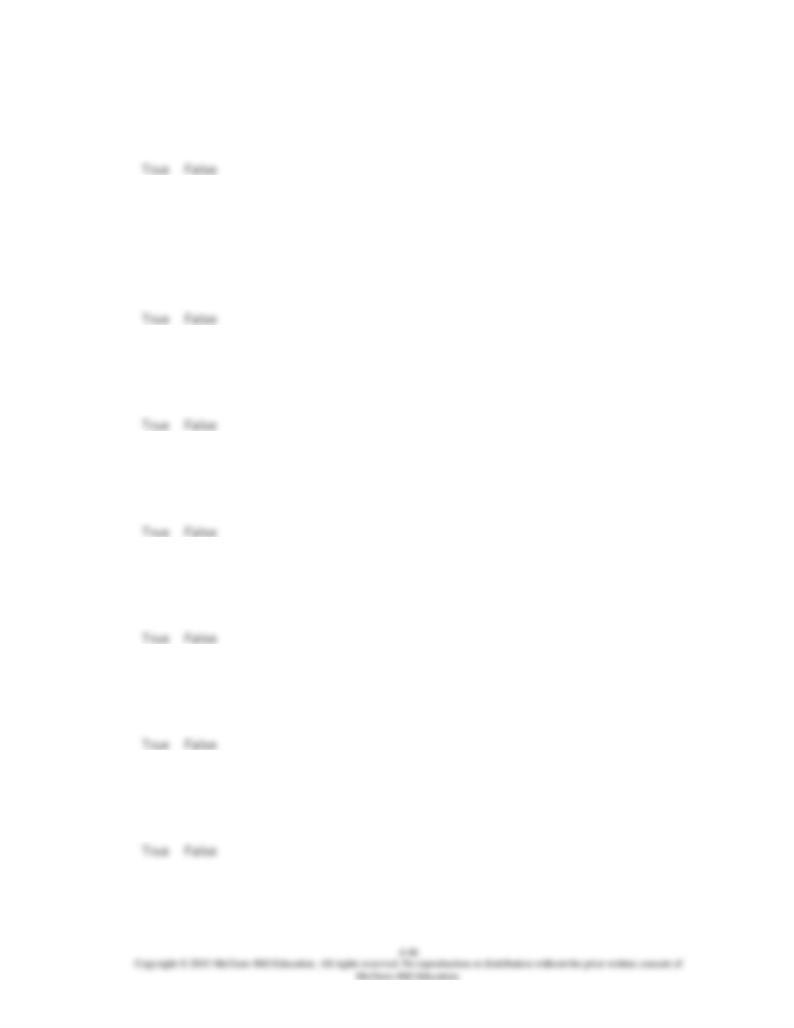
104.
Consumer surplus is the reason why sometimes a shopper regrets having bought a particular
item.
105.
Assume that there are four consumers A, B, C, and D, and the prices that each of them is
willing to pay for a glass of lemonade is, respectively, $1.50, $1.20, $1.00, and $0.90. If the
actual price of lemonade is $1.00 per glass, then consumer surplus in this market will be
$0.70.
106.
When the marginal benefits exceed the marginal costs of producing a product, then allocative
efficiency is not achieved in the market.
107.
When there is allocative efficiency in a market, the buyers' maximum willingness to pay for
the last unit traded is equal to the sellers' minimum acceptable price for that unit.
108.
When the total consumer and producer surplus is at a maximum, the deadweight loss in the
market is zero.
109.
Excludability means that when someone is consuming a good, then others are excluded from
using the good anymore.
110.
Nonrivalry in the use or consumption of a good means that only one person is consuming the
good without any rivals.
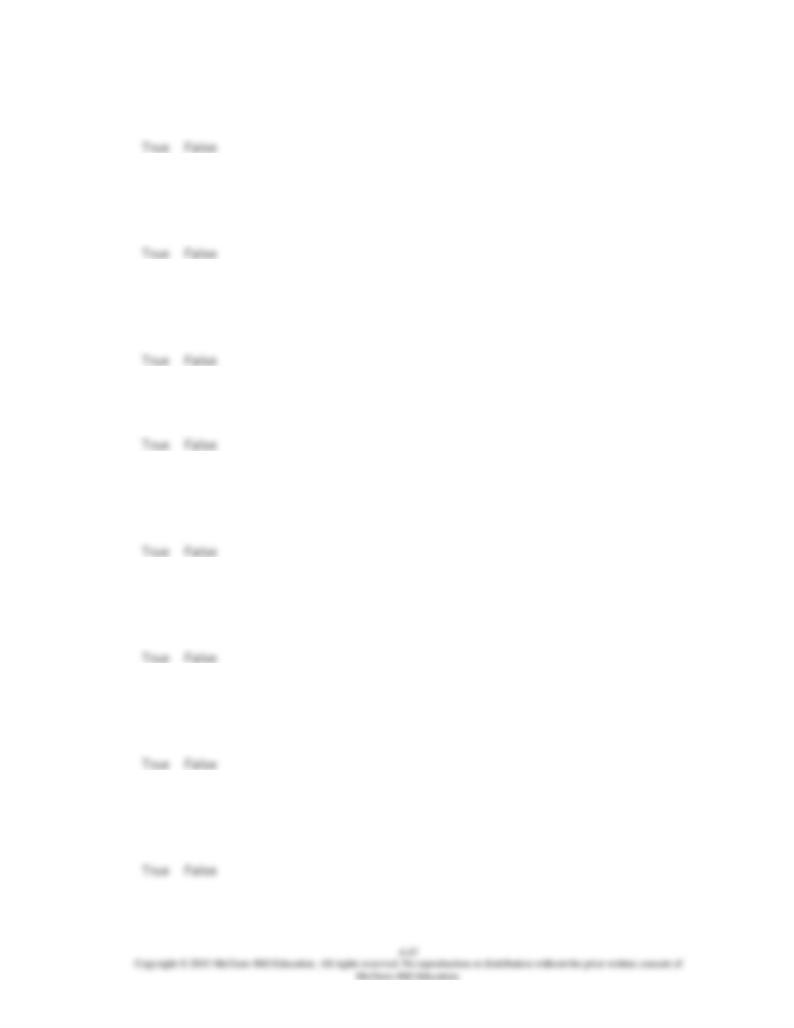
111.
The free-rider problem makes a good highly profitable for a private firm to provide.
112.
The free-rider problem refers to the local government's problem of finding funds to subsidize
public transportation.
113.
Rivalry means that when one person buys and consumes a product, it is not available for
purchase and consumption by another person.
114.
The government receives all of the benefits associated with the production of a public good.
115.
The optimal quantity of a public good is where the total benefits from it are equal to the total
costs of producing it.
116.
If car makers are required to install gadgets to improve the cleanliness of car-exhaust, we
would expect the equilibrium quantity in the car market to decrease.
117.
If the lumber companies are required to internalize the negative externalities of
deforestation, then we should expect the equilibrium price of wooden furniture to decrease.
118.
The Coase Theorem suggests that the government does not have to be involved at all in
resolving a market failure due to externalities.

119.
Production subsidies are a way of internalizing external costs among polluting firms.
120.
In dealing with market failures, the government always bases its decisions on economic
analysis of marginal cost and marginal benefit.
121.
An effective antipollution policy from the economic perspective requires that all pollution be
eliminated and banned.
122.
Because in any period of time and in any region the quantity of pollutants that can be
absorbed by nature is fixed, the supply of "pollution rights" in a cap-and-trade system will be
perfectly elastic.
123.
In a well-functioning "cap-and-trade system" for pollution rights, society benefits because
pollution will be brought down to insignificant levels.
124.
In a well-functioning cap-and-trade system for pollution rights, the right to pollute will go to
those who are able to acquire the largest net benefit from using the scarce resource "clean
air".
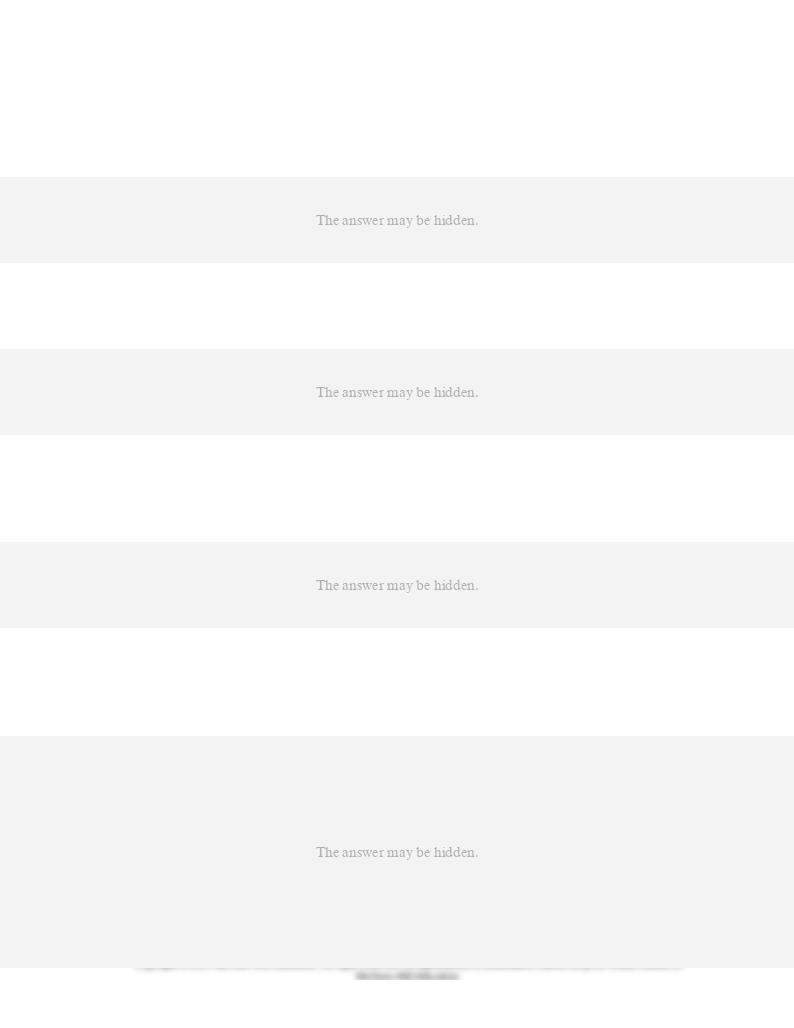
125.
Asymmetric information in a market transaction occurs when there is unequal knowledge
possessed by the:
126.
Which of the following does
not
illustrate the asymmetric information problem:
127.
If Congress decreases the amount of government insurance on bank deposits, then this
action would:
128.
When sellers are unable to distinguish "good" buyers from "bad" ones, they face the problem
of:

129.
The moral hazard problem arises primarily because of:
130.
Which of the following would be an example of government intervention to correct a market
failure caused by buyers having inadequate information about sellers?
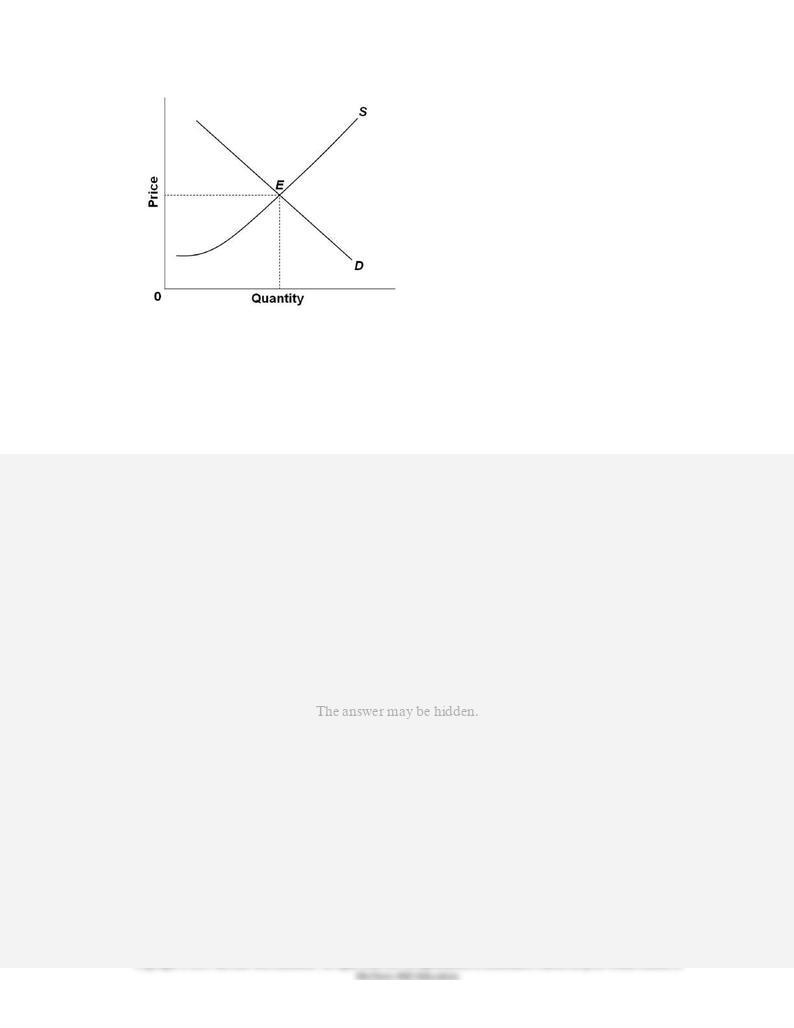
131.
Refer to the graph above. Suppose consumers do not know the safety risks associated with a
particular good, and that the free-market equilibrium is at E as shown in the diagram above.
If an independent agency now provides accurate information about the harmful
characteristics of the product, then:

132.
Refer to the graph above. Suppose consumers do not fully appreciate the benefits of the
product whose market shown in the graph. If an external agency is able to provide full
information about the benefits of the product, then:
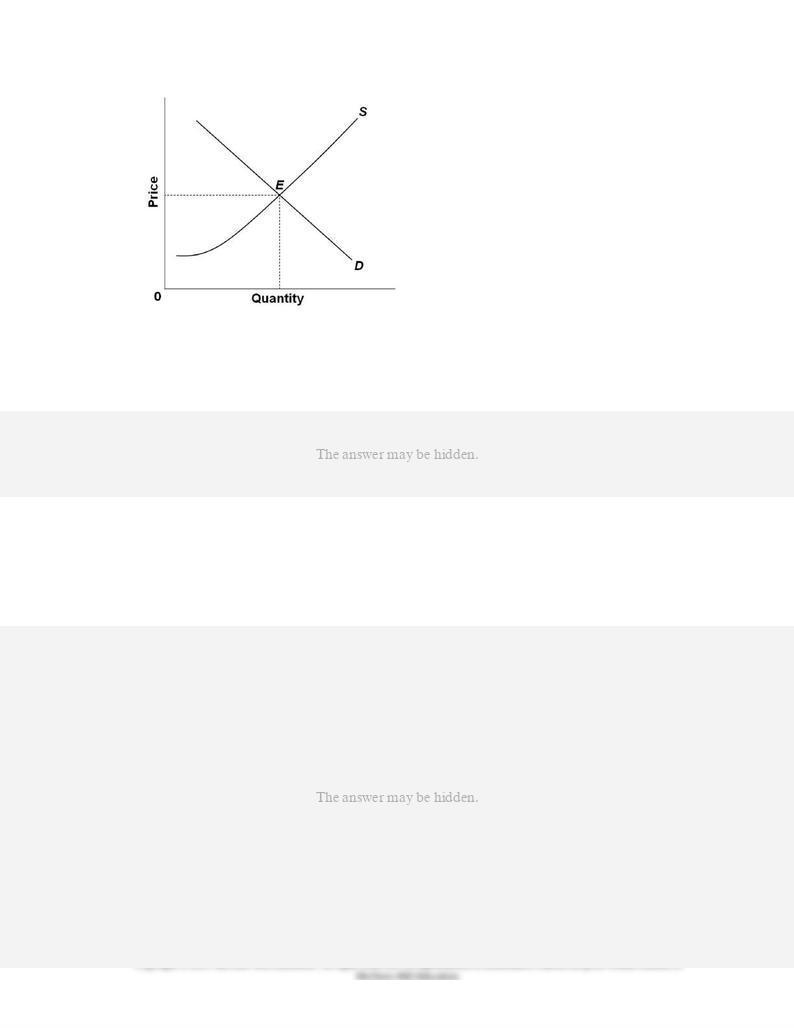
133.
Refer to the graph above. Suppose that it is shows the market for an insurance product. If
something happens to heighten the adverse selection problem in this market, then:
134.
The 2010 Health Care Reform Law, also known as "Obamacare", includes a part known as
universal coverage
which requires everyone to have health insurance. One reason for this is
to address the problem of:
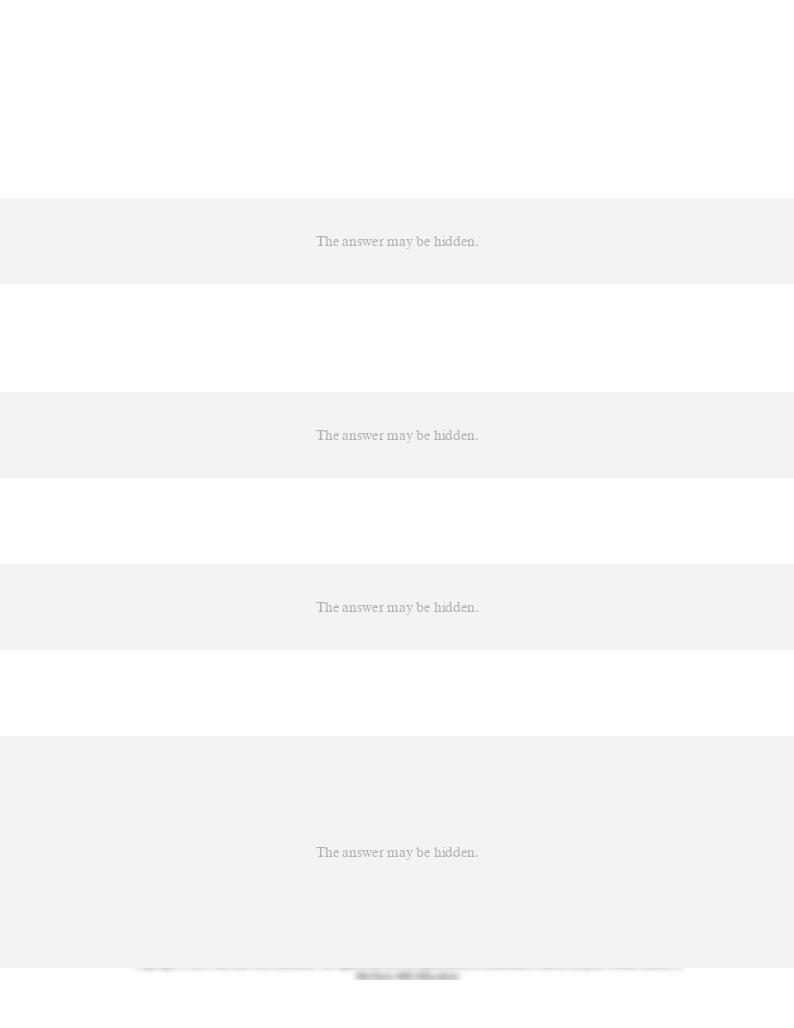
135.
The "too big to fail" policy of the Fed, whereby some banks are bailed out if they are in
danger of failing because they are too big and could bring the system down, leads to which of
the following problems?
136.
If a person drives with less care after purchasing auto insurance, this situation would be an
example of a(n):
137.
Which of the following would be an example of a moral hazard problem?
138.
Which of the following would be considered an example of adverse selection?
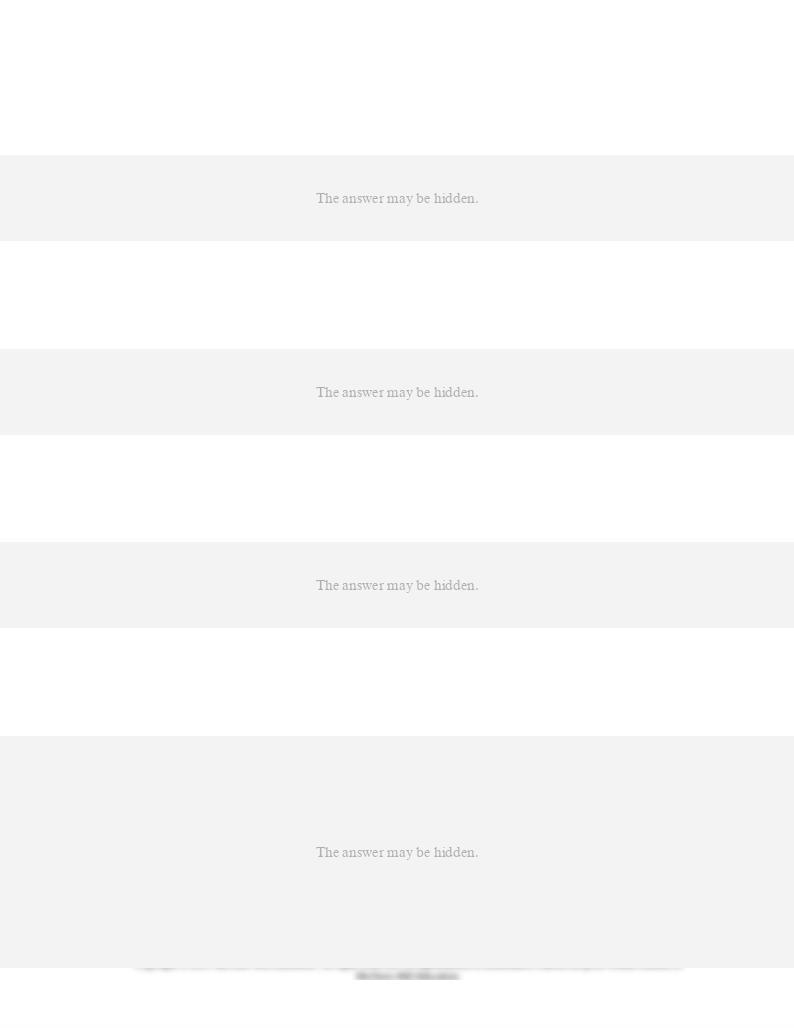
139.
The franchising of fast-food restaurants would be an example of how a private business:
140.
Insurance policies typically stipulate a deductible amount which the insured must shoulder;
this is to address the problem of:
141.
Depositors do not check their banks carefully for stability anymore, because of the Federal
deposit insurance program. This illustrates the problem of:
142.
E-bay, Amazon and other Internet shopping sites provide "seller ratings" done by previous
buyers, in order to help deal with the problem of:
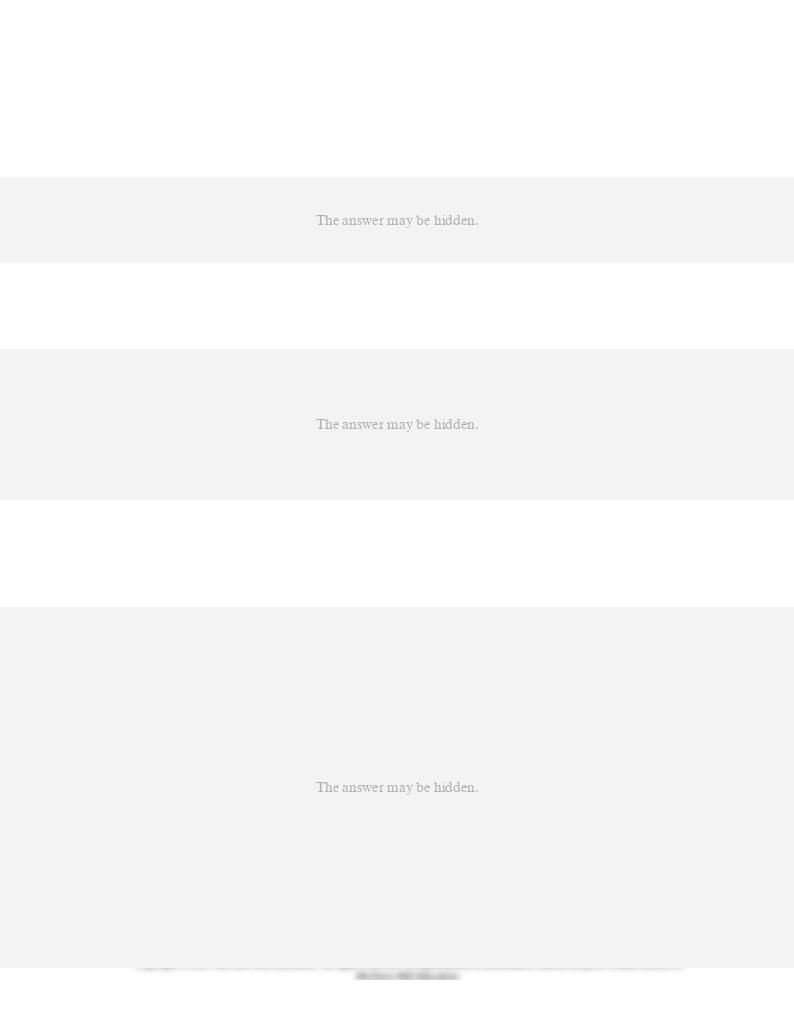
143.
Credit bureaus provide credit histories to banks and insurance companies, in order to help
deal with the problem of:
144.
There is an adverse selection problem in the market for used cars because:
145.
One consequence of the asymmetric-information problem in the used car market, if left
unresolved, is the higher probability of:
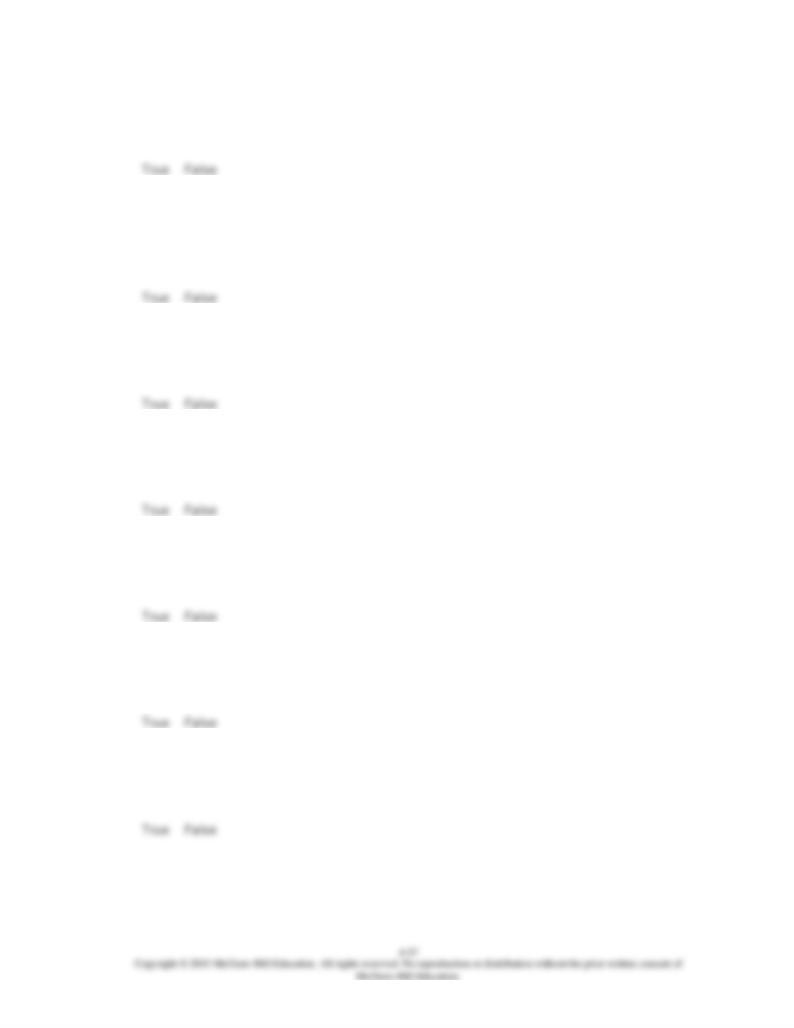
146.
Asymmetric information occurs when the two parties in a market transaction do not have the
same amount of information regarding the product or process involved in the transaction.
147.
The licensing and regulation of financial advisers is one way by which the government tries
to deal with the problem of inadequate information that financial firms about their
customers.
148.
Better Business Bureaus in various cities exist partly in order to try to deal with inadequate
buyer information about sellers.
149.
A moral hazard problem occurs before a transaction - when people alter their behavior before
they sign a contract, imposing costs on the other party.
150.
Adverse selection is when someone with home insurance decides to take the chance that a
dying tree would fall on the garage, rather than spend the money to have the tree cut down.
151.
When the government bails out large banks when the banks become unstable, it could lead
to a moral hazard problem.
152.
When the government bails out failing banks, it creates a moral hazard problem; but when
the government bails out homeowners who are defaulting, there is no moral hazard problem.

153.
When critics of unemployment insurance claim that some of the unemployed are not exerting
much effort to find jobs because of the unemployment benefits, they are referring to the
moral hazard problem.
154.
E-bay and Amazon provide "sellers' ratings" information based on the experiences of past
buyers. This is to help resolve the adverse selection problem faced by potential buyers.
155.
An example of an adverse selection problem is in insurance, where the people most likely to
claim insurance payouts are the people who will seek to buy the most generous policies.
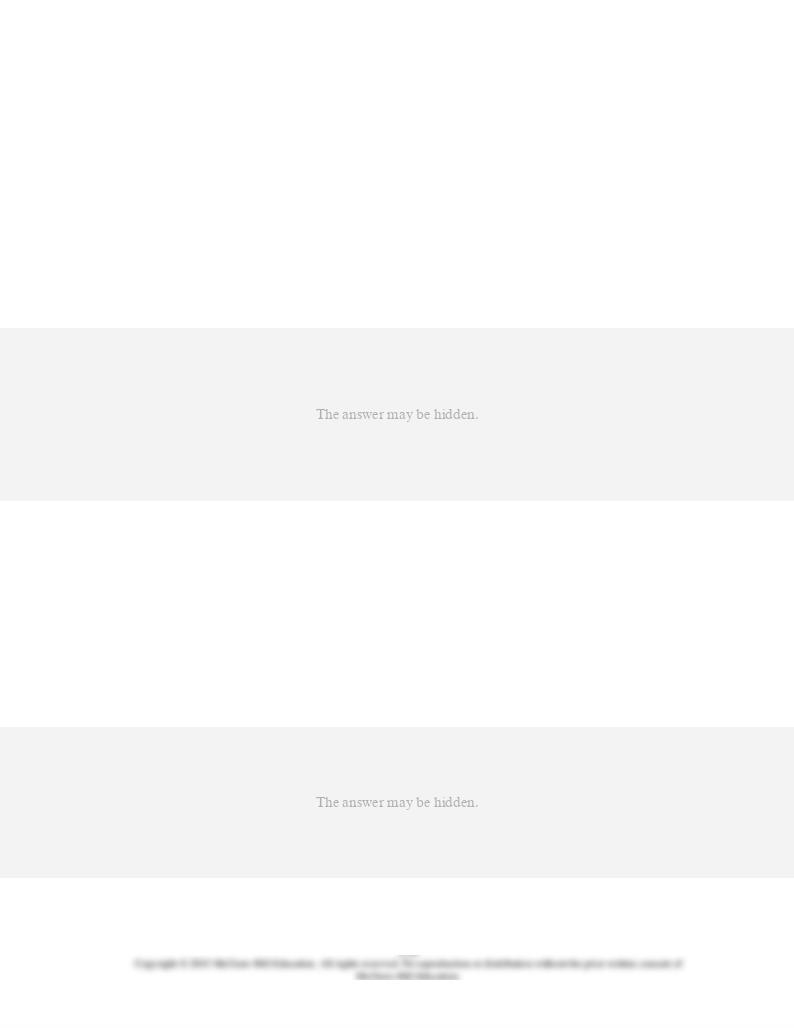
Chapter 04 Market Failures: Public Goods and Externalities Answer
Key
Multiple Choice Questions
1.
Which of the following is an example of a market failure?
AACSB: Communication
AACSB: Reflective Thinking
Accessibility: Keyboard Navigation
Blooms: Apply
Difficulty: 2 Medium
Learning Objective: 04-01 Differentiate between demand-side market failures and supply-side market failures.
Topic: Market Failures in Competitive Markets
2.
Which of the following situations is
not
an example of market failure:
AACSB: Analytic
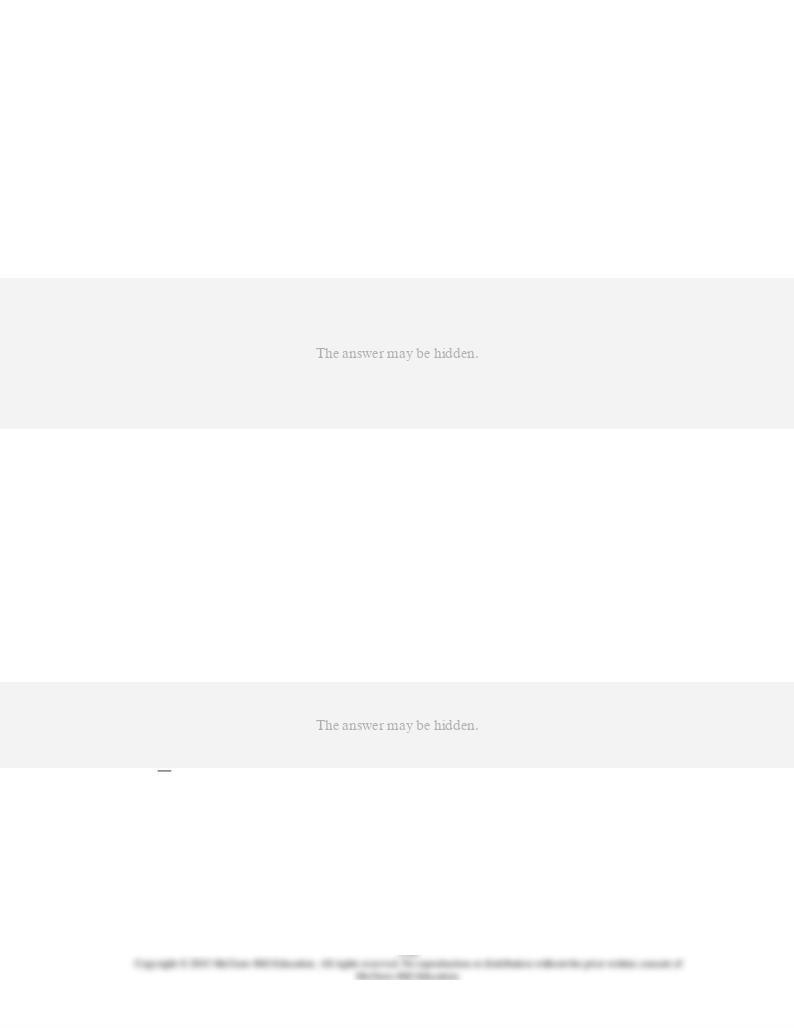
AACSB: Communication
Accessibility: Keyboard Navigation
Blooms: Understand
Difficulty: 2 Medium
Learning Objective: 04-01 Differentiate between demand-side market failures and supply-side market failures.
Topic: Market Failures in Competitive Markets
3.
Which of the following statements about market failure is
not
true:
AACSB: Analytic
Accessibility: Keyboard Navigation
Blooms: Understand
Difficulty: 2 Medium
Learning Objective: 04-01 Differentiate between demand-side market failures and supply-side market failures.
Topic: Market Failures in Competitive Markets
4.
If many people in a community get flu shots, the whole community benefits including
those that did not get flu shots. Therefore, not enough people may decide to get the shots.
This is one illustration of:
AACSB: Analytic
Accessibility: Keyboard Navigation
Blooms: Understand
Difficulty: 2 Medium
Learning Objective: 04-01 Differentiate between demand-side market failures and supply-side market failures.
Topic: Market Failures in Competitive Markets
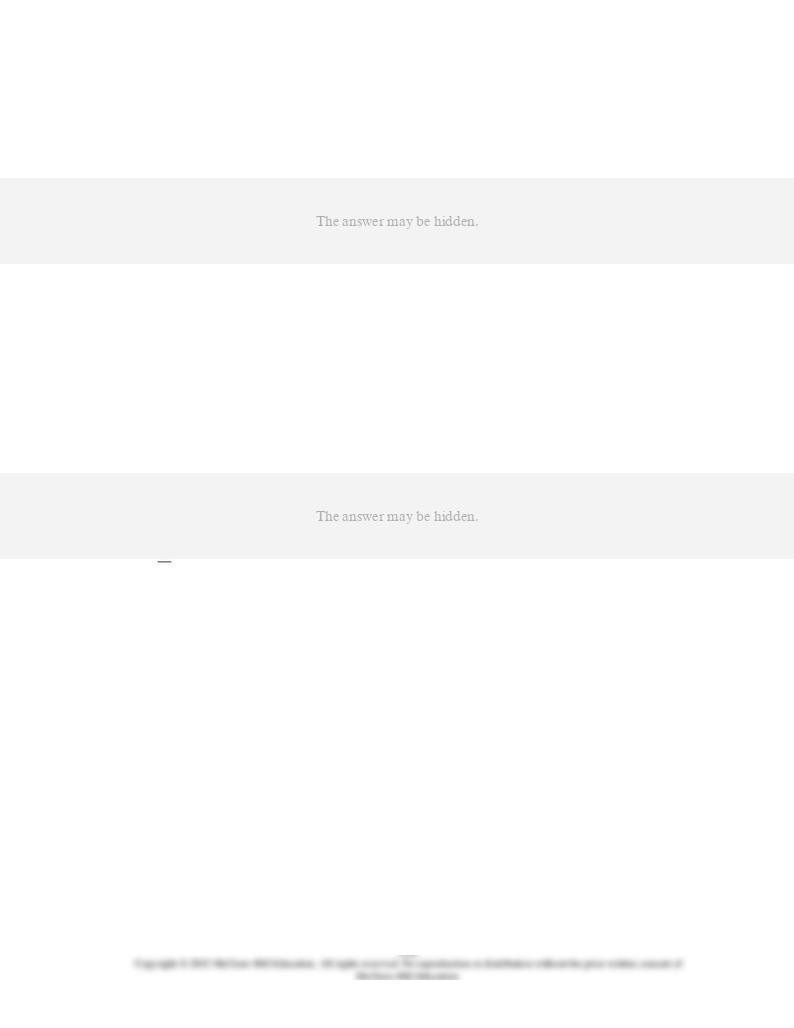
5.
When producers do not produce the efficient amount of a product because they are unable
to charge consumers what they are willing to pay for it, then we have a:
AACSB: Analytic
Accessibility: Keyboard Navigation
Blooms: Remember
Difficulty: 1 Easy
Learning Objective: 04-01 Differentiate between demand-side market failures and supply-side market failures.
Topic: Market Failures in Competitive Markets
6.
When producers do not have to pay the full cost of producing a product, they tend to:
AACSB: Analytic
Accessibility: Keyboard Navigation
Blooms: Understand
Difficulty: 2 Medium
Learning Objective: 04-01 Differentiate between demand-side market failures and supply-side market failures.
Topic: Market Failures in Competitive Markets
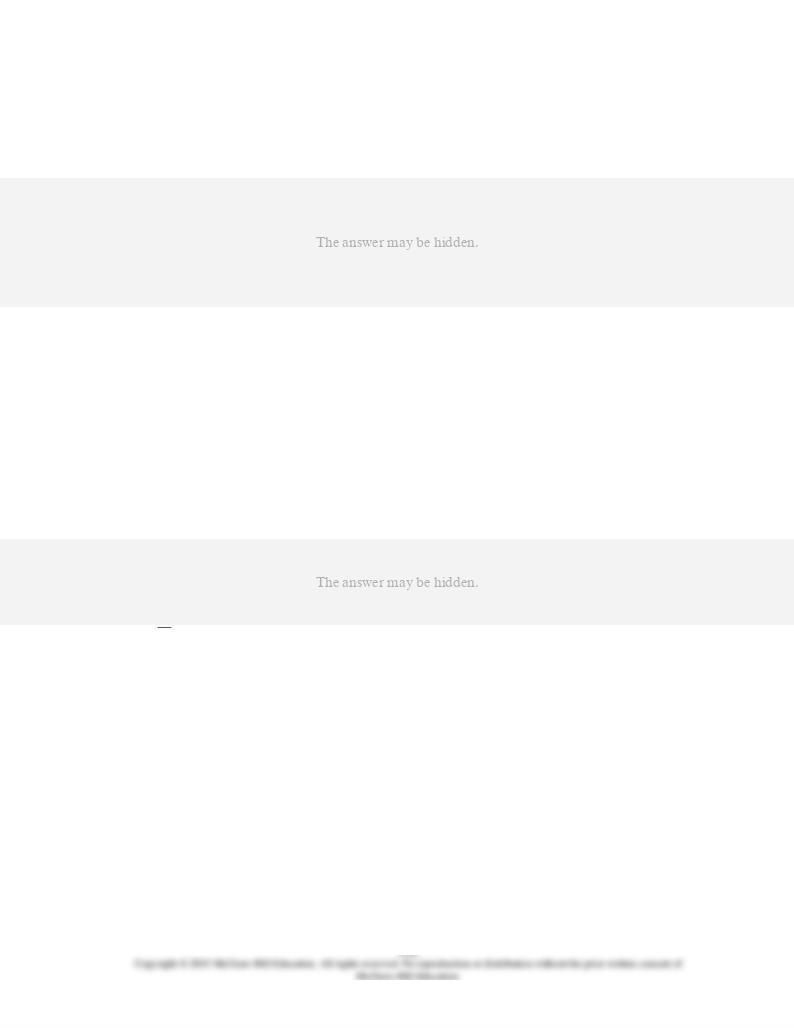
7.
When producers (say, of roads) are not able to make all consumers pay for enjoying their
product (i.e., the roads), they tend to see a:
AACSB: Reflective Thinking
Accessibility: Keyboard Navigation
Blooms: Understand
Difficulty: 2 Medium
Learning Objective: 04-01 Differentiate between demand-side market failures and supply-side market failures.
Topic: Market Failures in Competitive Markets
8.
A competitive market can produce economically efficient outcomes if these conditions are
met,
except
:
AACSB: Analytic
Accessibility: Keyboard Navigation
Blooms: Understand
Difficulty: 2 Medium
Learning Objective: 04-02 Explain the origin of both consumer surplus and producer surplus; and explain how properly
functioning markets maximize their sum; total surplus; while optimally allocating resources.
Topic: Efficiently Functioning Markets
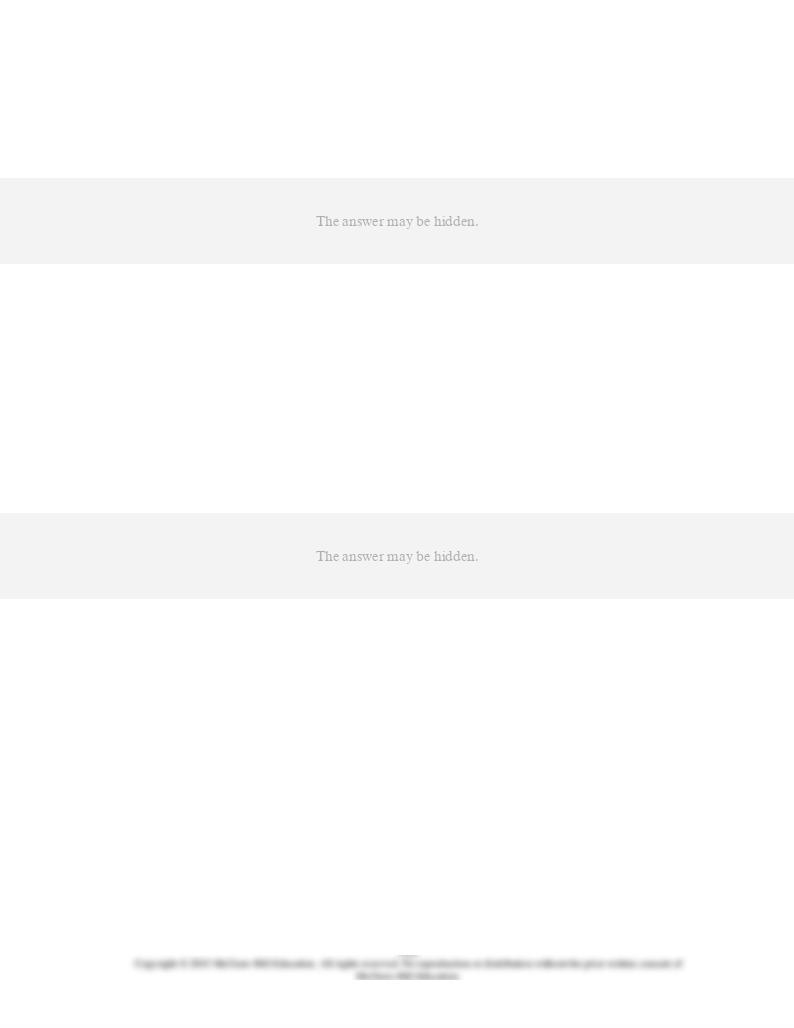
9.
The difference between the maximum price a consumer is willing to pay for a product and
the actual price the consumer pays is called:
AACSB: Communication
Accessibility: Keyboard Navigation
Blooms: Remember
Difficulty: 1 Easy
Learning Objective: 04-02 Explain the origin of both consumer surplus and producer surplus; and explain how properly
functioning markets maximize their sum; total surplus; while optimally allocating resources.
Topic: Efficiently Functioning Markets
10.
The value that consumers get (from consuming a product) over and above that they
actually paid for the product is called:
AACSB: Communication
AACSB: Reflective Thinking
Accessibility: Keyboard Navigation
Blooms: Remember
Difficulty: 1 Easy
Learning Objective: 04-02 Explain the origin of both consumer surplus and producer surplus; and explain how properly
functioning markets maximize their sum; total surplus; while optimally allocating resources.
Topic: Efficiently Functioning Markets
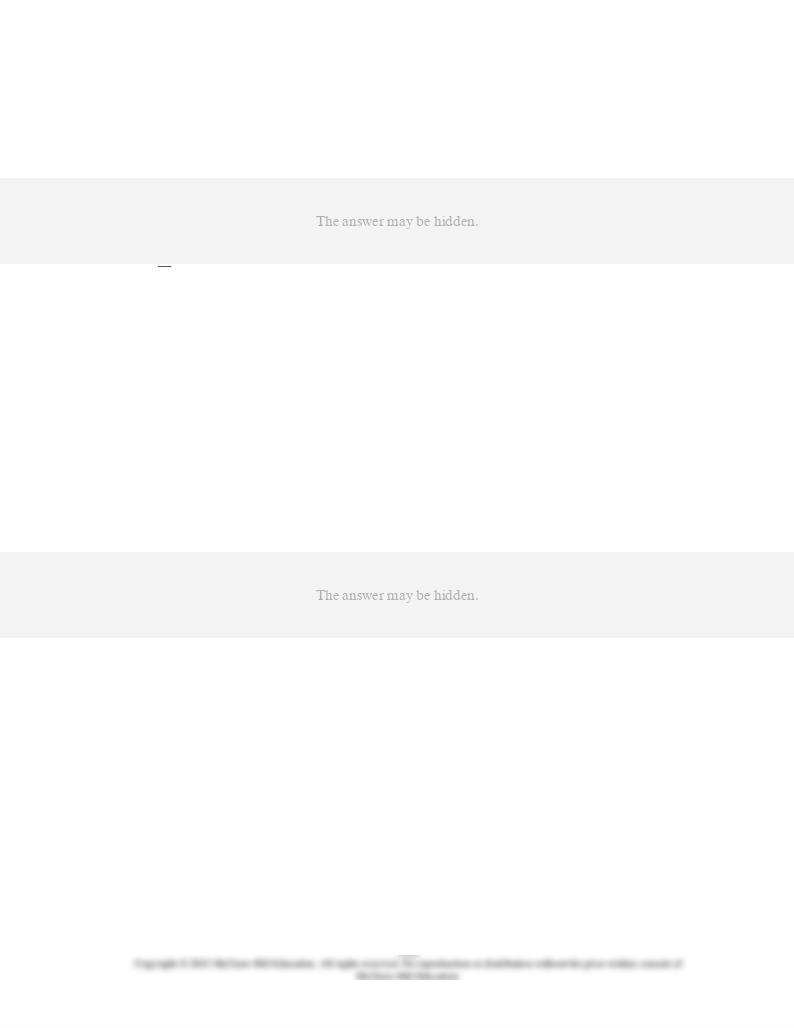
11.
Charlie is willing to pay $10 for a T-shirt that is priced at $9. If Charlie buys the T-shirt,
then his consumer surplus is
AACSB: Analytic
AACSB: Communication
Accessibility: Keyboard Navigation
Blooms: Understand
Difficulty: 1 Easy
Learning Objective: 04-02 Explain the origin of both consumer surplus and producer surplus; and explain how properly
functioning markets maximize their sum; total surplus; while optimally allocating resources.
Topic: Efficiently Functioning Markets
12.
In the market for a particular pair of shoes, Jena is willing to pay $75 for a pair while Jane
is willing to pay $85 for a pair. The actual price that each has to pay for a pair of shoes is
$65. What is the combined amount of consumer surplus of Jena and Jane?
AACSB: Analytic
Accessibility: Keyboard Navigation
Blooms: Apply
Difficulty: 2 Medium
Learning Objective: 04-02 Explain the origin of both consumer surplus and producer surplus; and explain how properly
functioning markets maximize their sum; total surplus; while optimally allocating resources.
Topic: Efficiently Functioning Markets
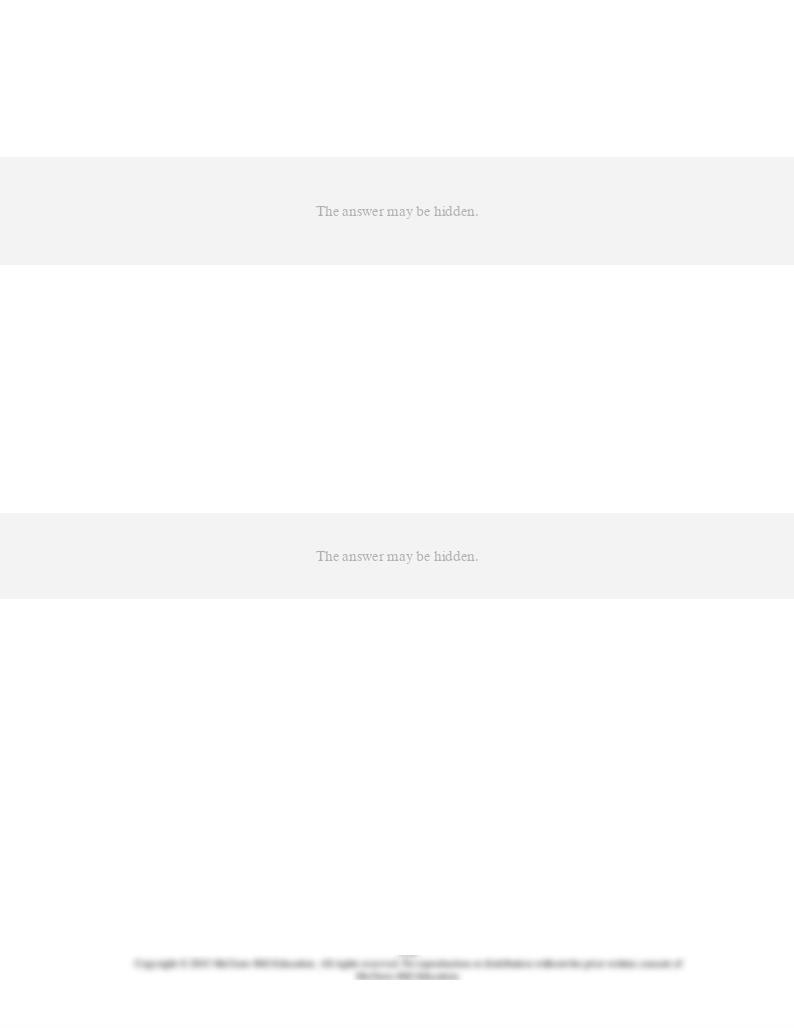
13.
Consumer surplus arises in a market because:
AACSB: Analytic
Accessibility: Keyboard Navigation
Blooms: Remember
Difficulty: 1 Easy
Learning Objective: 04-02 Explain the origin of both consumer surplus and producer surplus; and explain how properly
functioning markets maximize their sum; total surplus; while optimally allocating resources.
Topic: Efficiently Functioning Markets
14.
If the unit price of a product is P, then the amount of spending that the buyers would need
to pay for a given quantity Q is equal to:
AACSB: Analytic
Accessibility: Keyboard Navigation
Blooms: Remember
Difficulty: 1 Easy
Learning Objective: 04-02 Explain the origin of both consumer surplus and producer surplus; and explain how properly
functioning markets maximize their sum; total surplus; while optimally allocating resources.
Topic: Efficiently Functioning Markets
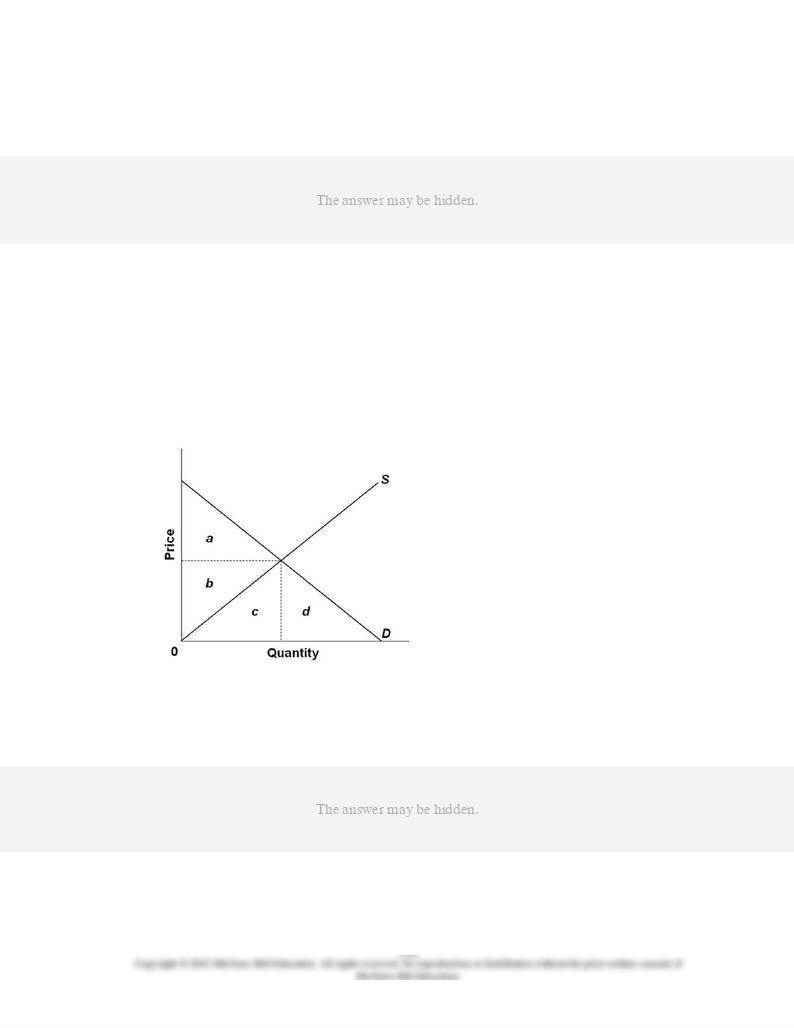
15.
If the price of a product increases:
AACSB: Analytic
Accessibility: Keyboard Navigation
Blooms: Understand
Difficulty: 2 Medium
Learning Objective: 04-02 Explain the origin of both consumer surplus and producer surplus; and explain how properly
functioning markets maximize their sum; total surplus; while optimally allocating resources.
Topic: Efficiently Functioning Markets
16.
The equilibrium point in the market is where S and D curve intersect.
Refer to the graph above. At equilibrium, consumer surplus would be represented by the
area:
AACSB: Analytic
Blooms: Understand
Difficulty: 2 Medium

Learning Objective: 04-02 Explain the origin of both consumer surplus and producer surplus; and explain how properly
functioning markets maximize their sum; total surplus; while optimally allocating resources.
Topic: Efficiently Functioning Markets
17.
The equilibrium point in the market is where S and D curve intersect.
Refer to the graph above. At equilibrium, the total amount of spending that consumers
would be paying for the product is represented by the area:
AACSB: Analytic
Blooms: Understand
Difficulty: 2 Medium
Learning Objective: 04-02 Explain the origin of both consumer surplus and producer surplus; and explain how properly
functioning markets maximize their sum; total surplus; while optimally allocating resources.
Topic: Efficiently Functioning Markets
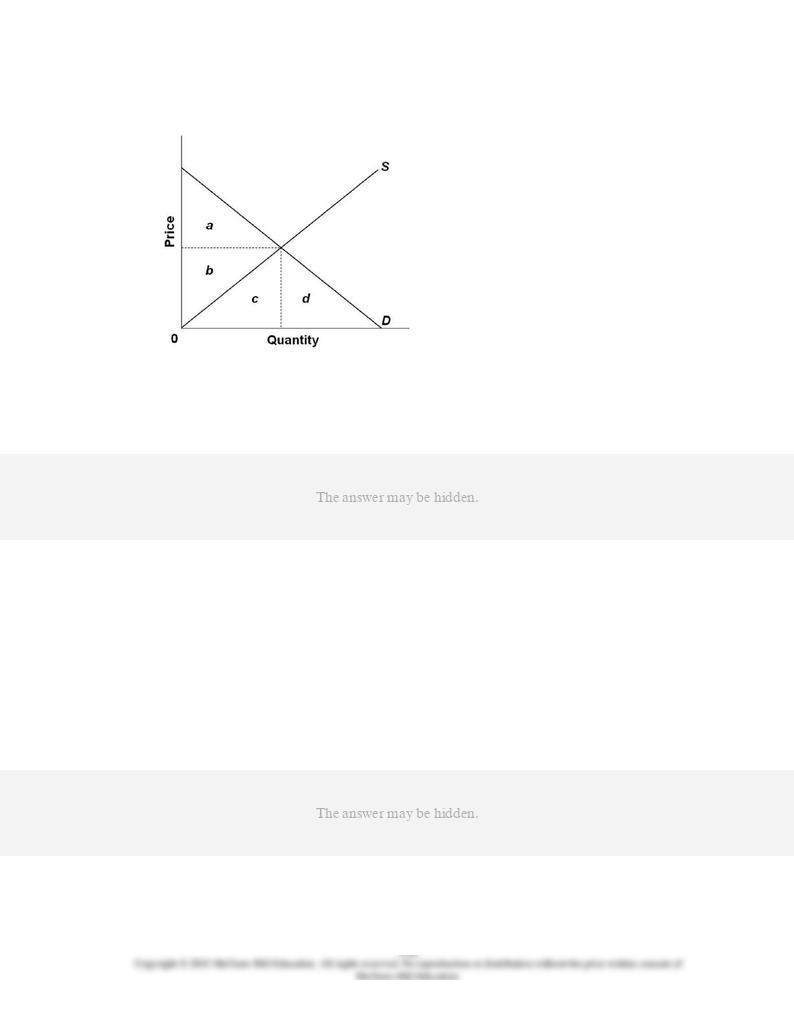
18.
The equilibrium point in the market is where S and D curve intersect.
Refer to the graph above. At equilibrium, the total maximum amount that consumers would
have been willing to pay for the product is represented by the area:
AACSB: Analytic
Blooms: Understand
Difficulty: 2 Medium
Learning Objective: 04-02 Explain the origin of both consumer surplus and producer surplus; and explain how properly
functioning markets maximize their sum; total surplus; while optimally allocating resources.
Topic: Efficiently Functioning Markets
19.
The difference between the actual price that a producer receives and the minimum
acceptable price the producer is willing to accept is called the producer:
AACSB: Communication
Accessibility: Keyboard Navigation
Blooms: Remember

Difficulty: 1 Easy
Learning Objective: 04-02 Explain the origin of both consumer surplus and producer surplus; and explain how properly
functioning markets maximize their sum; total surplus; while optimally allocating resources.
Topic: Efficiently Functioning Markets
20.
The minimum acceptable price for a product that producer Sam is willing to receive is $15.
The price he could get for the product in the market is $18. How much is Sam's producer
surplus?
AACSB: Analytic
Accessibility: Keyboard Navigation
Blooms: Remember
Difficulty: 1 Easy
Learning Objective: 04-02 Explain the origin of both consumer surplus and producer surplus; and explain how properly
functioning markets maximize their sum; total surplus; while optimally allocating resources.
Topic: Efficiently Functioning Markets
21.
The amount of revenues that sellers actually receive over and above the minimum
acceptable amount that they are willing to receive for selling a product is called:
AACSB: Analytic
AACSB: Communication
Accessibility: Keyboard Navigation
Blooms: Understand
Difficulty: 2 Medium
Learning Objective: 04-02 Explain the origin of both consumer surplus and producer surplus; and explain how properly
functioning markets maximize their sum; total surplus; while optimally allocating resources.
Topic: Efficiently Functioning Markets
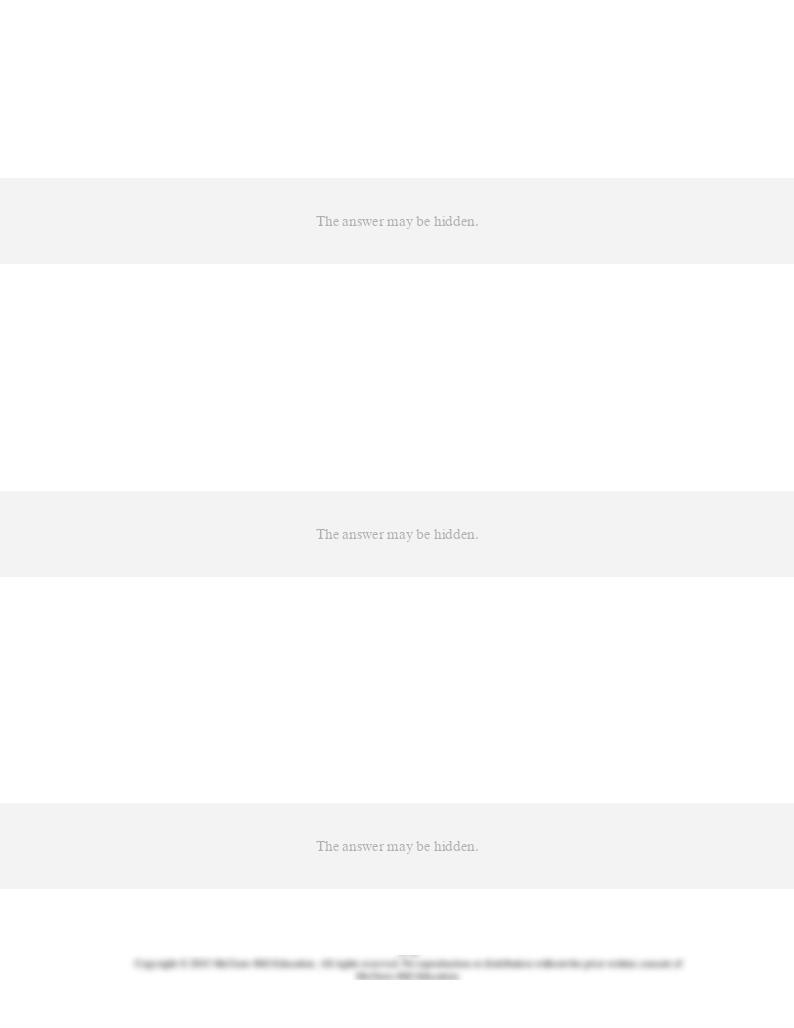
22.
If the unit price of a product is P and buyers buy a given quantity Q, then sellers would
collect total revenues equal to:
AACSB: Analytic
Accessibility: Keyboard Navigation
Blooms: Remember
Difficulty: 1 Easy
Learning Objective: 04-02 Explain the origin of both consumer surplus and producer surplus; and explain how properly
functioning markets maximize their sum; total surplus; while optimally allocating resources.
Topic: Efficiently Functioning Markets
23.
The market supply curve indicates the:
AACSB: Analytic
Accessibility: Keyboard Navigation
Blooms: Remember
Difficulty: 1 Easy
Learning Objective: 04-02 Explain the origin of both consumer surplus and producer surplus; and explain how properly
functioning markets maximize their sum; total surplus; while optimally allocating resources.
Topic: Efficiently Functioning Markets
24.
At equilibrium in a market for a product, the total revenues received by sellers equal the:
AACSB: Communication
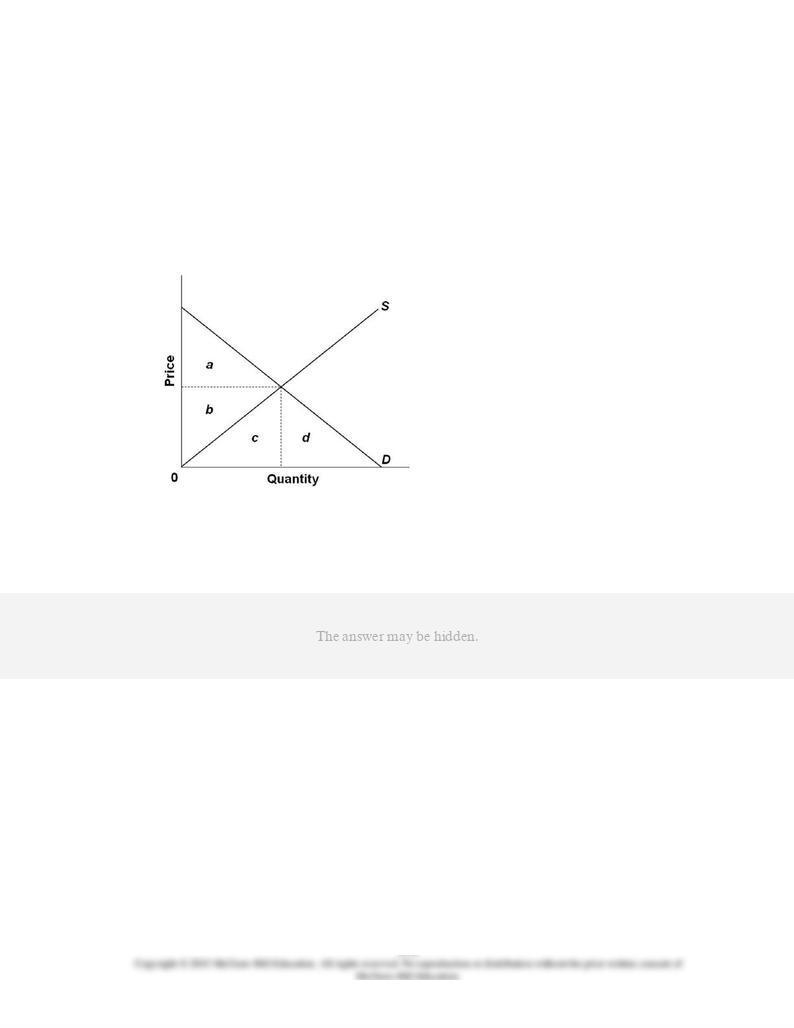
AACSB: Reflective Thinking
Accessibility: Keyboard Navigation
Blooms: Understand
Difficulty: 2 Medium
Learning Objective: 04-02 Explain the origin of both consumer surplus and producer surplus; and explain how properly
functioning markets maximize their sum; total surplus; while optimally allocating resources.
Topic: Efficiently Functioning Markets
25.
The equilibrium point in the market is where S and D curve intersect.
Refer to the graph above. At equilibrium, the producer surplus would be represented by
the area:
AACSB: Analytic
Blooms: Understand
Difficulty: 2 Medium
Learning Objective: 04-02 Explain the origin of both consumer surplus and producer surplus; and explain how properly
functioning markets maximize their sum; total surplus; while optimally allocating resources.
Topic: Efficiently Functioning Markets
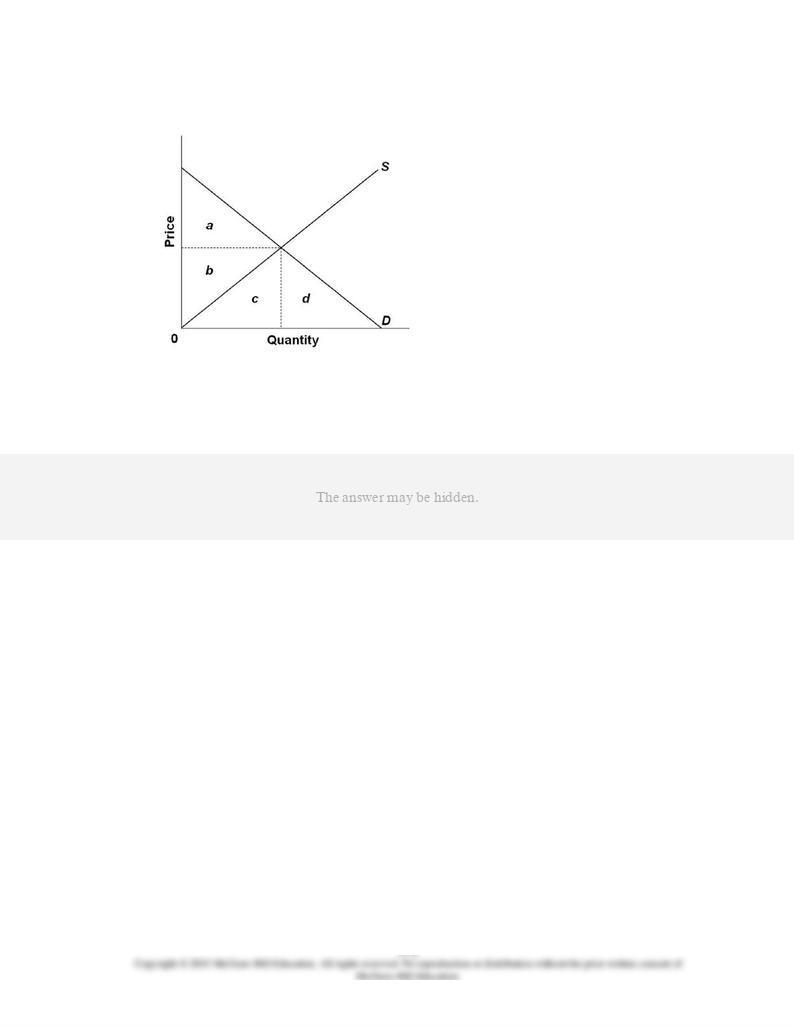
26.
The equilibrium point in the market is where S and D curve intersect.
Refer to the graph above. At equilibrium, the total revenues received by sellers would be
represented by the area:
AACSB: Analytic
Blooms: Understand
Difficulty: 2 Medium
Learning Objective: 04-02 Explain the origin of both consumer surplus and producer surplus; and explain how properly
functioning markets maximize their sum; total surplus; while optimally allocating resources.
Topic: Efficiently Functioning Markets
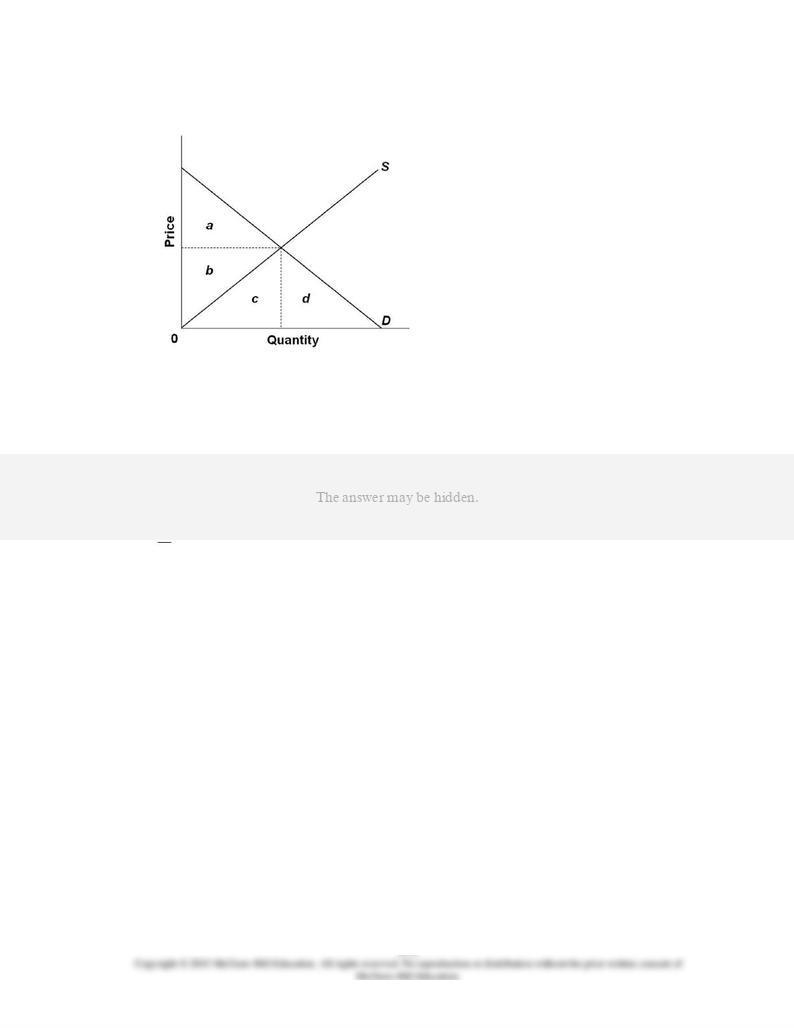
27.
The equilibrium point in the market is where S and D curve intersect.
Refer to the graph above. At equilibrium, the minimum acceptable revenue that sellers
would have been willing to receive is represented by the area:
AACSB: Analytic
Blooms: Apply
Difficulty: 3 Hard
Learning Objective: 04-02 Explain the origin of both consumer surplus and producer surplus; and explain how properly
functioning markets maximize their sum; total surplus; while optimally allocating resources.
Topic: Efficiently Functioning Markets
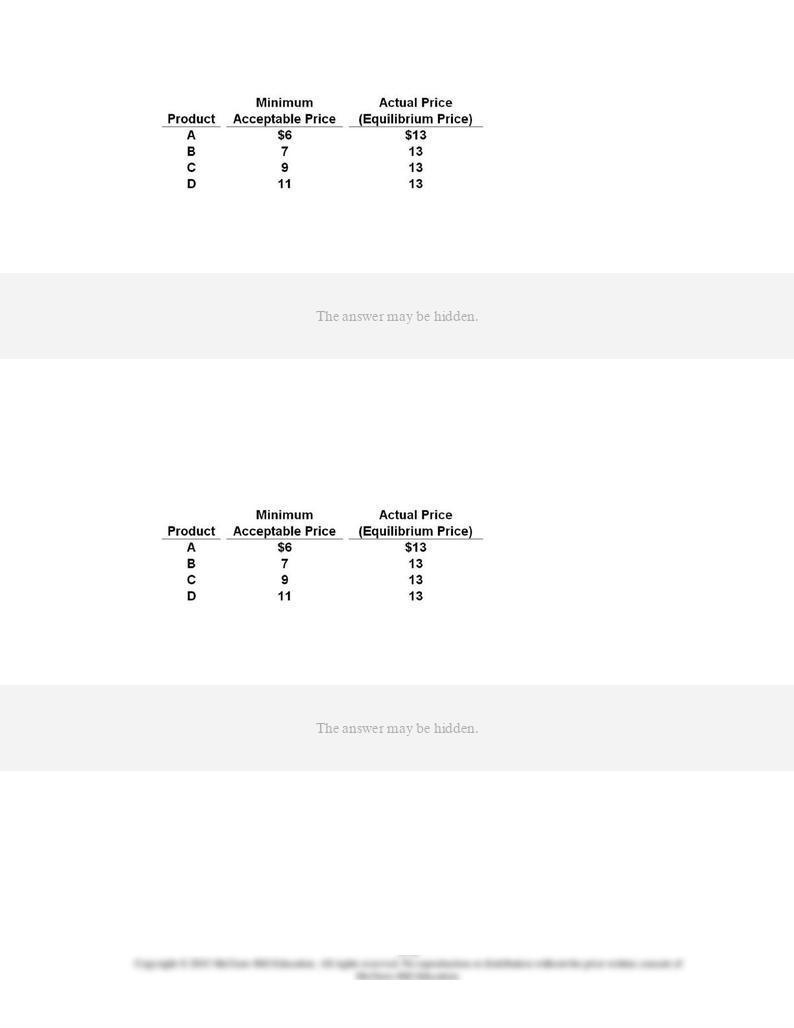
28.
Refer to the above table. The producer surplus is $4 for producer:
AACSB: Analytic
Blooms: Understand
Difficulty: 2 Medium
Learning Objective: 04-02 Explain the origin of both consumer surplus and producer surplus; and explain how properly
functioning markets maximize their sum; total surplus; while optimally allocating resources.
Topic: Efficiently Functioning Markets
29.
Refer to the above table. What is the producer surplus for all producers A, B, C, and D?
AACSB: Analytic
Blooms: Apply
Difficulty: 2 Medium
Learning Objective: 04-02 Explain the origin of both consumer surplus and producer surplus; and explain how properly
functioning markets maximize their sum; total surplus; while optimally allocating resources.
Topic: Efficiently Functioning Markets

30.
Refer to the above table. If the equilibrium price increases, then the:
AACSB: Analytic
Blooms: Apply
Difficulty: 2 Medium
Learning Objective: 04-02 Explain the origin of both consumer surplus and producer surplus; and explain how properly
functioning markets maximize their sum; total surplus; while optimally allocating resources.
Topic: Efficiently Functioning Markets
31.
When economic efficiency is attained, it implies all of the following,
except
:
AACSB: Analytic
Accessibility: Keyboard Navigation
Blooms: Understand
Difficulty: 2 Medium
Learning Objective: 04-02 Explain the origin of both consumer surplus and producer surplus; and explain how properly
functioning markets maximize their sum; total surplus; while optimally allocating resources.
Topic: Efficiently Functioning Markets
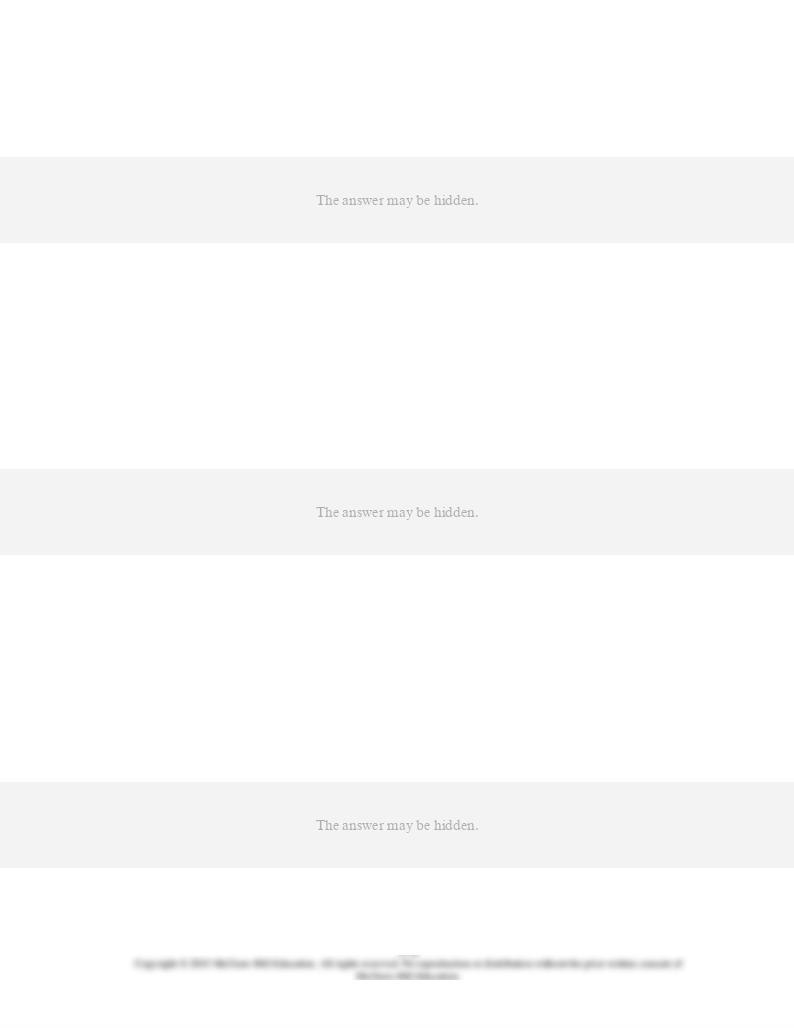
32.
When a competitive market achieves allocative efficiency, it implies that:
AACSB: Analytic
Accessibility: Keyboard Navigation
Blooms: Understand
Difficulty: 2 Medium
Learning Objective: 04-02 Explain the origin of both consumer surplus and producer surplus; and explain how properly
functioning markets maximize their sum; total surplus; while optimally allocating resources.
Topic: Efficiently Functioning Markets
33.
Deadweight losses occur when the quantity of an output produced is:
AACSB: Analytic
Accessibility: Keyboard Navigation
Blooms: Understand
Difficulty: 2 Medium
Learning Objective: 04-02 Explain the origin of both consumer surplus and producer surplus; and explain how properly
functioning markets maximize their sum; total surplus; while optimally allocating resources.
Topic: Efficiently Functioning Markets
34.
When there is overproduction of a good:
AACSB: Analytic
Accessibility: Keyboard Navigation
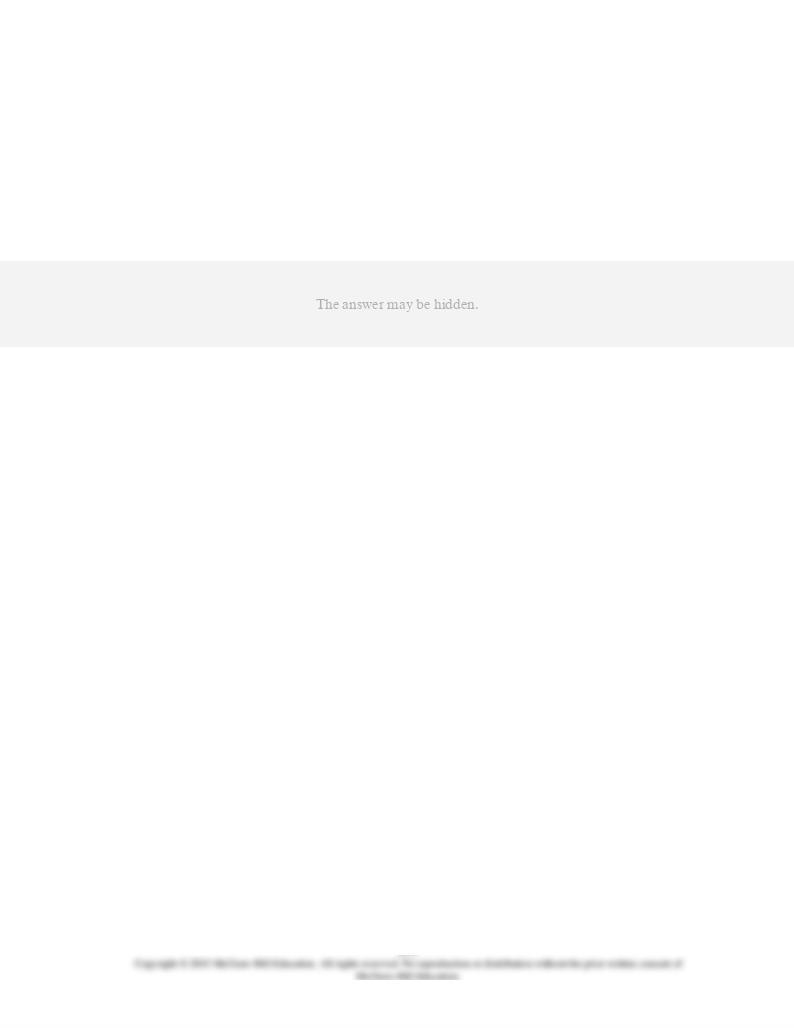
Blooms: Understand
Difficulty: 2 Medium
Learning Objective: 04-02 Explain the origin of both consumer surplus and producer surplus; and explain how properly
functioning markets maximize their sum; total surplus; while optimally allocating resources.
Topic: Efficiently Functioning Markets
35.
When the marginal benefit of an output exceeds the marginal cost:
AACSB: Analytic
Accessibility: Keyboard Navigation
Blooms: Understand
Difficulty: 2 Medium
Learning Objective: 04-02 Explain the origin of both consumer surplus and producer surplus; and explain how properly
functioning markets maximize their sum; total surplus; while optimally allocating resources.
Topic: Efficiently Functioning Markets

36.
Refer to the above graph. If the output level is Q2, then there will be:
AACSB: Analytic
Blooms: Understand
Difficulty: 2 Medium
Learning Objective: 04-02 Explain the origin of both consumer surplus and producer surplus; and explain how properly
functioning markets maximize their sum; total surplus; while optimally allocating resources.
Topic: Efficiently Functioning Markets
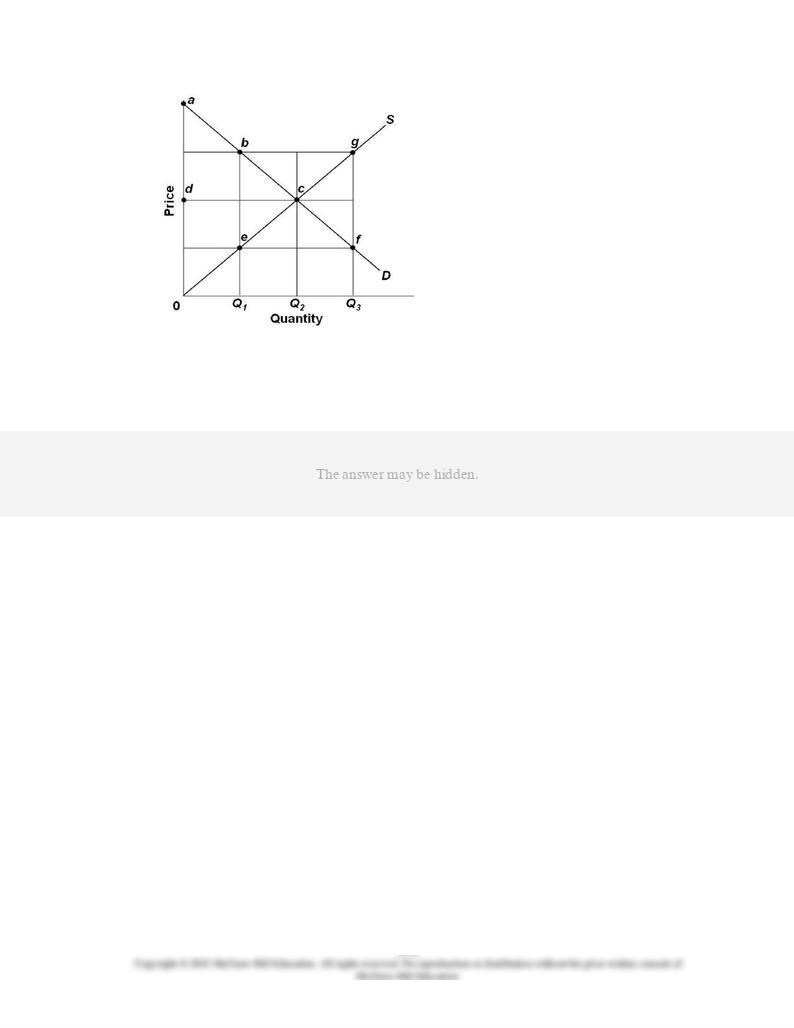
37.
Refer to the above graph. If the output level is Q1, then there are efficiency losses
indicated by the area:
AACSB: Analytic
Blooms: Remember
Difficulty: 2 Medium
Learning Objective: 04-02 Explain the origin of both consumer surplus and producer surplus; and explain how properly
functioning markets maximize their sum; total surplus; while optimally allocating resources.
Topic: Efficiently Functioning Markets
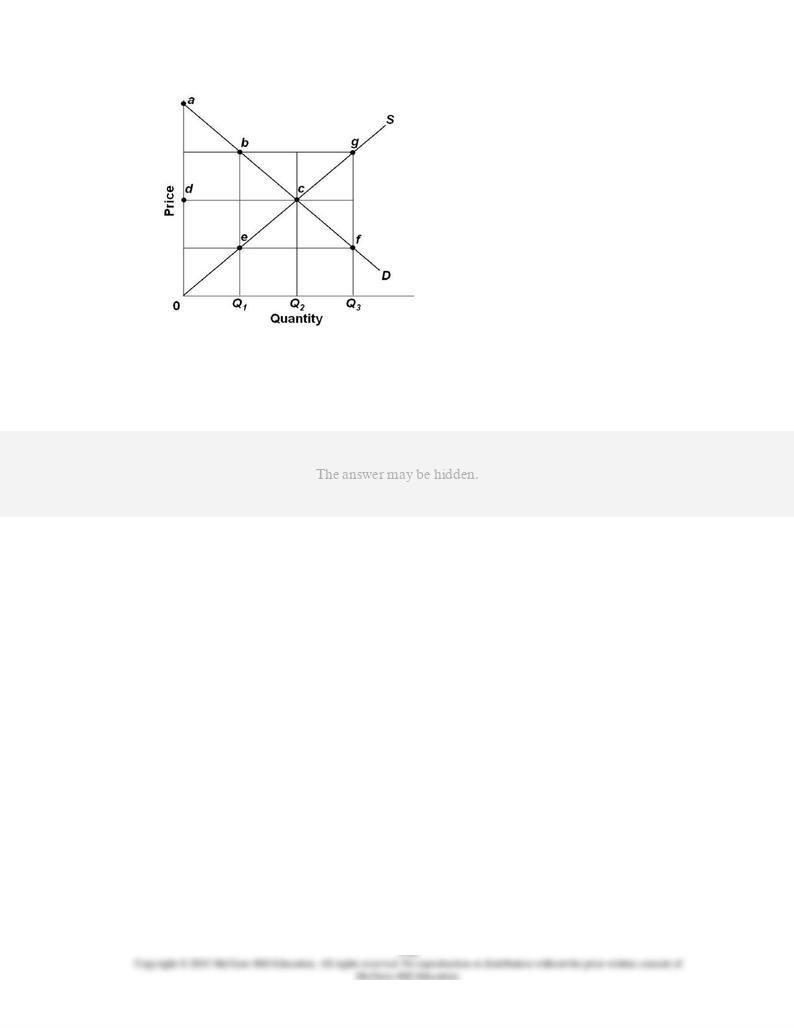
38.
Refer to the above graph. If the output level is Q1, then the sum of the consumer and
producer surplus is:
AACSB: Analytic
Blooms: Remember
Difficulty: 2 Medium
Learning Objective: 04-02 Explain the origin of both consumer surplus and producer surplus; and explain how properly
functioning markets maximize their sum; total surplus; while optimally allocating resources.
Topic: Efficiently Functioning Markets
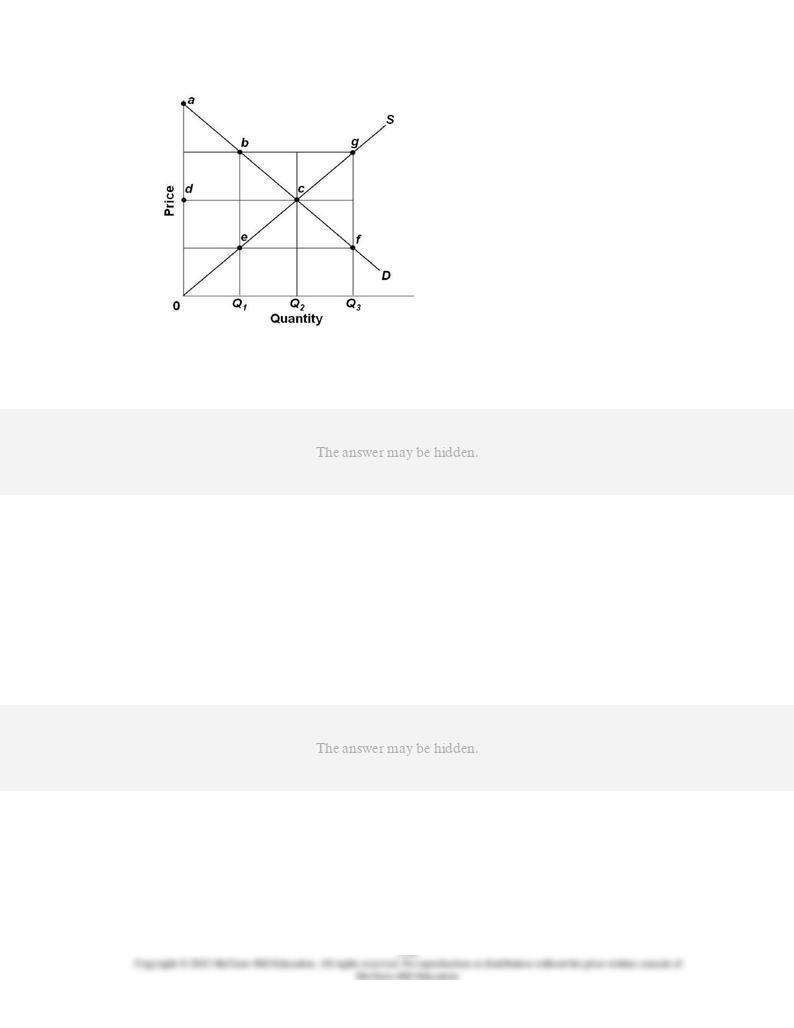
39.
Refer to the above graph. If the output level increases from Q2 to Q3, then the:
AACSB: Analytic
Blooms: Understand
Difficulty: 2 Medium
Learning Objective: 04-02 Explain the origin of both consumer surplus and producer surplus; and explain how properly
functioning markets maximize their sum; total surplus; while optimally allocating resources.
Topic: Efficiently Functioning Markets
40.
What are the two characteristics that differentiate private goods from public goods?
AACSB: Analytic
Accessibility: Keyboard Navigation
Blooms: Remember
Difficulty: 1 Easy
Learning Objective: 04-03 Describe free riding and public goods; and illustrate why private firms cannot normally produce
public goods.
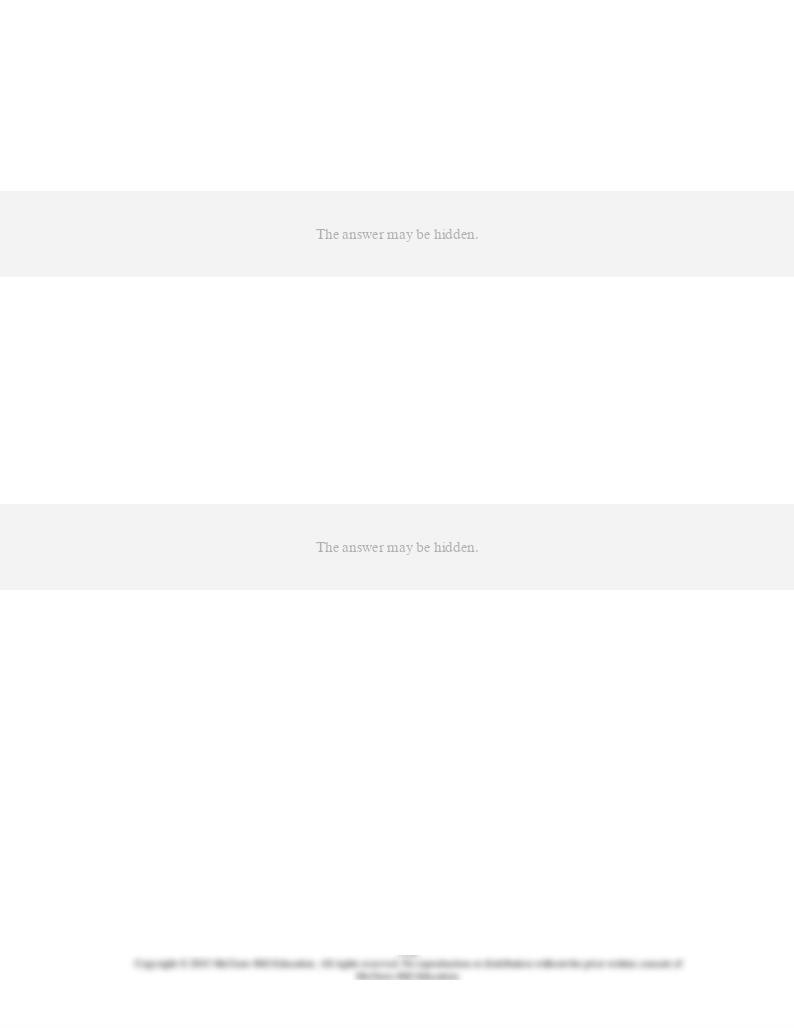
Topic: Public Goods
41.
Private firms can hardly produce a public good profitably because of:
AACSB: Analytic
Accessibility: Keyboard Navigation
Blooms: Remember
Difficulty: 1 Easy
Learning Objective: 04-03 Describe free riding and public goods; and illustrate why private firms cannot normally produce
public goods.
Topic: Public Goods
42.
Among the following examples, the one that best illustrates a public good is:
AACSB: Analytic
Accessibility: Keyboard Navigation
Blooms: Understand
Difficulty: 2 Medium
Learning Objective: 04-03 Describe free riding and public goods; and illustrate why private firms cannot normally produce
public goods.
Topic: Public Goods
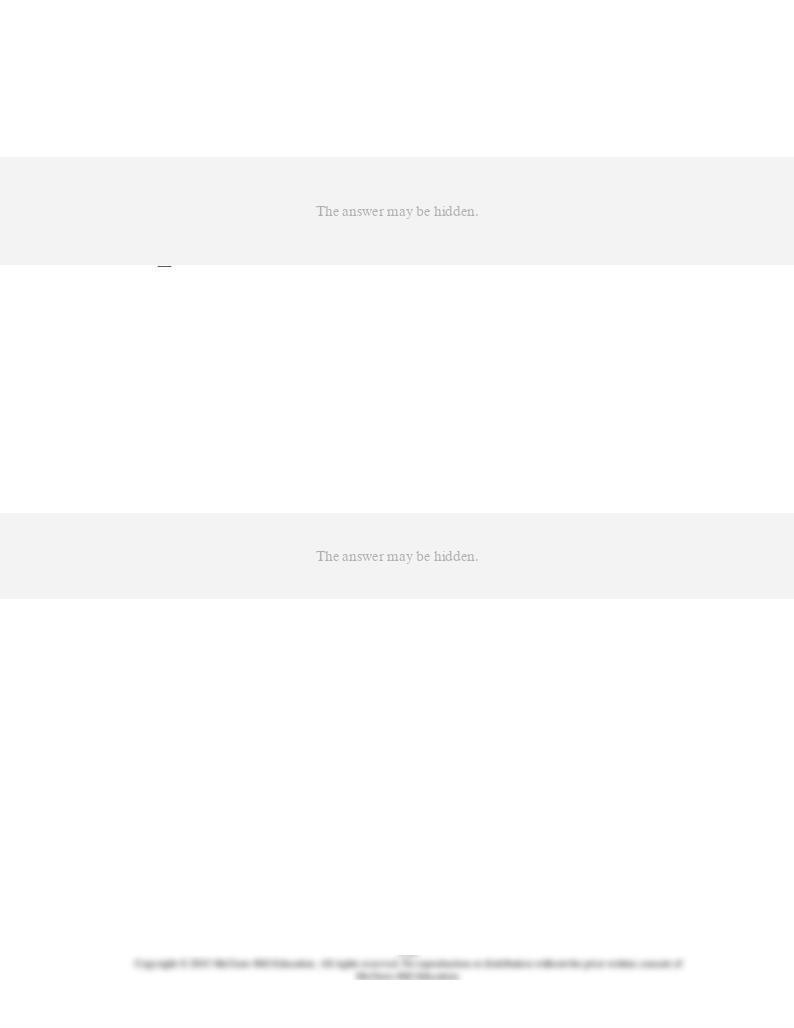
43.
A public good:
AACSB: Analytic
Accessibility: Keyboard Navigation
Blooms: Remember
Difficulty: 1 Easy
Learning Objective: 04-03 Describe free riding and public goods; and illustrate why private firms cannot normally produce
public goods.
Topic: Public Goods
44.
Assume there is no way to prevent someone from using an interstate highway, regardless
of whether or not he or she helps pay for it. This characteristic is called:
AACSB: Analytic
Accessibility: Keyboard Navigation
Blooms: Understand
Difficulty: 2 Medium
Learning Objective: 04-03 Describe free riding and public goods; and illustrate why private firms cannot normally produce
public goods.
Topic: Public Goods
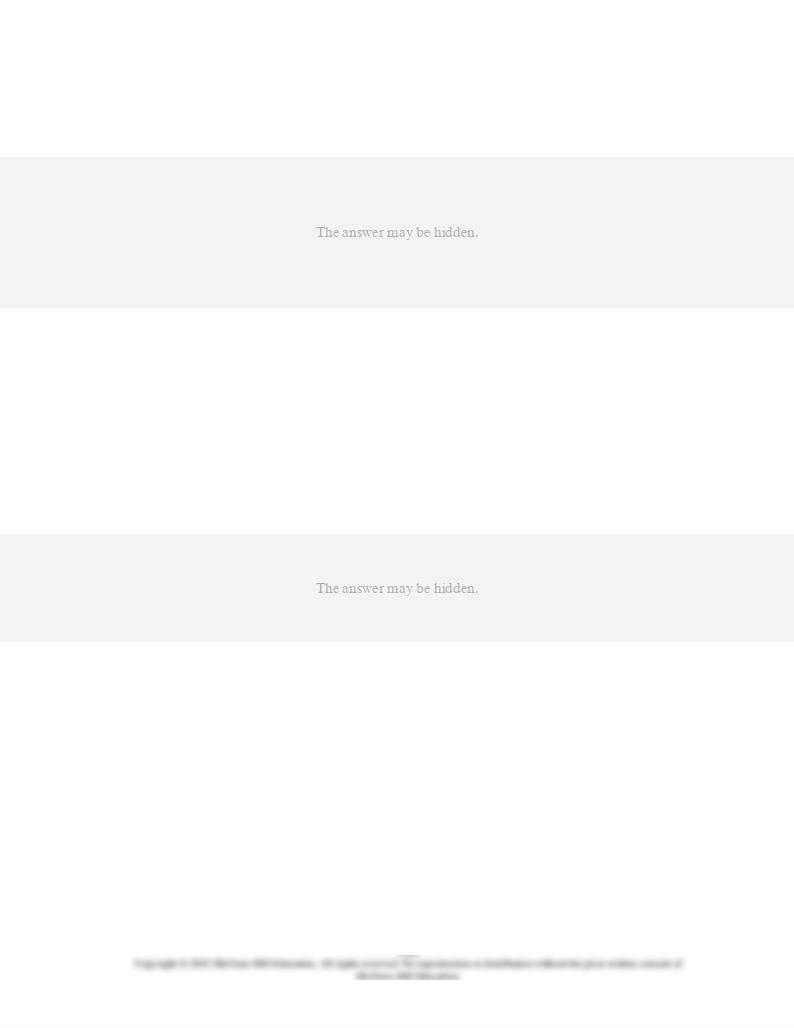
45.
Which of the following statements concerning a pure public good is false?
AACSB: Analytic
Accessibility: Keyboard Navigation
Blooms: Remember
Difficulty: 1 Easy
Learning Objective: 04-03 Describe free riding and public goods; and illustrate why private firms cannot normally produce
public goods.
Topic: Public Goods
46.
The market demand curve for a public good:
AACSB: Analytic
Accessibility: Keyboard Navigation
Blooms: Remember
Difficulty: 2 Medium
Learning Objective: 04-03 Describe free riding and public goods; and illustrate why private firms cannot normally produce
public goods.
Topic: Public Goods

47.
Refer to the above supply and demand graph for a public good. Point
c
on the graph shows
where the:
AACSB: Analytic
Blooms: Apply
Difficulty: 1 Easy
Learning Objective: 04-03 Describe free riding and public goods; and illustrate why private firms cannot normally produce
public goods.
Topic: Public Goods
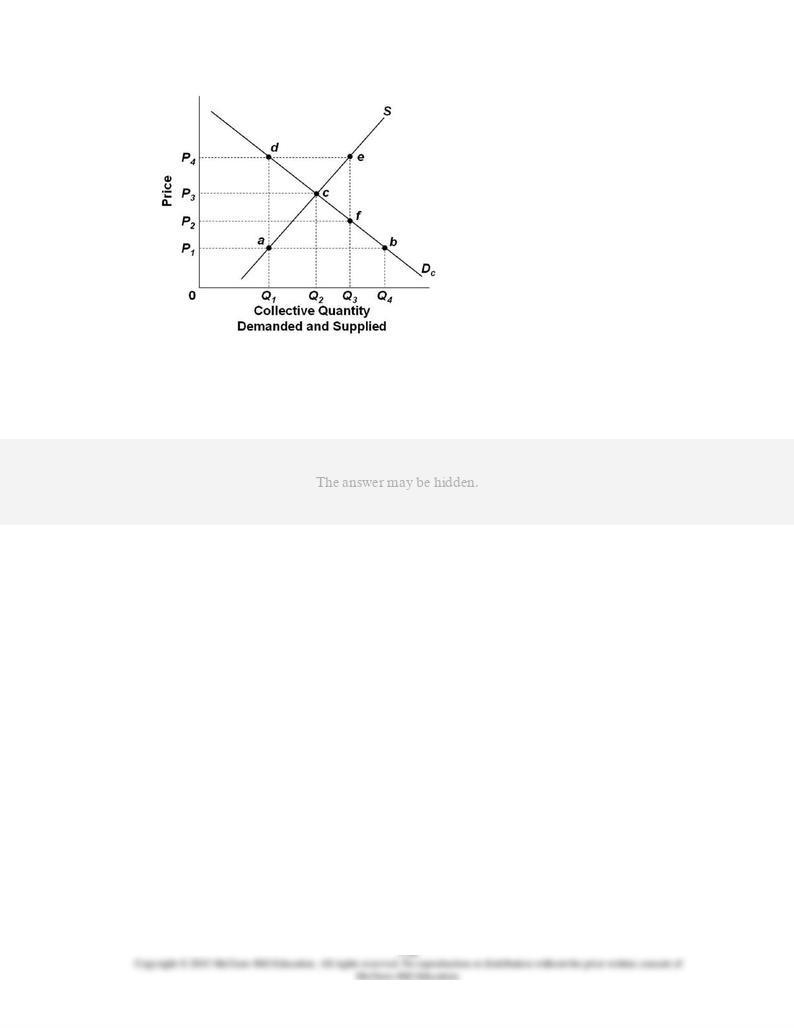
48.
Refer to the above supply and demand graph for a public good. If
Q1
units of the public
good are produced, then:
AACSB: Analytic
Blooms: Apply
Difficulty: 2 Medium
Learning Objective: 04-03 Describe free riding and public goods; and illustrate why private firms cannot normally produce
public goods.
Topic: Public Goods
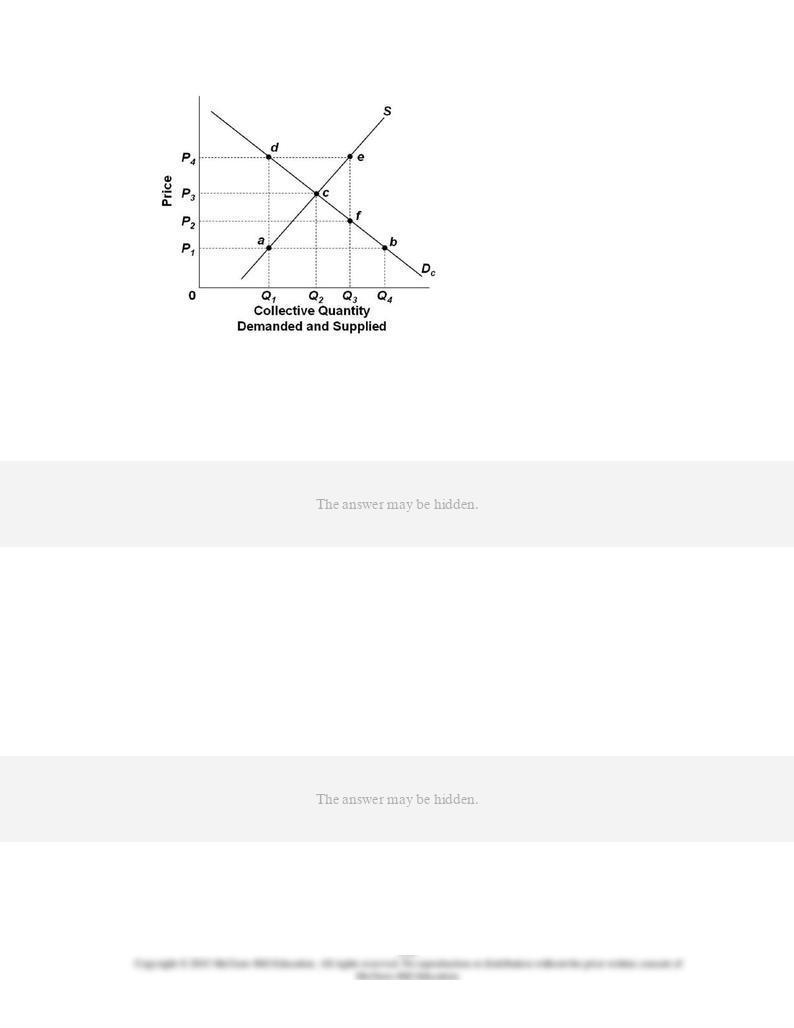
49.
Refer to the above supply and demand graph for a public good. Which line segment would
indicate the amount by which the marginal benefit of this public good exceeds the
marginal cost at a certain quantity?
AACSB: Analytic
Blooms: Apply
Difficulty: 2 Medium
Learning Objective: 04-03 Describe free riding and public goods; and illustrate why private firms cannot normally produce
public goods.
Topic: Public Goods
50.
Street entertainers face the free-rider problem when they perform because of the:
AACSB: Analytic
Accessibility: Keyboard Navigation
Blooms: Apply
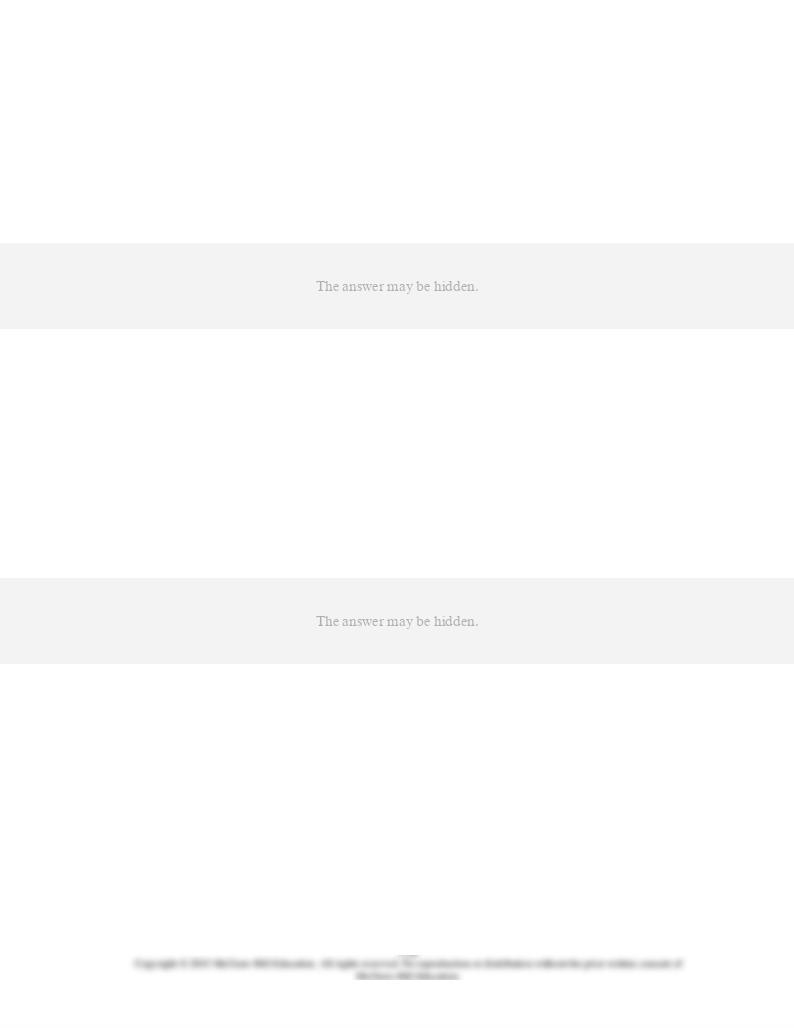
Difficulty: 2 Medium
Learning Objective: 04-03 Describe free riding and public goods; and illustrate why private firms cannot normally produce
public goods.
Topic: Public Goods
51.
For the music industry, the rise of Internet file-sharing of music has:
AACSB: Analytic
Accessibility: Keyboard Navigation
Blooms: Apply
Difficulty: 2 Medium
Learning Objective: 04-03 Describe free riding and public goods; and illustrate why private firms cannot normally produce
public goods.
Topic: Public Goods
52.
Government can reallocate resources away from private goods towards public goods,
usually through:
AACSB: Analytic
Accessibility: Keyboard Navigation
Blooms: Understand
Difficulty: 2 Medium
Learning Objective: 04-03 Describe free riding and public goods; and illustrate why private firms cannot normally produce
public goods.
Topic: Externalities
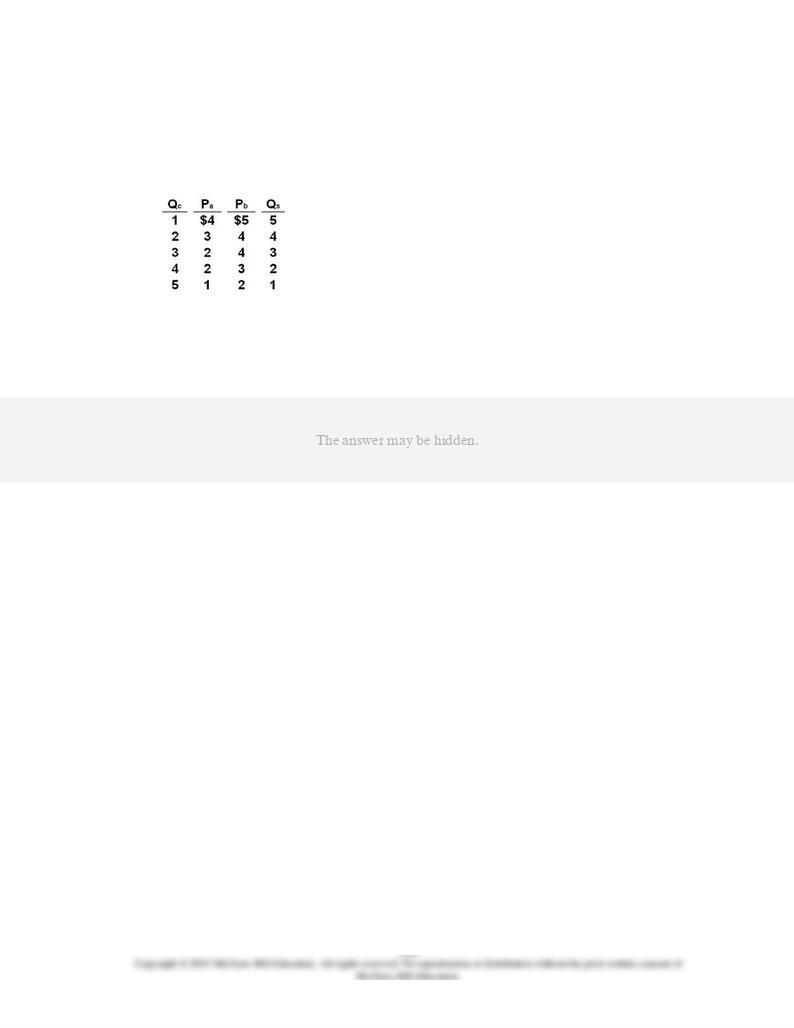
53.
Answer the question on the basis of the following information is for public good. Pa and Pb
represent the prices that citizens (a) and (b), the only two people in this nation, are willing
to pay for additional units of a quantity (Qc) of the public good. Qs represents the quantity
of the public good supplied by government at each of the collective prices.
Refer to the above information. The collective willingness of this nation to pay for the
fourth unit of the public good is:
AACSB: Analytic
Blooms: Apply
Difficulty: 1 Easy
Learning Objective: 04-03 Describe free riding and public goods; and illustrate why private firms cannot normally produce
public goods.
Topic: Public Goods
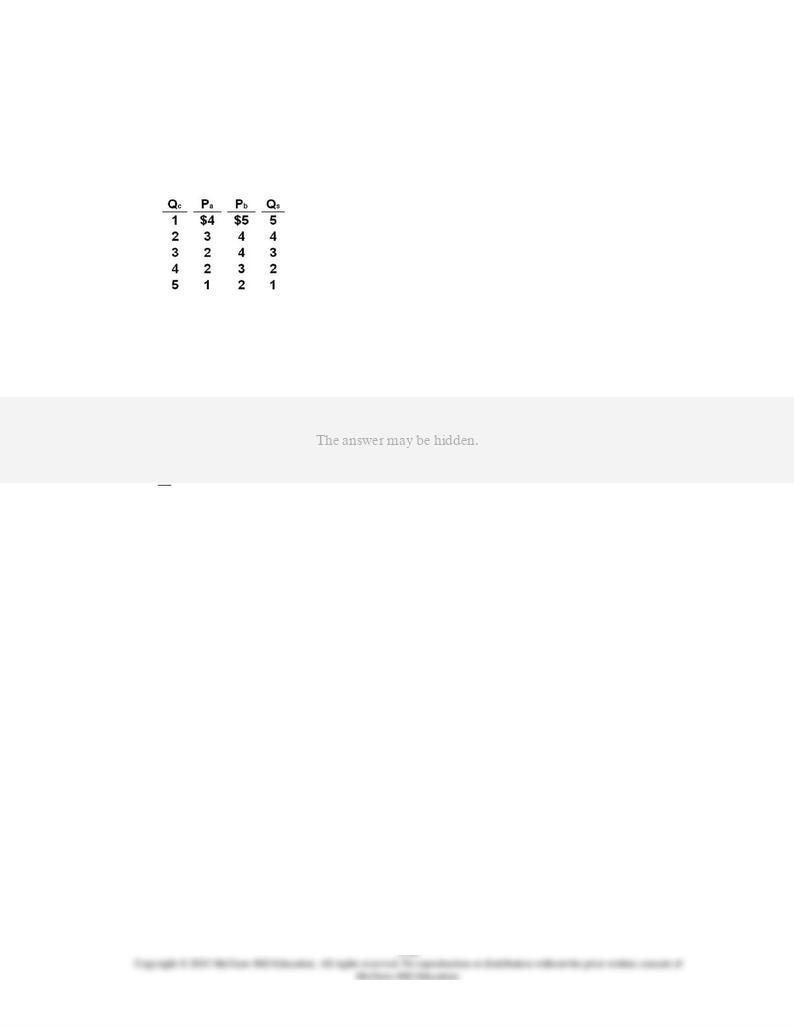
54.
Answer the question on the basis of the following information is for public good. Pa and Pb
represent the prices that citizens (a) and (b), the only two people in this nation, are willing
to pay for additional units of a quantity (Qc) of the public good. Qs represents the quantity
of the public good supplied by government at each of the collective prices.
Refer to the above information. If only 1 unit of this public good is produced, then the
marginal benefit is:
AACSB: Analytic
Blooms: Apply
Difficulty: 3 Hard
Learning Objective: 04-03 Describe free riding and public goods; and illustrate why private firms cannot normally produce
public goods.
Topic: Public Goods

55.
Answer the question on the basis of the following information is for public good. Pa and Pb
represent the prices that citizens (a) and (b), the only two people in this nation, are willing
to pay for additional units of a quantity (Qc) of the public good. Qs represents the quantity
of the public good supplied by government at each of the collective prices.
Refer to the above information. In equilibrium, the marginal benefit and cost of the public
good will be:
AACSB: Analytic
Blooms: Apply
Difficulty: 3 Hard
Learning Objective: 04-03 Describe free riding and public goods; and illustrate why private firms cannot normally produce
public goods.
Topic: Public Goods
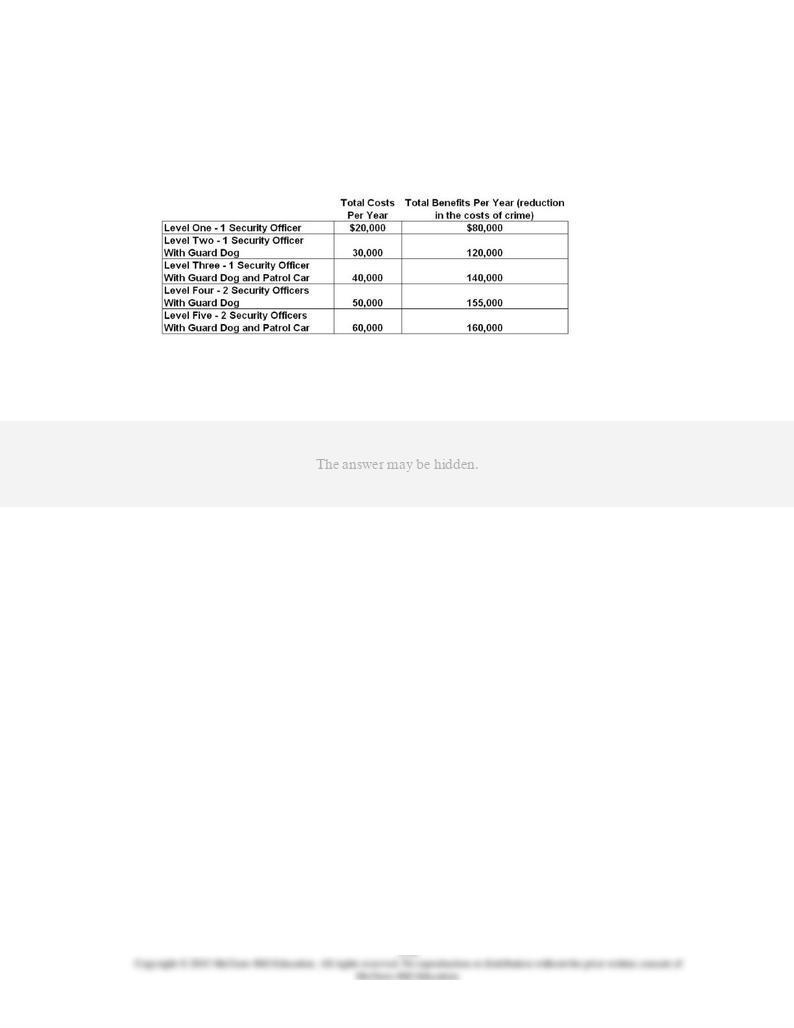
56.
Answer the question based on the following information. Normal University has found it
necessary to institute a crime-control program on its campus to deal with the high costs of
theft and vandalism. The university is now considering several alternative levels of crime
control. This table shows the expected annual costs and benefits of these alternatives.
Refer to the above information. The marginal benefits of crime control for Level Two are:
AACSB: Analytic
Blooms: Apply
Difficulty: 1 Easy
Learning Objective: 04-03 Describe free riding and public goods; and illustrate why private firms cannot normally produce
public goods.
Topic: Public Goods

57.
Answer the question based on the following information. Normal University has found it
necessary to institute a crime-control program on its campus to deal with the high costs of
theft and vandalism. The university is now considering several alternative levels of crime
control. This table shows the expected annual costs and benefits of these alternatives.
Refer to the above information. If Normal University undertakes program Level Three:
AACSB: Analytic
Blooms: Apply
Difficulty: 2 Medium
Learning Objective: 04-03 Describe free riding and public goods; and illustrate why private firms cannot normally produce
public goods.
Topic: Public Goods
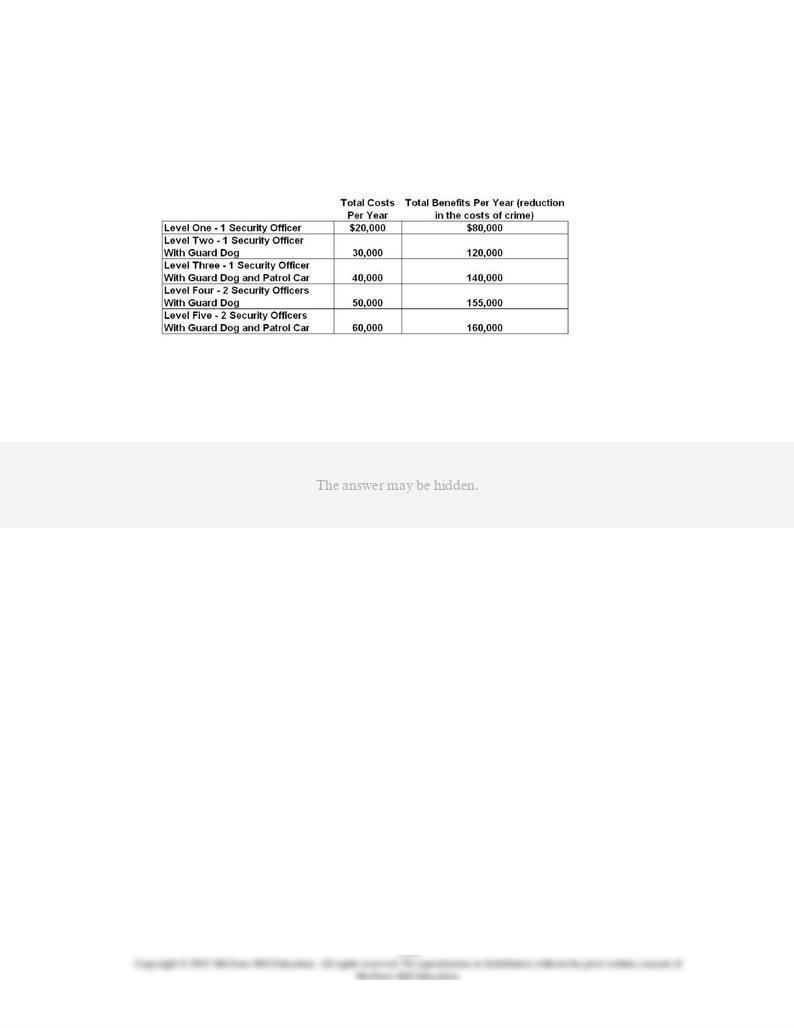
58.
Answer the question based on the following information. Normal University has found it
necessary to institute a crime-control program on its campus to deal with the high costs of
theft and vandalism. The university is now considering several alternative levels of crime
control. This table shows the expected annual costs and benefits of these alternatives.
Refer to the above information. Based on cost-benefit analysis, Normal University should
undertake Level:
AACSB: Analytic
Blooms: Apply
Difficulty: 3 Hard
Learning Objective: 04-03 Describe free riding and public goods; and illustrate why private firms cannot normally produce
public goods.
Topic: Public Goods
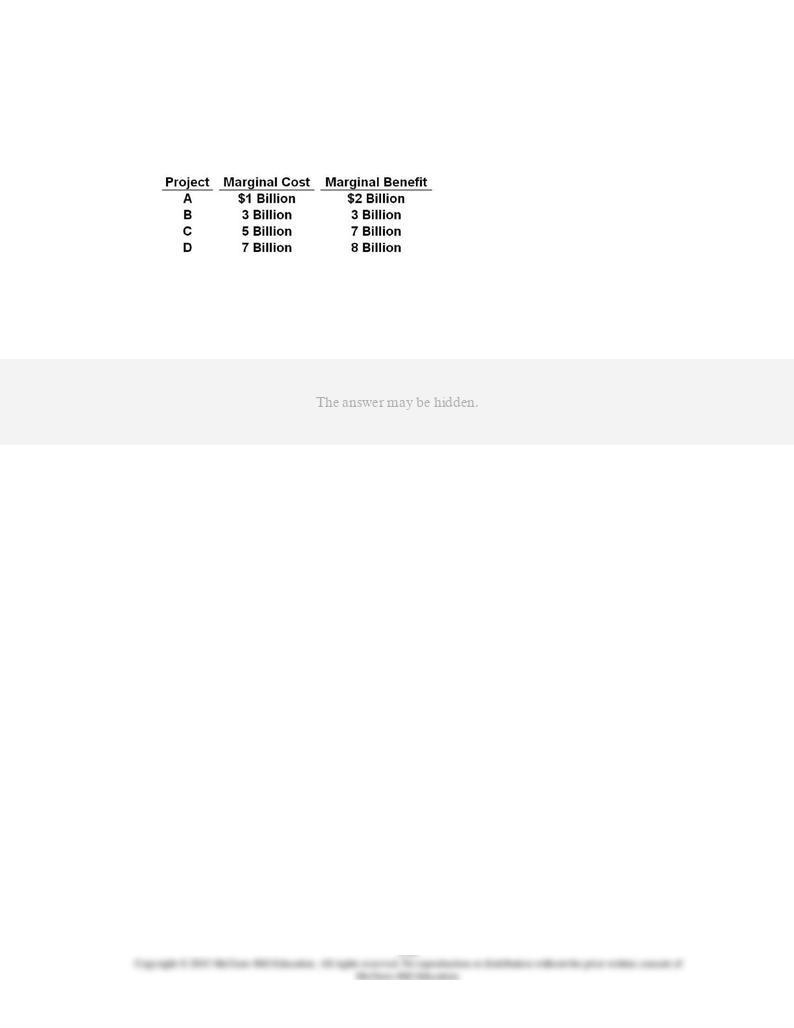
59.
Assume that a government is considering a new social program and may choose to include
in this program any number of four progressively larger projects. The marginal cost and
the marginal benefits of each of the four projects are given in the table.
Refer to the above table and information. What project should the government select to
achieve the maximum net benefit?
AACSB: Analytic
Blooms: Apply
Difficulty: 2 Medium
Learning Objective: 04-03 Describe free riding and public goods; and illustrate why private firms cannot normally produce
public goods.
Topic: Public Goods
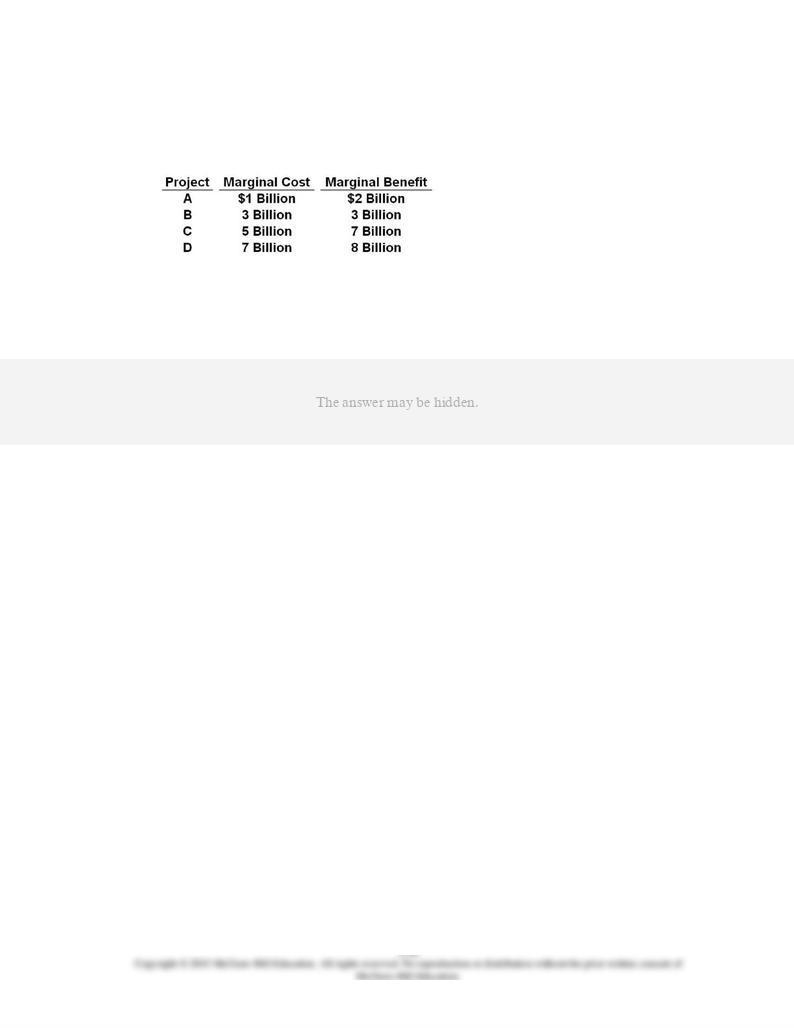
60.
Assume that a government is considering a new social program and may choose to include
in this program any number of four progressively larger projects. The marginal cost and
the marginal benefits of each of the four projects are given in the table.
Refer to the above table and information. What is the total cost and total benefit of doing
projects A, B, and C?
AACSB: Analytic
Blooms: Apply
Difficulty: 2 Medium
Learning Objective: 04-03 Describe free riding and public goods; and illustrate why private firms cannot normally produce
public goods.
Topic: Public Goods
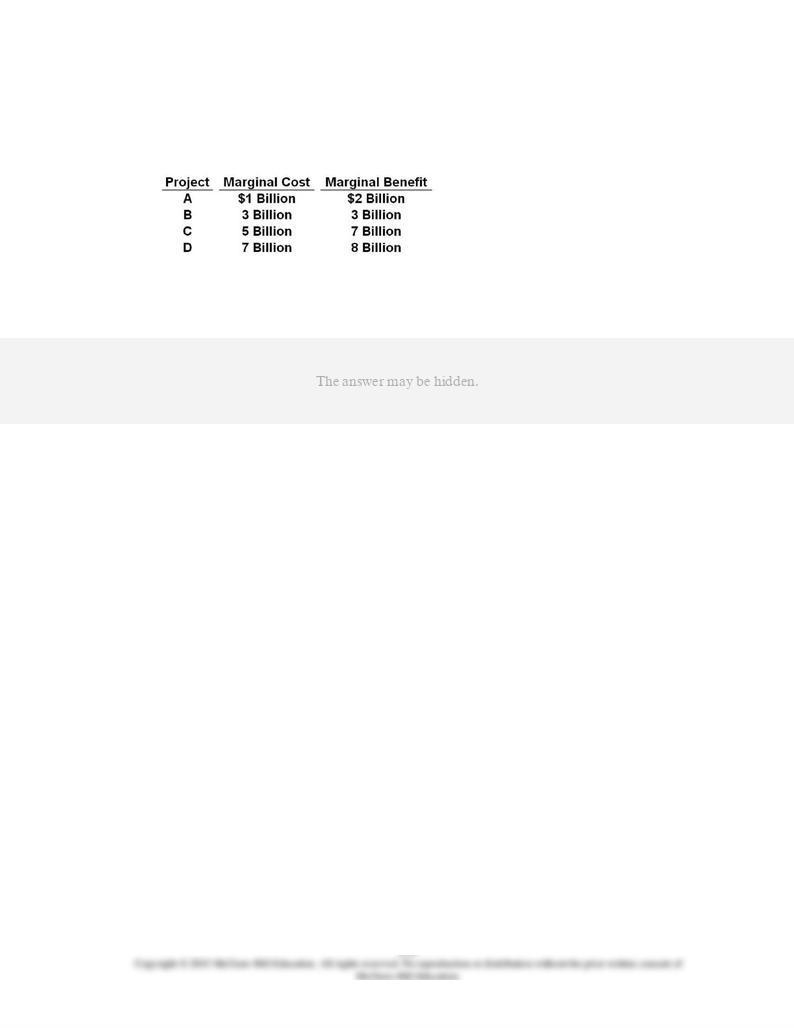
61.
Assume that a government is considering a new social program and may choose to include
in this program any number of four progressively larger projects. The marginal cost and
the marginal benefits of each of the four projects are given in the table.
Refer to the above table and information. What is the net benefit of project D?
AACSB: Analytic
Blooms: Apply
Difficulty: 2 Medium
Learning Objective: 04-03 Describe free riding and public goods; and illustrate why private firms cannot normally produce
public goods.
Topic: Public Goods

62.
A government is considering undertaking one or more construction projects. The
estimated marginal costs and benefits of each project are given in the table.
Refer to the above table and information. What is the total amount that the government
should spend on construction projects?
AACSB: Analytic
Blooms: Apply
Difficulty: 2 Medium
Learning Objective: 04-03 Describe free riding and public goods; and illustrate why private firms cannot normally produce
public goods.
Topic: Public Goods

63.
A government is considering undertaking one or more construction projects. The
estimated marginal costs and benefits of each project are given in the table.
Refer to the above table and information. What is the total cost and total benefit of
projects 1, 2, and 3?
AACSB: Analytic
Blooms: Apply
Difficulty: 2 Medium
Learning Objective: 04-03 Describe free riding and public goods; and illustrate why private firms cannot normally produce
public goods.
Topic: Public Goods

64.
A government is considering undertaking one or more construction projects. The
estimated marginal costs and benefits of each project are given in the table.
Refer to the above table and information. What is the net benefit of project 2?
AACSB: Analytic
Blooms: Apply
Difficulty: 2 Medium
Learning Objective: 04-03 Describe free riding and public goods; and illustrate why private firms cannot normally produce
public goods.
Topic: Public Goods
65.
Which of the following is an example of a negative externality?
AACSB: Reflective Thinking
Accessibility: Keyboard Navigation
Blooms: Apply
Difficulty: 2 Medium
Learning Objective: 04-04 Explain how positive and negative externalities cause under- and overallocations of resources.
Topic: Externalities
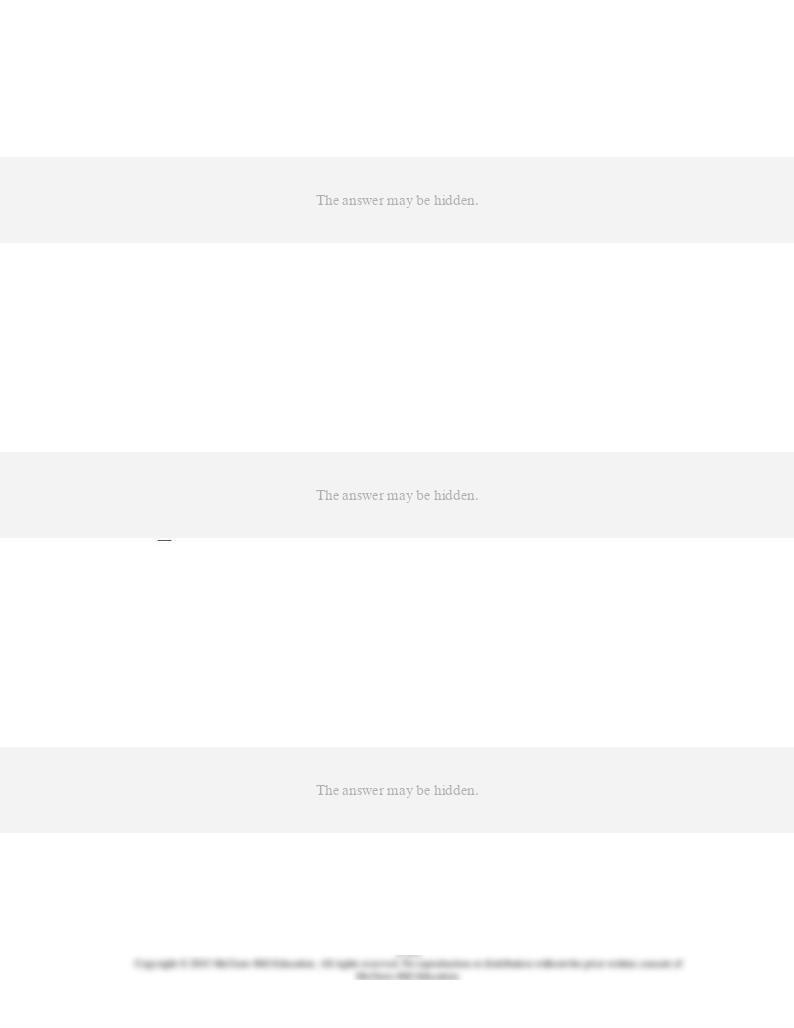
66.
In a free-market economy, a product which entails a positive externality will be:
AACSB: Analytic
Accessibility: Keyboard Navigation
Blooms: Remember
Difficulty: 2 Medium
Learning Objective: 04-04 Explain how positive and negative externalities cause under- and overallocations of resources.
Topic: Externalities
67.
In a situation where an externality occurs, the "third party" refers to those who:
AACSB: Analytic
Accessibility: Keyboard Navigation
Blooms: Remember
Difficulty: 2 Medium
Learning Objective: 04-04 Explain how positive and negative externalities cause under- and overallocations of resources.
Topic: Externalities
68.
External benefits in consumption refer to benefits accruing to:
AACSB: Analytic
Accessibility: Keyboard Navigation
Blooms: Remember
Difficulty: 1 Easy
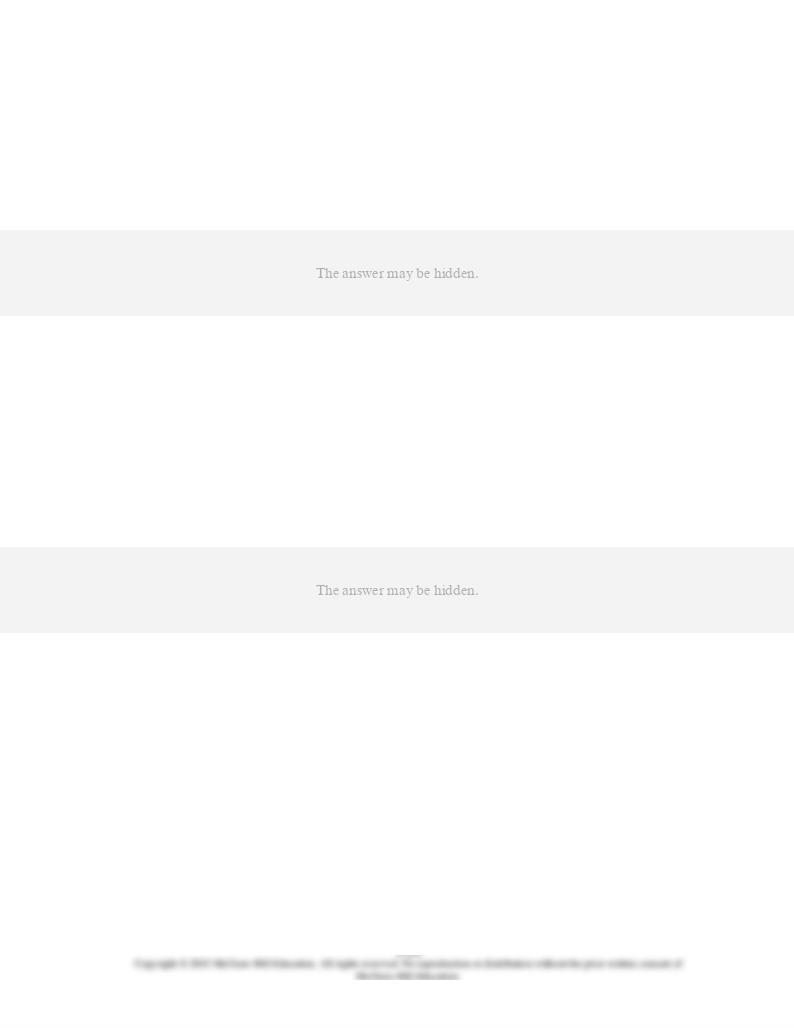
Learning Objective: 04-04 Explain how positive and negative externalities cause under- and overallocations of resources.
Topic: Externalities
69.
If some activity creates external benefits as well as private benefits, then economic theory
suggests that the activity ought to be:
AACSB: Analytic
Accessibility: Keyboard Navigation
Blooms: Remember
Difficulty: 1 Easy
Learning Objective: 04-04 Explain how positive and negative externalities cause under- and overallocations of resources.
Topic: Externalities
70.
If a good that generates negative externalities were priced to take these negative
externalities into account, then its:
AACSB: Analytic
Accessibility: Keyboard Navigation
Blooms: Remember
Difficulty: 1 Easy
Learning Objective: 04-04 Explain how positive and negative externalities cause under- and overallocations of resources.
Topic: Externalities
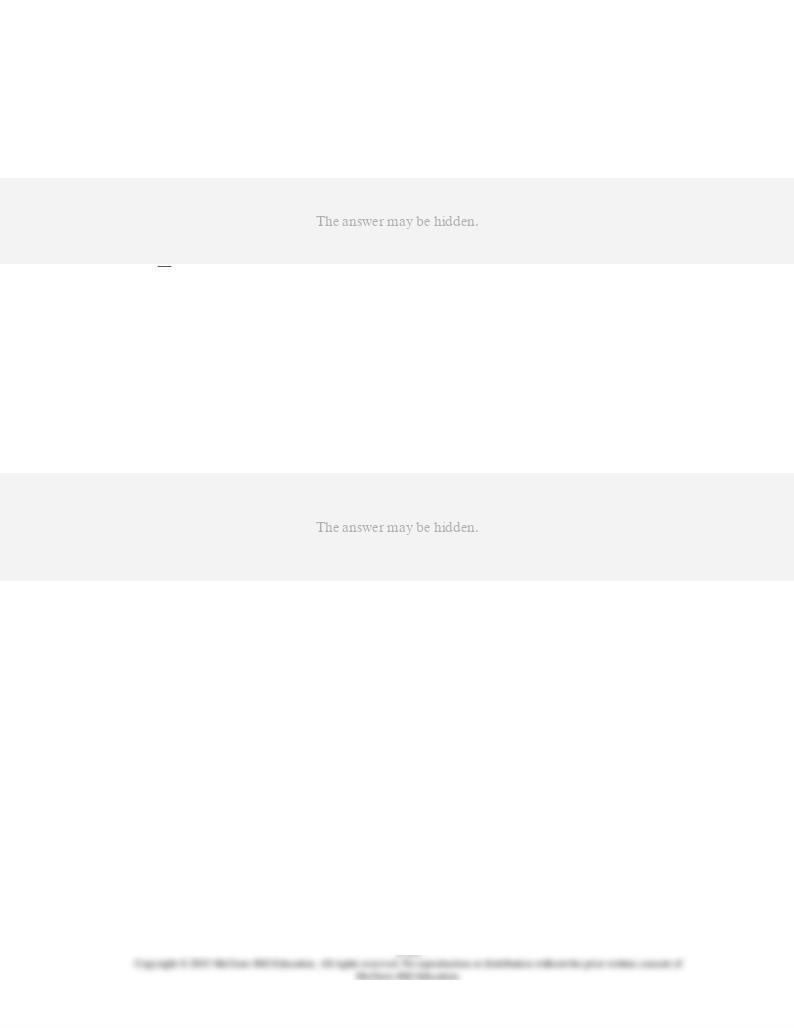
71.
In a market where negative externalities are associated with consumption and production,
the equilibrium will not be efficient because:
AACSB: Analytic
Accessibility: Keyboard Navigation
Blooms: Remember
Difficulty: 2 Medium
Learning Objective: 04-04 Explain how positive and negative externalities cause under- and overallocations of resources.
Topic: Externalities
72.
If there are external benefits associated with the consumption of a good or service:
AACSB: Analytic
Accessibility: Keyboard Navigation
Blooms: Remember
Difficulty: 1 Easy
Learning Objective: 04-04 Explain how positive and negative externalities cause under- and overallocations of resources.
Topic: Externalities
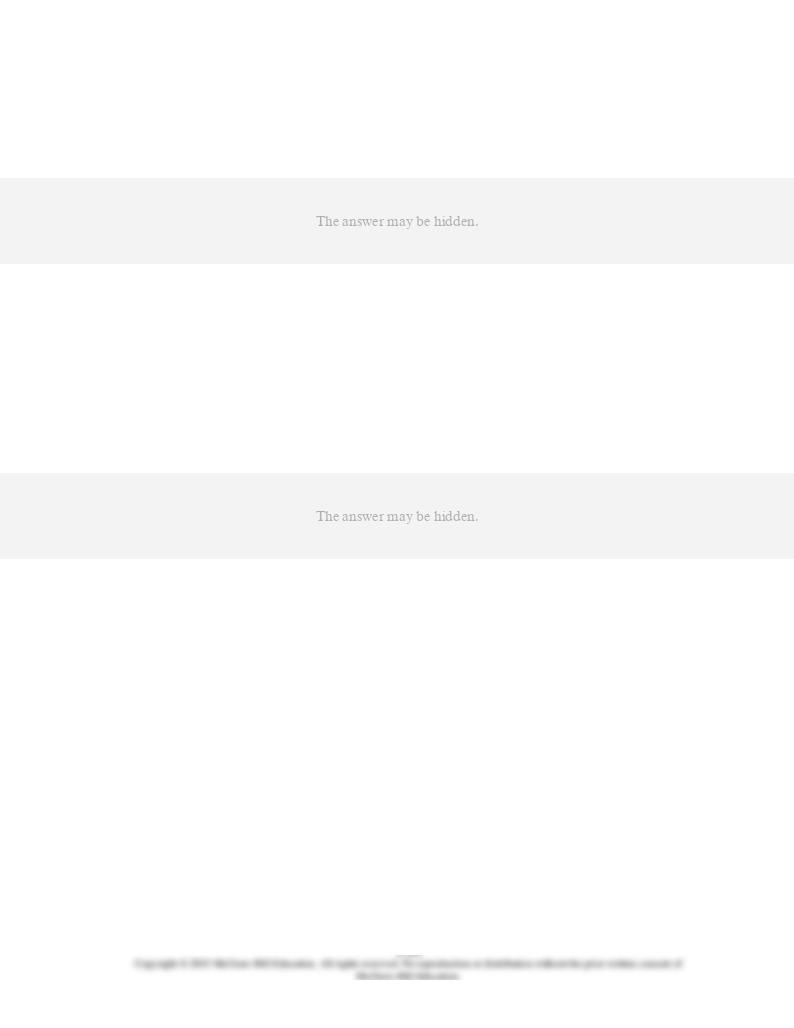
73.
If the production of a product or service involves external benefits, then the government
can improve efficiency in the market by:
AACSB: Analytic
Accessibility: Keyboard Navigation
Blooms: Remember
Difficulty: 1 Easy
Learning Objective: 04-04 Explain how positive and negative externalities cause under- and overallocations of resources.
Topic: Externalities
74.
When the production of a good generates external costs, the firm's supply curve will be:
AACSB: Analytic
Accessibility: Keyboard Navigation
Blooms: Remember
Difficulty: 1 Easy
Learning Objective: 04-04 Explain how positive and negative externalities cause under- and overallocations of resources.
Topic: Externalities
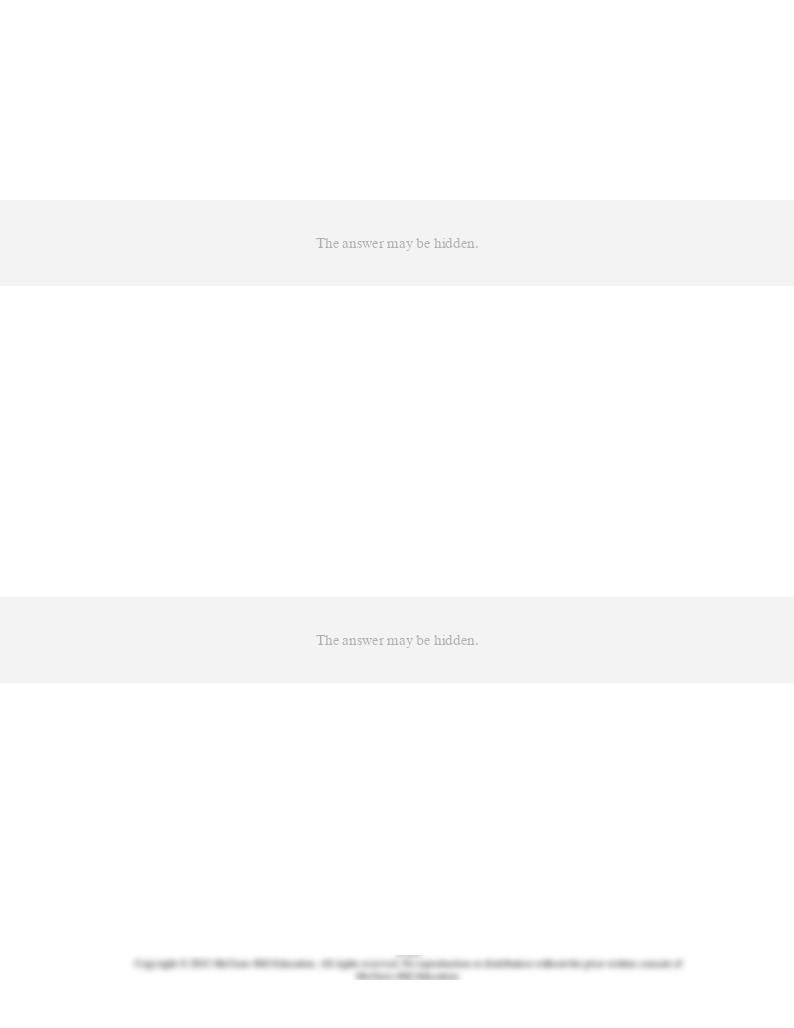
75.
Where there are spillover (or external) benefits from having a particular product in a
society, the government can make the quantity of the product approach the socially
optimal level by doing the following
except
:
AACSB: Analytic
Accessibility: Keyboard Navigation
Blooms: Remember
Difficulty: 1 Easy
Learning Objective: 04-04 Explain how positive and negative externalities cause under- and overallocations of resources.
Topic: Externalities
76.
It is the custom for paper mills located alongside the Layzee River to discharge waste
products into the river. As a result, operators of hydroelectric power-generating plants
downstream along the river find that they must clean up the river's water before it flows
through their equipment.
In the situation described above, we would expect an:
AACSB: Reflective Thinking
Accessibility: Keyboard Navigation
Blooms: Apply
Difficulty: 2 Medium
Learning Objective: 04-04 Explain how positive and negative externalities cause under- and overallocations of resources.
Topic: Externalities
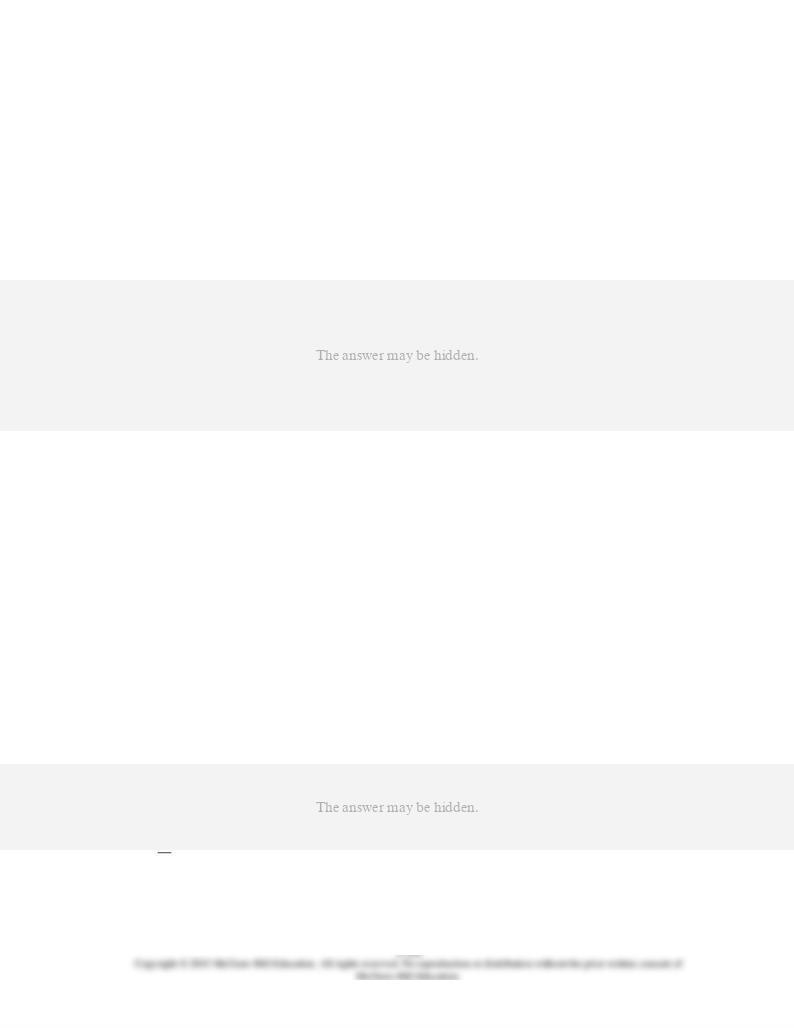
77.
It is the custom for paper mills located alongside the Layzee River to discharge waste
products into the river. As a result, operators of hydroelectric power-generating plants
downstream along the river find that they must clean up the river's water before it flows
through their equipment.
Refer to the above information. Which of the following policies would be most appropriate
for dealing with this problem?
AACSB: Analytic
Accessibility: Keyboard Navigation
Blooms: Apply
Difficulty: 2 Medium
Learning Objective: 04-04 Explain how positive and negative externalities cause under- and overallocations of resources.
Topic: Externalities
78.
It is the custom for paper mills located alongside the Layzee River to discharge waste
products into the river. As a result, operators of hydroelectric power-generating plants
downstream along the river find that they must clean up the river's water before it flows
through their equipment.
If the government intervenes and corrects the externality in the situation described above,
we would expect:
AACSB: Reflective Thinking
Accessibility: Keyboard Navigation
Blooms: Apply
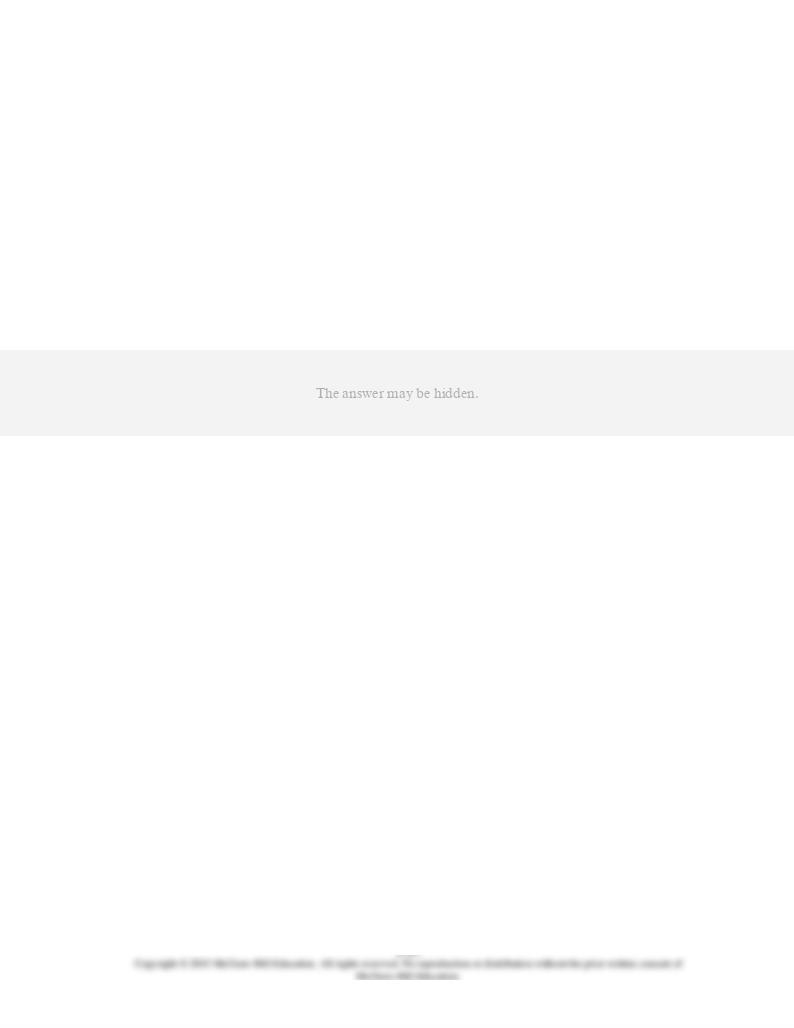
Difficulty: 3 Hard
Learning Objective: 04-04 Explain how positive and negative externalities cause under- and overallocations of resources.
Topic: Externalities
79.
It is the custom for paper mills located alongside the Layzee River to discharge waste
products into the river. As a result, operators of hydroelectric power-generating plants
downstream along the river find that they must clean up the river's water before it flows
through their equipment.
If the government intervenes and corrects the externality in the situation described above,
we would expect:
AACSB: Reflective Thinking
Accessibility: Keyboard Navigation
Blooms: Apply
Difficulty: 3 Hard
Learning Objective: 04-04 Explain how positive and negative externalities cause under- and overallocations of resources.
Topic: Externalities
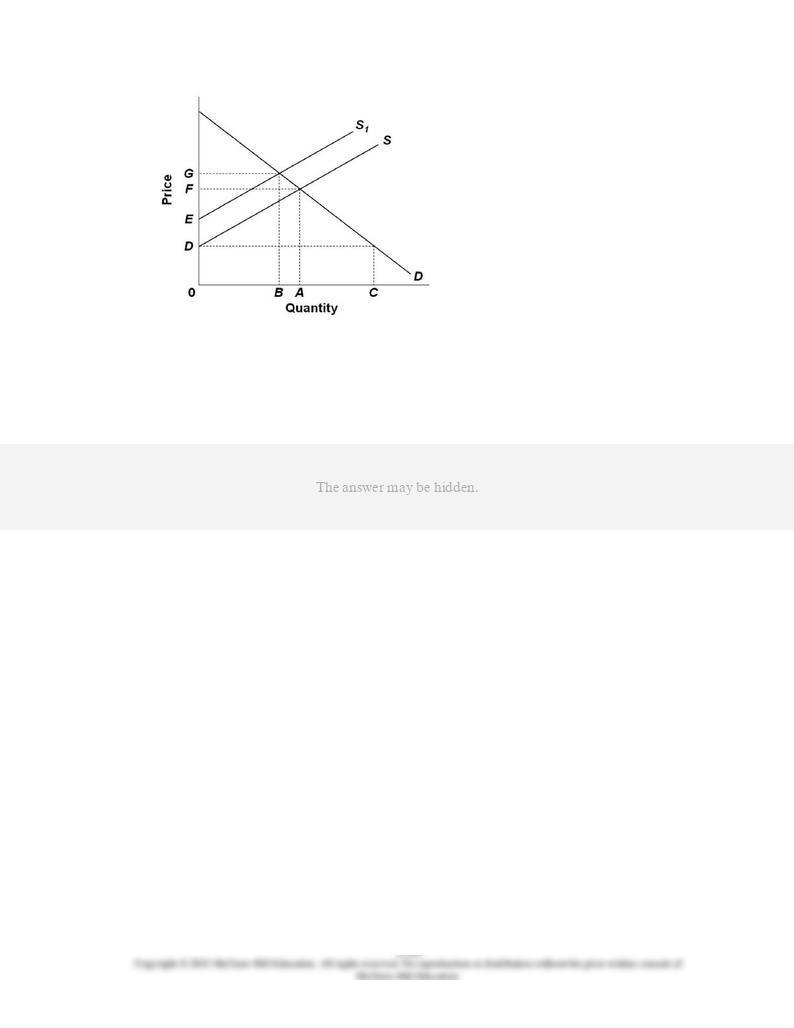
80.
Refer to the above supply and demand graph. In the graph, line S is the current supply of
this product, while line S1 is the optimal supply from the society's perspective. This figure
suggests that there is (are):
AACSB: Reflective Thinking
Blooms: Apply
Difficulty: 2 Medium
Learning Objective: 04-04 Explain how positive and negative externalities cause under- and overallocations of resources.
Topic: Externalities
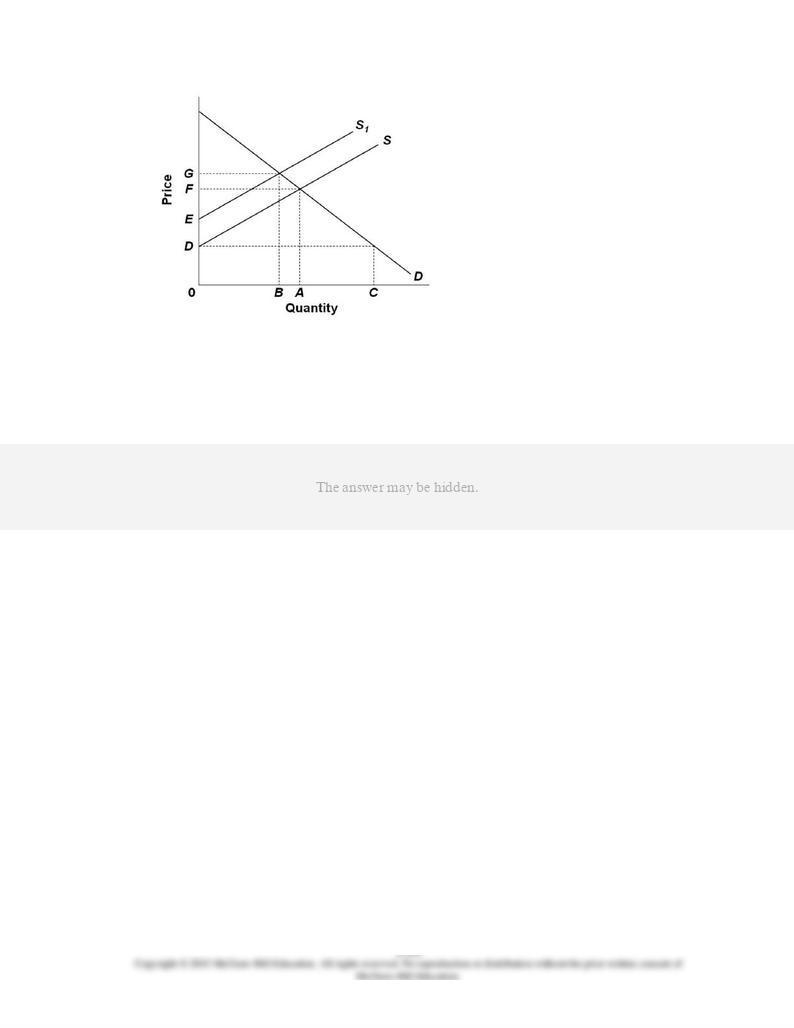
81.
Refer to the above supply and demand graph. In the graph, line S is the current supply of
this product, while line S1 is the optimal supply from the society's perspective. One
solution to this externality problem is to:
AACSB: Reflective Thinking
Blooms: Apply
Difficulty: 2 Medium
Learning Objective: 04-04 Explain how positive and negative externalities cause under- and overallocations of resources.
Topic: Externalities
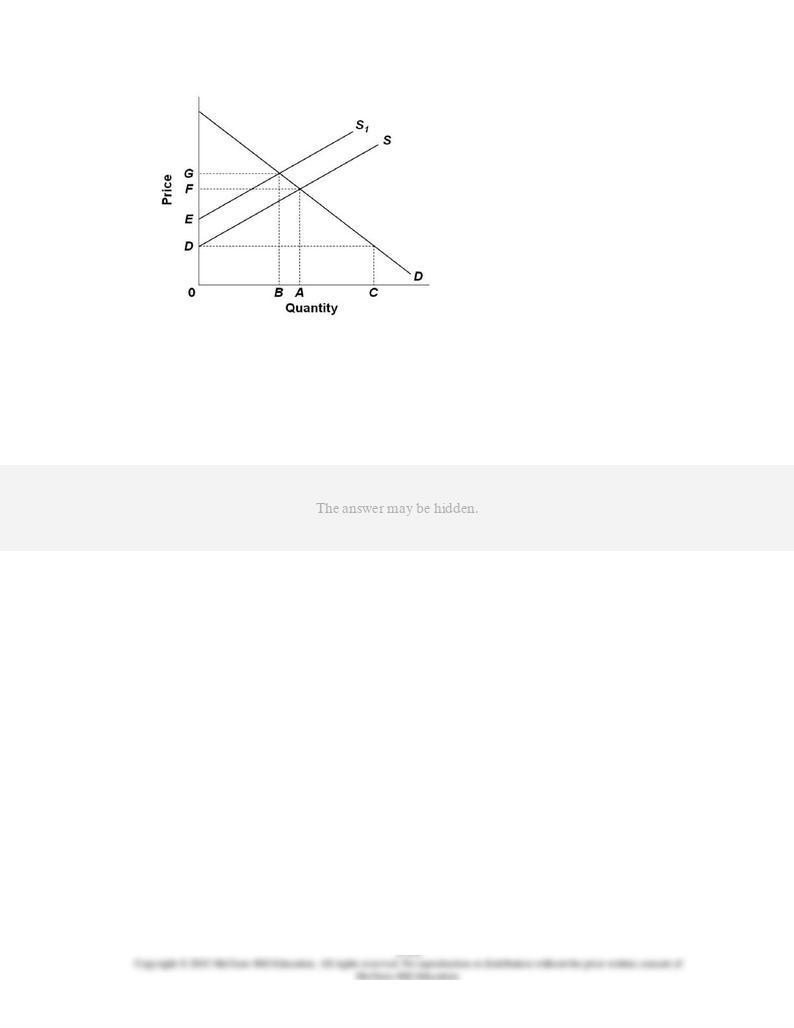
82.
Refer to the above supply and demand graph. In the graph, line S is the current supply of
this product, while line S1 is the optimal supply from the society's perspective. If
government corrects this externality problem and shifts production to the socially optimal
level, then the product price will be equal to:
AACSB: Reflective Thinking
Blooms: Apply
Difficulty: 3 Hard
Learning Objective: 04-04 Explain how positive and negative externalities cause under- and overallocations of resources.
Topic: Externalities
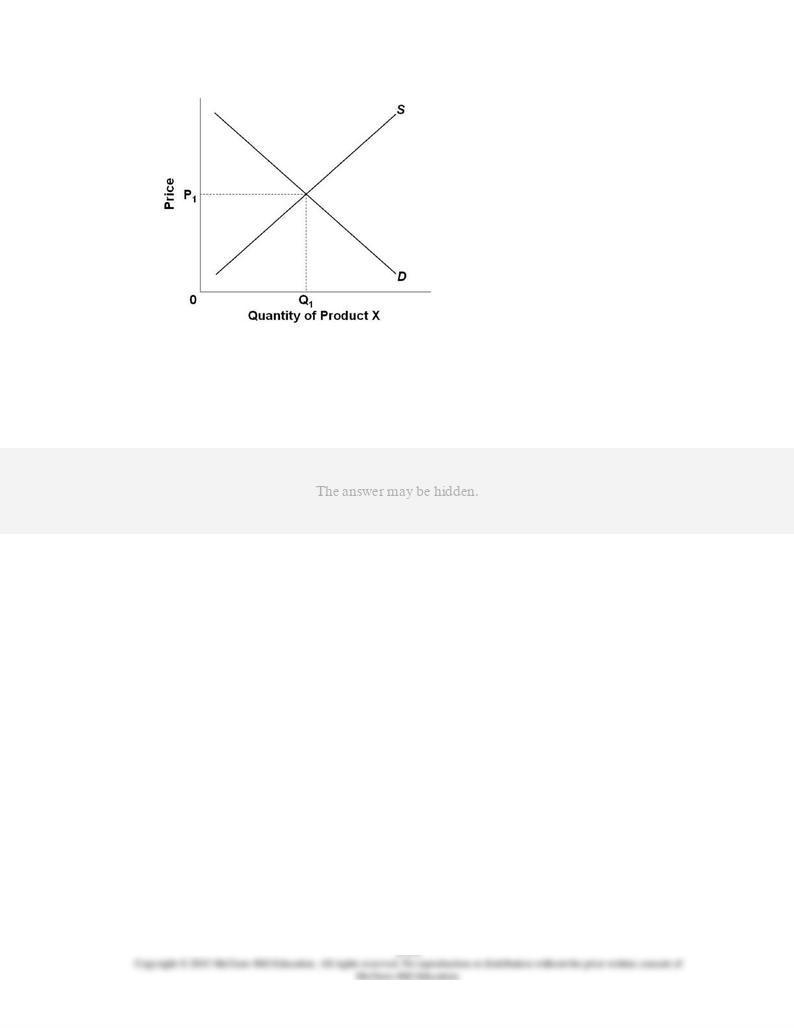
83.
Refer to the above supply and demand graph of Product X. What would happen if the
government taxed the producers of this product because it has negative externalities in
production?
AACSB: Analytic
Blooms: Understand
Difficulty: 1 Easy
Learning Objective: 04-04 Explain how positive and negative externalities cause under- and overallocations of resources.
Topic: Externalities
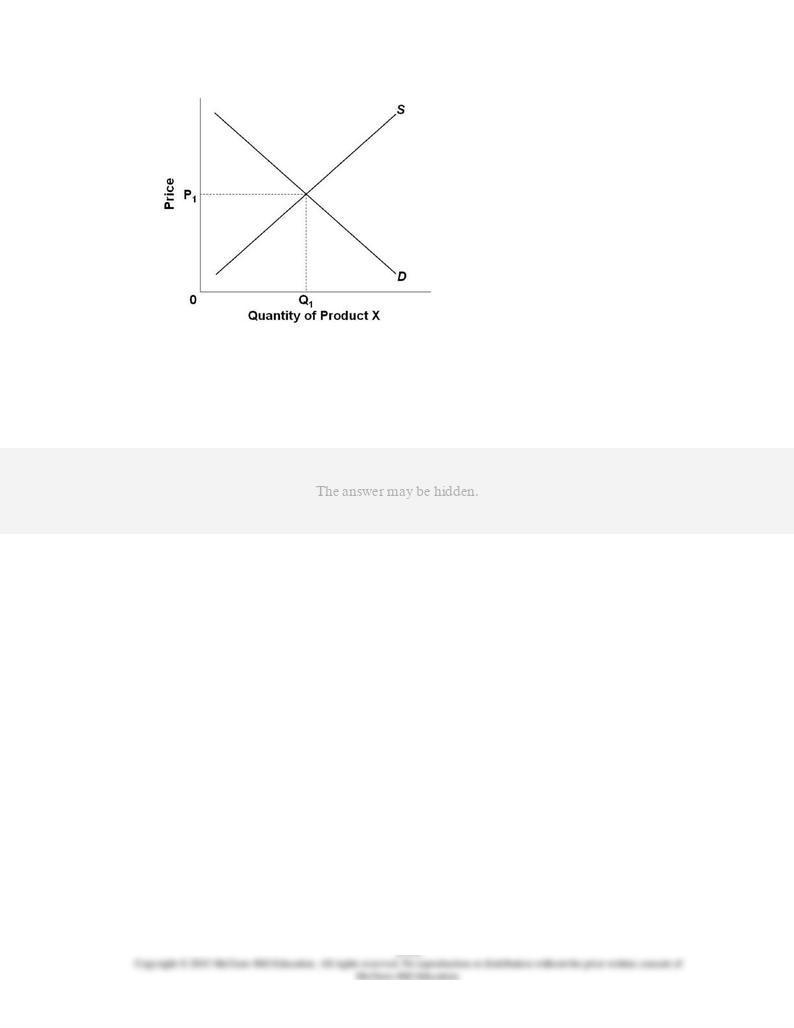
84.
Refer to the above supply and demand graph of Product X. If there are positive
externalities from the consumption of Product X, then the socially optimal demand curve
would be:
AACSB: Analytic
Blooms: Apply
Difficulty: 2 Medium
Learning Objective: 04-04 Explain how positive and negative externalities cause under- and overallocations of resources.
Topic: Externalities
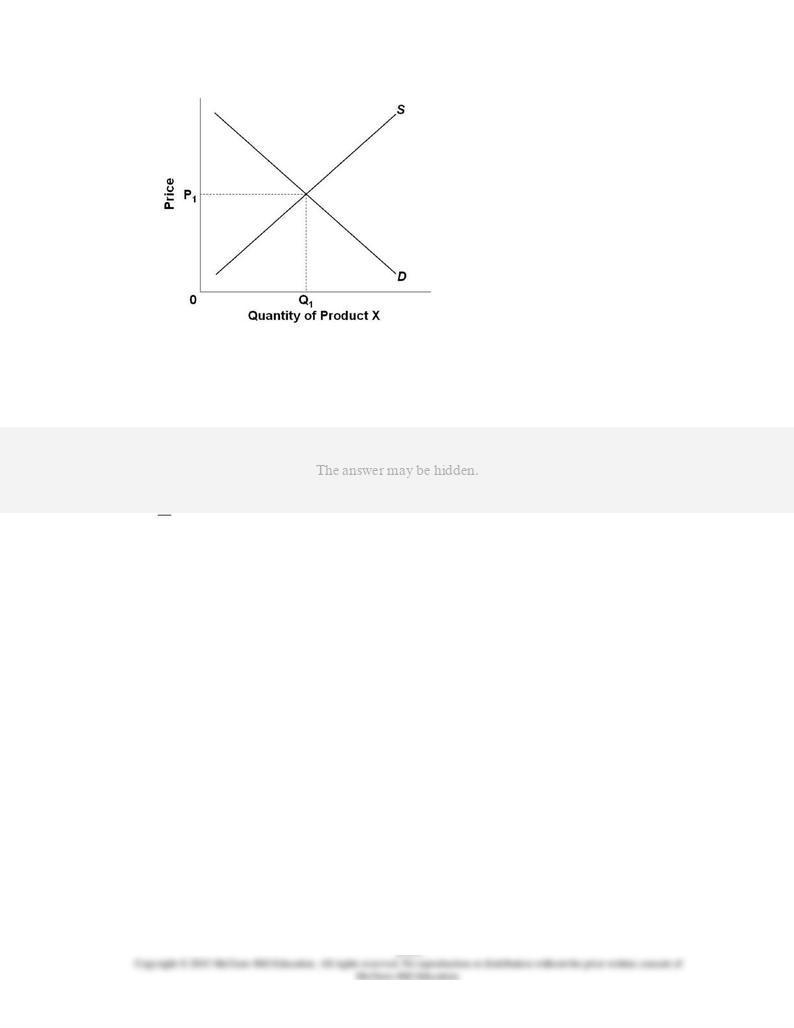
85.
Refer to the above supply and demand graph of Product X. What would happen if the
government decided to also start providing Product X in the market?
AACSB: Analytic
Blooms: Understand
Difficulty: 1 Easy
Learning Objective: 04-04 Explain how positive and negative externalities cause under- and overallocations of resources.
Topic: Externalities

86.
Refer to the above supply and demand graph. S1 and D1 represent the current market
supply and demand, respectively. S2 and D2 represent the socially optimal supply and
demand. The positions of the graphs indicate that there is (are):
AACSB: Analytic
Blooms: Apply
Difficulty: 2 Medium
Learning Objective: 04-04 Explain how positive and negative externalities cause under- and overallocations of resources.
Topic: Externalities
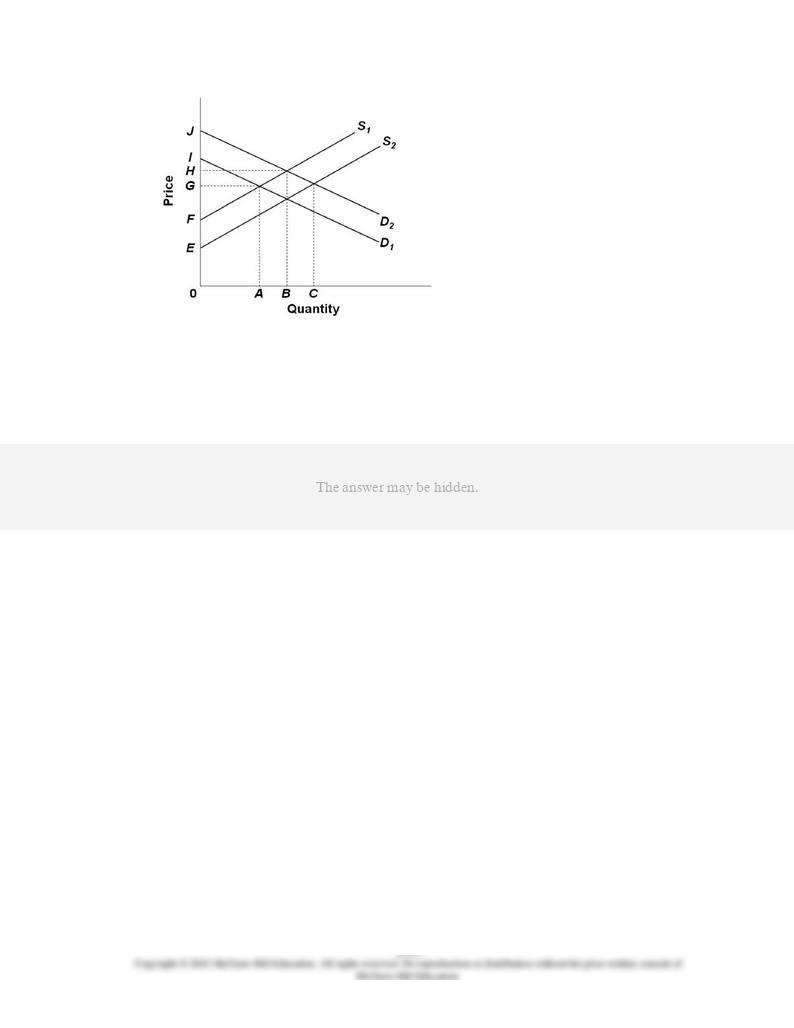
87.
Refer to the above supply and demand graph. S1 and D1 represent the current market
supply and demand, respectively. S2 and D2 represent the socially optimal supply and
demand. One way that the government could shift supply to its socially optimal level is to:
AACSB: Analytic
Blooms: Apply
Difficulty: 2 Medium
Learning Objective: 04-04 Explain how positive and negative externalities cause under- and overallocations of resources.
Topic: Government's Role in the Economy
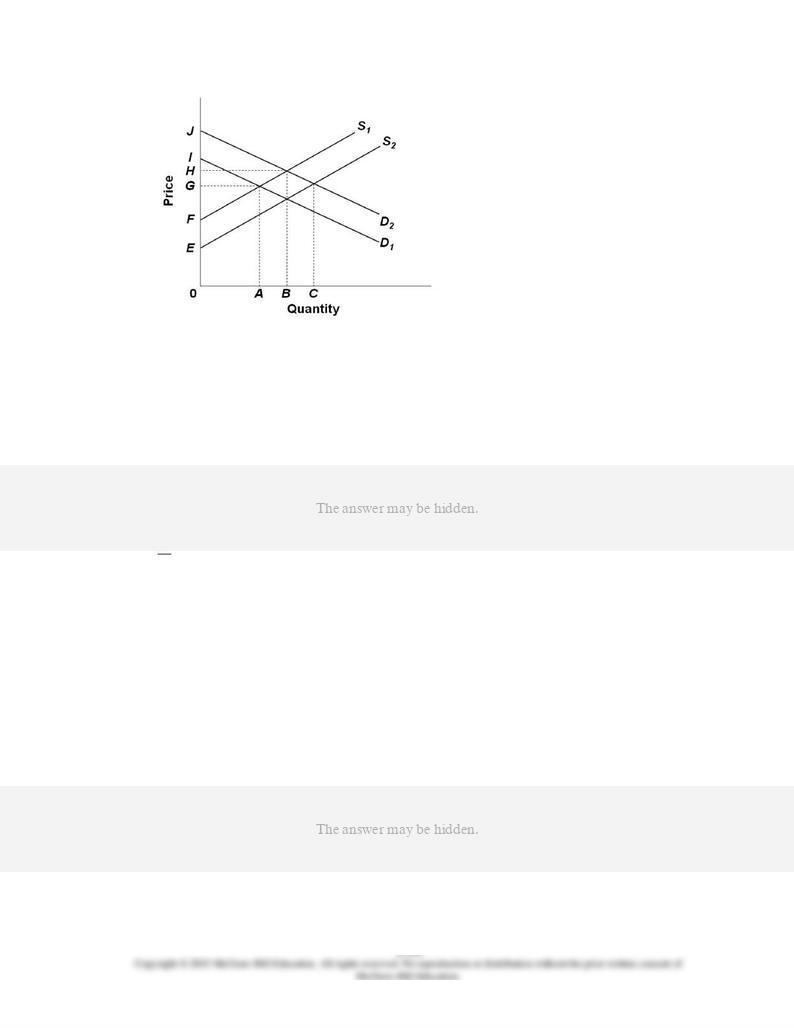
88.
Refer to the above supply and demand graph. S1 and D1 represent the current market
supply and demand, respectively. S2 and D2 represent the socially optimal supply and
demand. One way that the government could shift demand to its socially optimal level is
to:
AACSB: Analytic
Blooms: Apply
Difficulty: 2 Medium
Learning Objective: 04-04 Explain how positive and negative externalities cause under- and overallocations of resources.
Topic: Government's Role in the Economy
89.
Near an ocean beach, a high-rise building is being constructed that will block the scenic
view of the ocean by the residents of a low-rise building. The Coase theorem suggests
that this type of dispute between the owners of high-rise and low-rise buildings:
AACSB: Reflective Thinking
Accessibility: Keyboard Navigation

Blooms: Apply
Difficulty: 2 Medium
Learning Objective: 04-04 Explain how positive and negative externalities cause under- and overallocations of resources.
Topic: Externalities
90.
According to the Coase Theorem, externality problems:
AACSB: Analytic
AACSB: Communication
Accessibility: Keyboard Navigation
Blooms: Understand
Difficulty: 2 Medium
Learning Objective: 04-04 Explain how positive and negative externalities cause under- and overallocations of resources.
Topic: Externalities
91.
Which of the following antipollution policies is
least
likely to make use of cost-benefit
analysis?
AACSB: Analytic
AACSB: Reflective Thinking
Accessibility: Keyboard Navigation
Blooms: Understand
Difficulty: 2 Medium
Learning Objective: 04-05 Show why we normally won't want to pay what it would cost to eliminate every last bit of a
negative externality such as air pollution.
Topic: Government's Role in the Economy
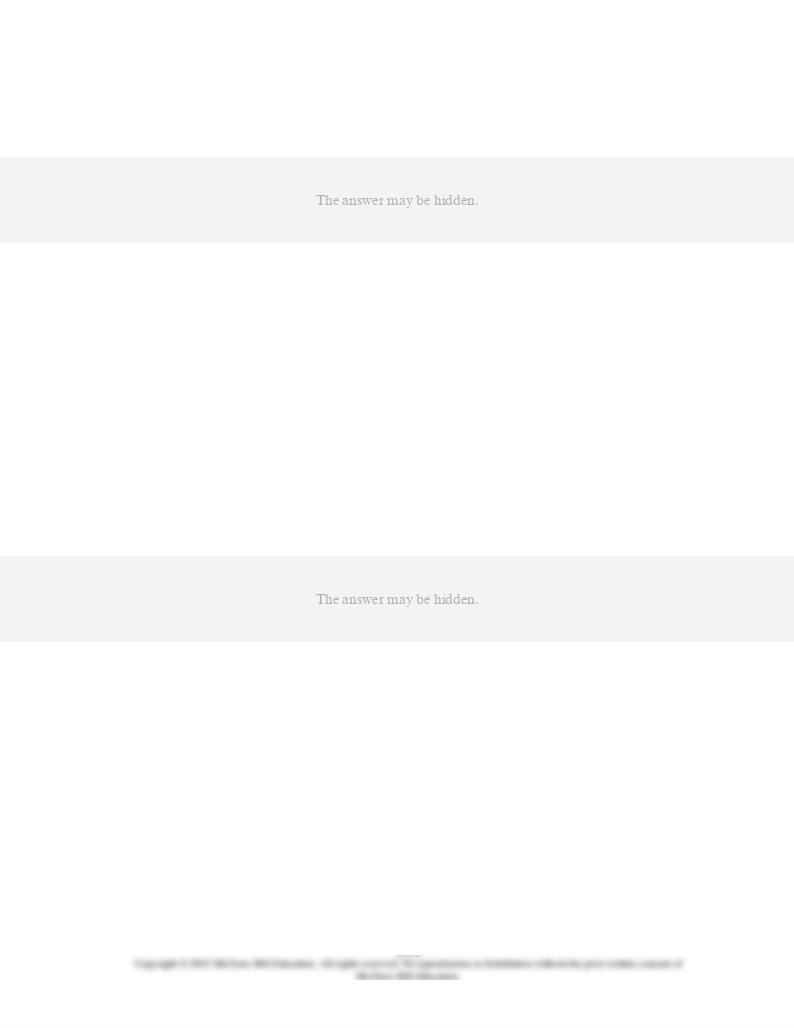
92.
An emission fee levied against polluting firms will tend to shift the:
AACSB: Analytic
Accessibility: Keyboard Navigation
Blooms: Understand
Difficulty: 2 Medium
Learning Objective: 04-05 Show why we normally won't want to pay what it would cost to eliminate every last bit of a
negative externality such as air pollution.
Topic: Government's Role in the Economy
93.
It has been proposed that a government agency be charged with the task of determining
the amount of pollution that the atmosphere (or a body of water) can safely absorb,
establish "rights" to this limited amount of pollution, and sell those limited amount of
rights to firms. The firms can then buy and sell these rights among themselves later. This
approach is known as the:
AACSB: Reflective Thinking
Accessibility: Keyboard Navigation
Blooms: Remember
Difficulty: 1 Easy
Learning Objective: 04-05 Show why we normally won't want to pay what it would cost to eliminate every last bit of a
negative externality such as air pollution.
Topic: Government's Role in the Economy

94.
A market for pollution rights can be expected to:
AACSB: Reflective Thinking
Accessibility: Keyboard Navigation
Blooms: Understand
Difficulty: 2 Medium
Learning Objective: 04-05 Show why we normally won't want to pay what it would cost to eliminate every last bit of a
negative externality such as air pollution.
Topic: Government's Role in the Economy
95.
By requiring car producers to install emission control devices on cars, the government
forces these producers to internalize some of the external costs of auto pollution. This will
lead to the equilibrium price of cars:
AACSB: Analytic
Accessibility: Keyboard Navigation
Blooms: Apply
Difficulty: 2 Medium
Learning Objective: 04-05 Show why we normally won't want to pay what it would cost to eliminate every last bit of a
negative externality such as air pollution.
Topic: Government's Role in the Economy
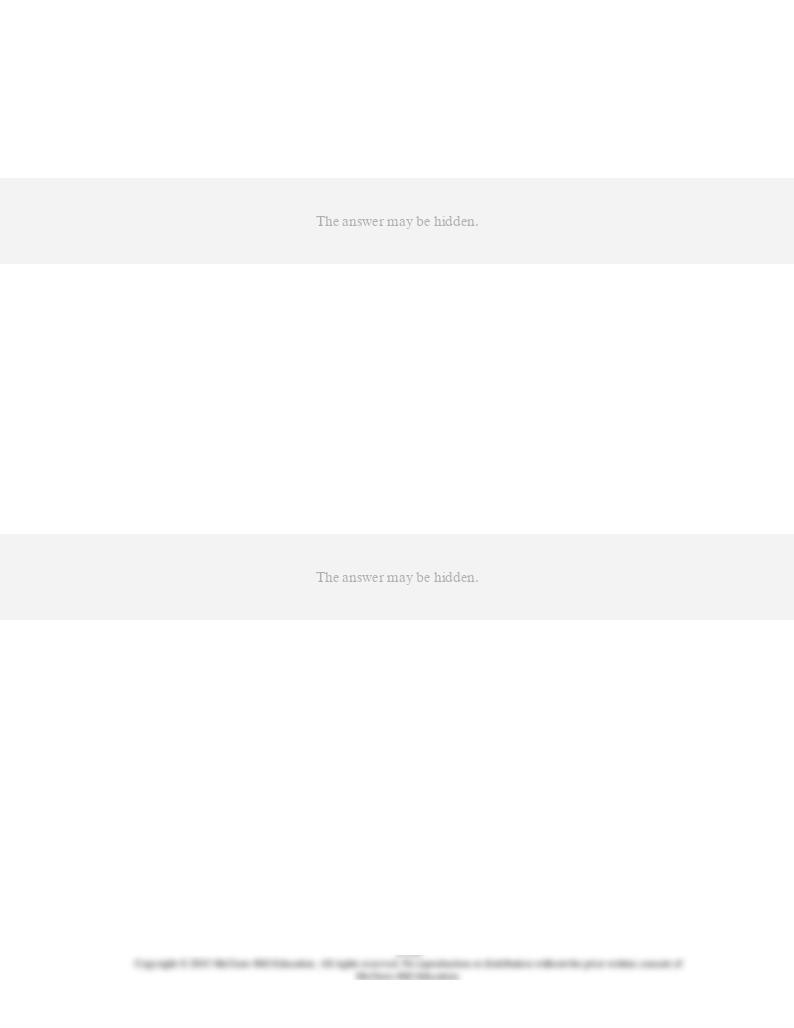
96.
From an economist's perspective, an important consideration for policies to address global
warming is:
AACSB: Reflective Thinking
Accessibility: Keyboard Navigation
Blooms: Apply
Difficulty: 2 Medium
Learning Objective: 04-05 Show why we normally won't want to pay what it would cost to eliminate every last bit of a
negative externality such as air pollution.
Topic: Externalities
97.
Oftentimes, the socially optimal quantity for a product that imposes external costs on the
society is not zero, but something greater than zero. This is because completely
eliminating the externality would involve:
AACSB: Reflective Thinking
Accessibility: Keyboard Navigation
Blooms: Apply
Difficulty: 2 Medium
Learning Objective: 04-05 Show why we normally won't want to pay what it would cost to eliminate every last bit of a
negative externality such as air pollution.
Topic: Government's Role in the Economy
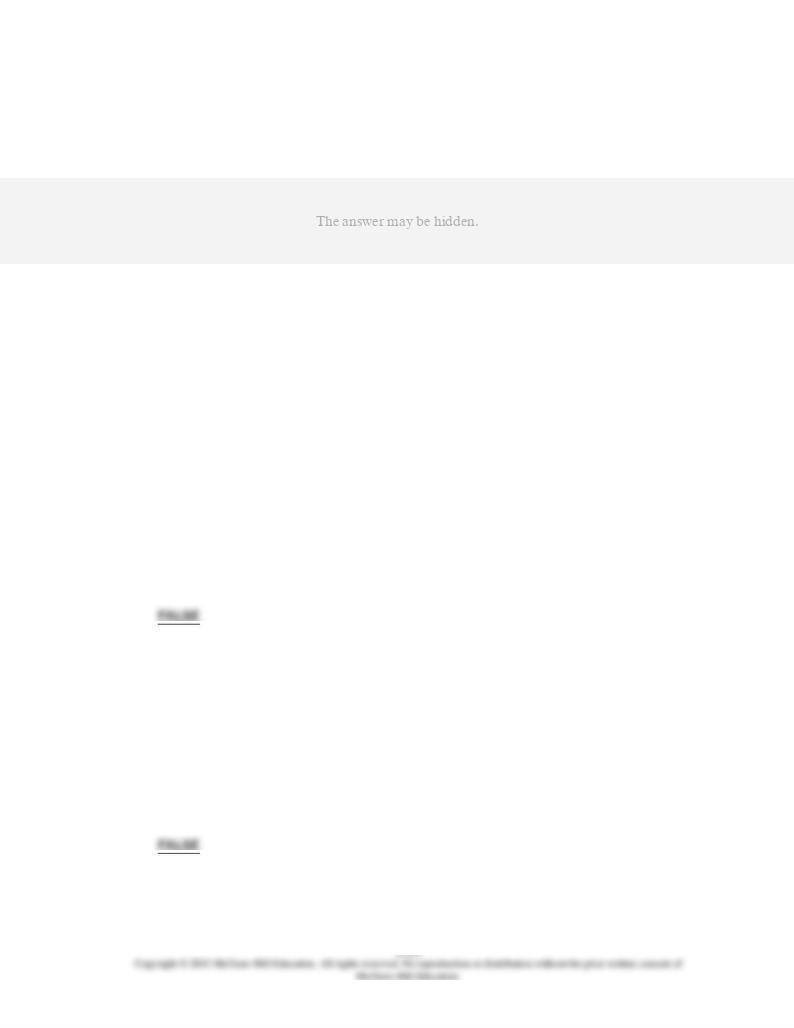
98.
Sometimes, public goods whose benefits are less than their costs still get produced
because:
AACSB: Reflective Thinking
Accessibility: Keyboard Navigation
Blooms: Understand
Difficulty: 2 Medium
Learning Objective: 04-05 Show why we normally won't want to pay what it would cost to eliminate every last bit of a
negative externality such as air pollution.
Topic: Government's Role in the Economy
True / False Questions
99.
Market failures refer to those situations where the sellers are not producing as much as
the buyers are wanting to buy.
AACSB: Analytic
Accessibility: Keyboard Navigation
Blooms: Remember
Difficulty: 1 Easy
Learning Objective: 04-01 Differentiate between demand-side market failures and supply-side market failures.
Topic: Market Failures in Competitive Markets
100.
Demand-side market failures refer to those situations when there is a shortage in the
market because buyers want to buy more than what is available in the market.
AACSB: Analytic
Accessibility: Keyboard Navigation
Blooms: Remember
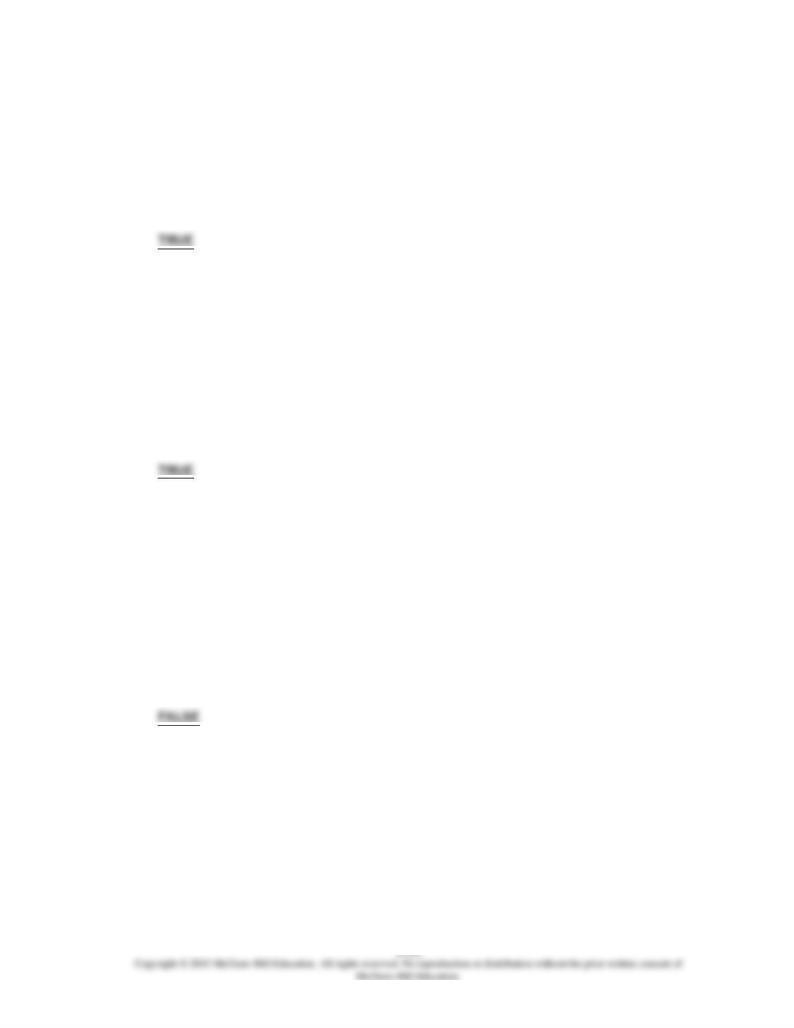
Difficulty: 1 Easy
Learning Objective: 04-01 Differentiate between demand-side market failures and supply-side market failures.
Topic: Market Failures in Competitive Markets
101.
When a producer cannot get all consumers of their product to pay for enjoying it, such as
in the case of a fireworks display, then we'd have a demand-side market failure.
AACSB: Analytic
Accessibility: Keyboard Navigation
Blooms: Remember
Difficulty: 1 Easy
Learning Objective: 04-01 Differentiate between demand-side market failures and supply-side market failures.
Topic: Market Failures in Competitive Markets
102.
Whenever there are supply-side market failures in the form of costs that suppliers do not
have to face, then there will be overproduction of the output.
AACSB: Reflective Thinking
Accessibility: Keyboard Navigation
Blooms: Understand
Difficulty: 3 Hard
Learning Objective: 04-02 Explain the origin of both consumer surplus and producer surplus; and explain how properly
functioning markets maximize their sum; total surplus; while optimally allocating resources.
Topic: Efficiently Functioning Markets
103.
If the consumer is willing to pay a price higher than the actual price of a product, then the
consumer will not buy the product because the consumer surplus will be negative.
AACSB: Analytic
Accessibility: Keyboard Navigation
Blooms: Remember
Difficulty: 1 Easy
Learning Objective: 04-02 Explain the origin of both consumer surplus and producer surplus; and explain how properly
functioning markets maximize their sum; total surplus; while optimally allocating resources.
Topic: Efficiently Functioning Markets
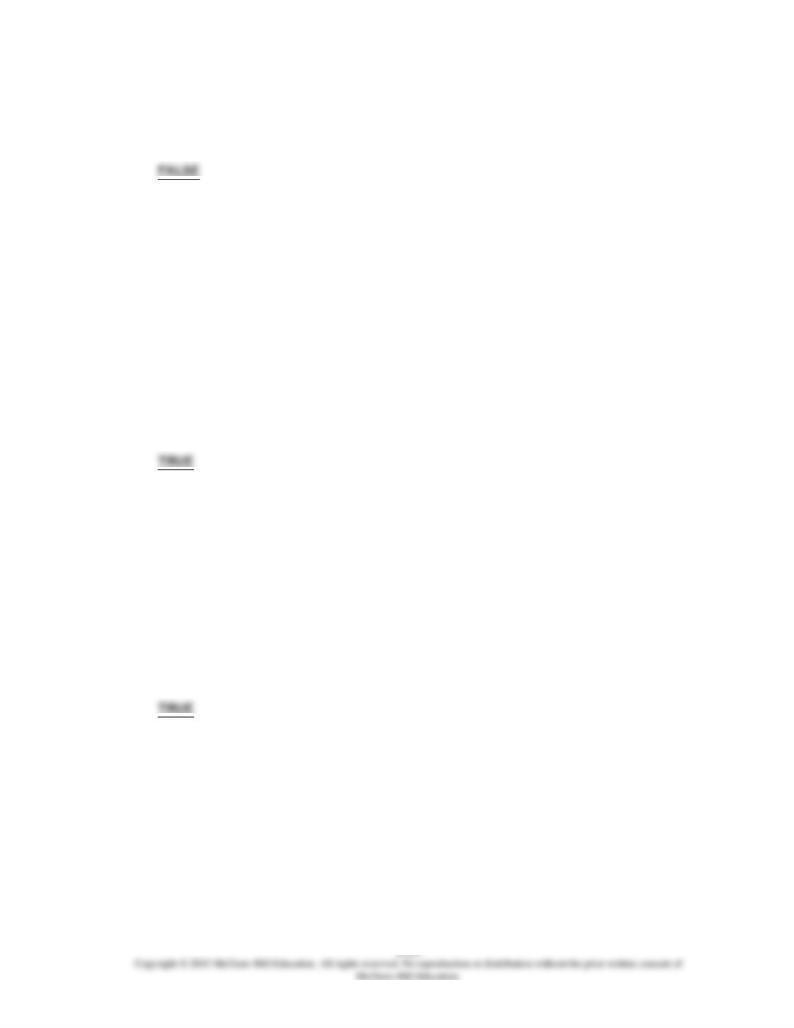
104.
Consumer surplus is the reason why sometimes a shopper regrets having bought a
particular item.
AACSB: Reflective Thinking
Accessibility: Keyboard Navigation
Blooms: Apply
Difficulty: 2 Medium
Learning Objective: 04-02 Explain the origin of both consumer surplus and producer surplus; and explain how properly
functioning markets maximize their sum; total surplus; while optimally allocating resources.
Topic: Efficiently Functioning Markets
105.
Assume that there are four consumers A, B, C, and D, and the prices that each of them is
willing to pay for a glass of lemonade is, respectively, $1.50, $1.20, $1.00, and $0.90. If the
actual price of lemonade is $1.00 per glass, then consumer surplus in this market will be
$0.70.
AACSB: Analytic
Accessibility: Keyboard Navigation
Blooms: Apply
Difficulty: 3 Hard
Learning Objective: 04-02 Explain the origin of both consumer surplus and producer surplus; and explain how properly
functioning markets maximize their sum; total surplus; while optimally allocating resources.
Topic: Efficiently Functioning Markets
106.
When the marginal benefits exceed the marginal costs of producing a product, then
allocative efficiency is not achieved in the market.
AACSB: Analytic
Accessibility: Keyboard Navigation
Blooms: Remember
Difficulty: 1 Easy
Learning Objective: 04-02 Explain the origin of both consumer surplus and producer surplus; and explain how properly
functioning markets maximize their sum; total surplus; while optimally allocating resources.
Topic: Efficiently Functioning Markets
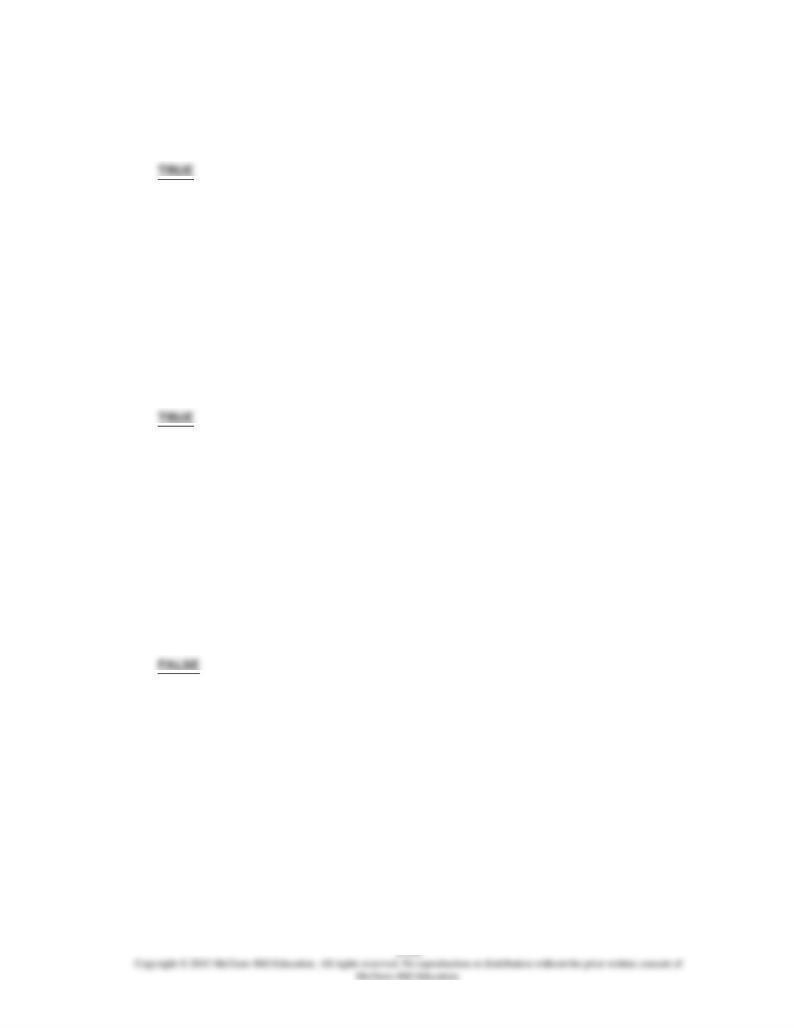
107.
When there is allocative efficiency in a market, the buyers' maximum willingness to pay for
the last unit traded is equal to the sellers' minimum acceptable price for that unit.
AACSB: Analytic
Accessibility: Keyboard Navigation
Blooms: Understand
Difficulty: 2 Medium
Learning Objective: 04-02 Explain the origin of both consumer surplus and producer surplus; and explain how properly
functioning markets maximize their sum; total surplus; while optimally allocating resources.
Topic: Efficiently Functioning Markets
108.
When the total consumer and producer surplus is at a maximum, the deadweight loss in
the market is zero.
AACSB: Analytic
Accessibility: Keyboard Navigation
Blooms: Remember
Difficulty: 1 Easy
Learning Objective: 04-02 Explain the origin of both consumer surplus and producer surplus; and explain how properly
functioning markets maximize their sum; total surplus; while optimally allocating resources.
Topic: Efficiently Functioning Markets
109.
Excludability means that when someone is consuming a good, then others are excluded
from using the good anymore.
AACSB: Communication
Accessibility: Keyboard Navigation
Blooms: Remember
Difficulty: 1 Easy
Learning Objective: 04-03 Describe free riding and public goods; and illustrate why private firms cannot normally produce
public goods.
Topic: Public Goods
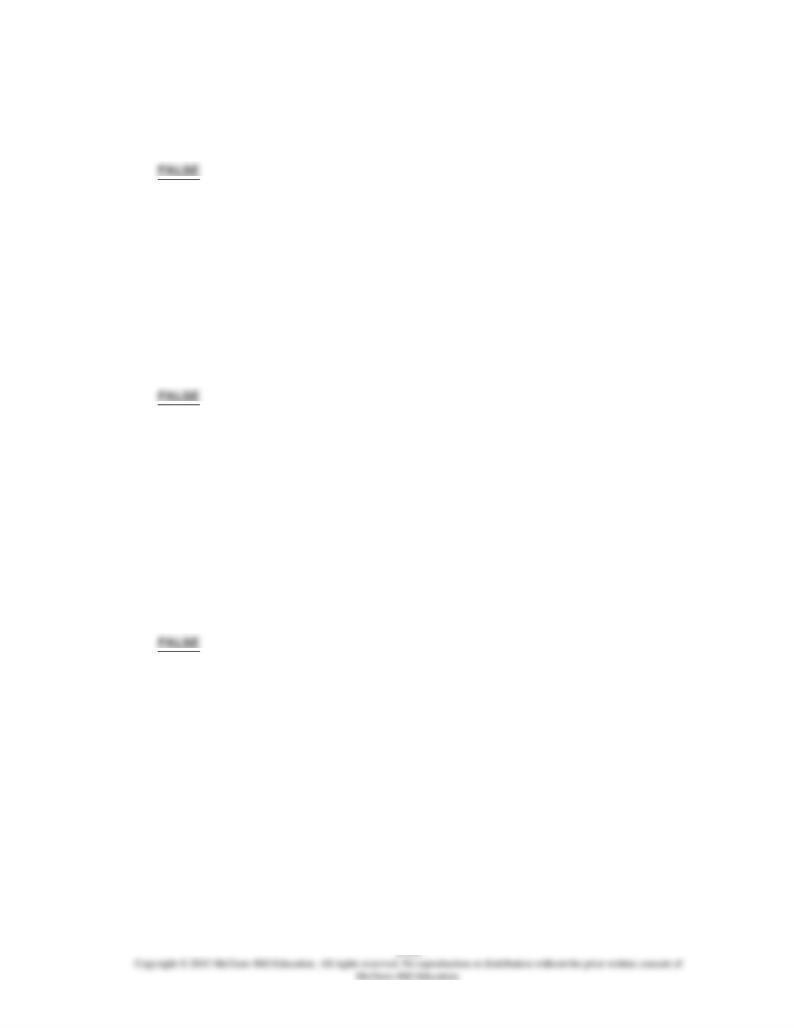
110.
Nonrivalry in the use or consumption of a good means that only one person is consuming
the good without any rivals.
AACSB: Communication
Accessibility: Keyboard Navigation
Blooms: Remember
Difficulty: 1 Easy
Learning Objective: 04-03 Describe free riding and public goods; and illustrate why private firms cannot normally produce
public goods.
Topic: Public Goods
111.
The free-rider problem makes a good highly profitable for a private firm to provide.
AACSB: Analytic
Accessibility: Keyboard Navigation
Blooms: Understand
Difficulty: 2 Medium
Learning Objective: 04-03 Describe free riding and public goods; and illustrate why private firms cannot normally produce
public goods.
Topic: Public Goods
112.
The free-rider problem refers to the local government's problem of finding funds to
subsidize public transportation.
AACSB: Communication
Accessibility: Keyboard Navigation
Blooms: Remember
Difficulty: 1 Easy
Learning Objective: 04-03 Describe free riding and public goods; and illustrate why private firms cannot normally produce
public goods.
Topic: Public Goods
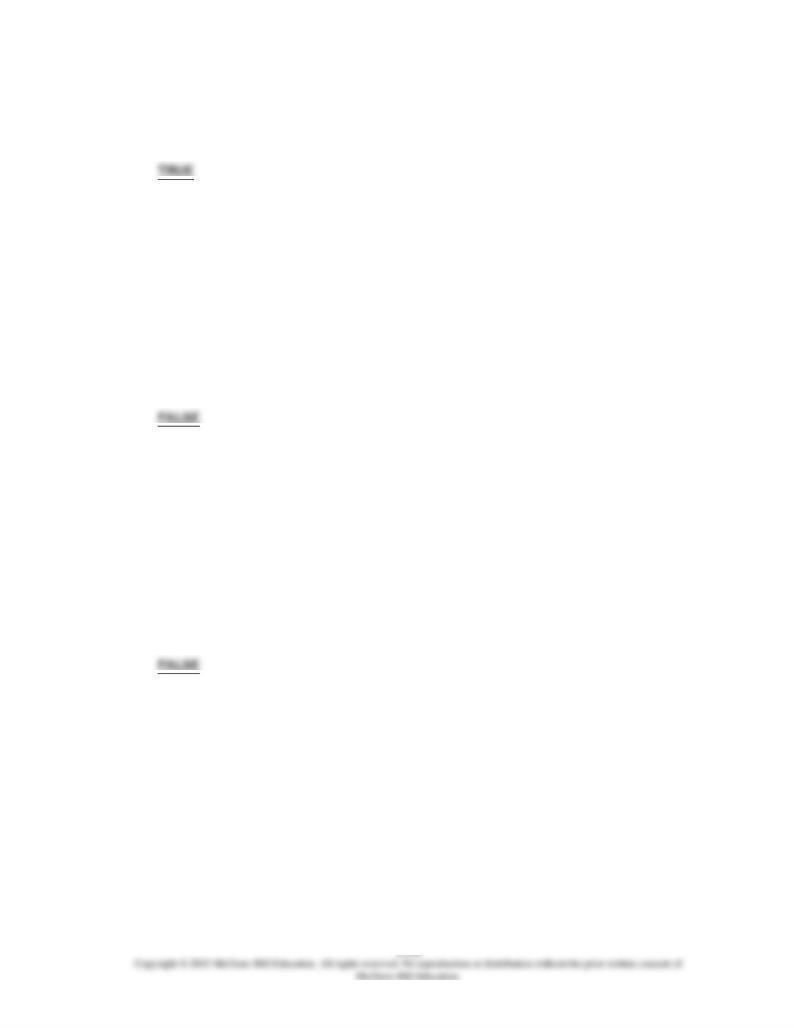
113.
Rivalry means that when one person buys and consumes a product, it is not available for
purchase and consumption by another person.
AACSB: Communication
Accessibility: Keyboard Navigation
Blooms: Remember
Difficulty: 1 Easy
Learning Objective: 04-03 Describe free riding and public goods; and illustrate why private firms cannot normally produce
public goods.
Topic: Public Goods
114.
The government receives all of the benefits associated with the production of a public
good.
AACSB: Analytic
Accessibility: Keyboard Navigation
Blooms: Understand
Difficulty: 1 Easy
Learning Objective: 04-03 Describe free riding and public goods; and illustrate why private firms cannot normally produce
public goods.
Topic: Public Goods
115.
The optimal quantity of a public good is where the total benefits from it are equal to the
total costs of producing it.
AACSB: Analytic
Accessibility: Keyboard Navigation
Blooms: Remember
Difficulty: 1 Easy
Learning Objective: 04-03 Describe free riding and public goods; and illustrate why private firms cannot normally produce
public goods.
Topic: Public Goods

116.
If car makers are required to install gadgets to improve the cleanliness of car-exhaust, we
would expect the equilibrium quantity in the car market to decrease.
AACSB: Analytic
Accessibility: Keyboard Navigation
Blooms: Apply
Difficulty: 2 Medium
Learning Objective: 04-04 Explain how positive and negative externalities cause under- and overallocations of resources.
Topic: Externalities
117.
If the lumber companies are required to internalize the negative externalities of
deforestation, then we should expect the equilibrium price of wooden furniture to
decrease.
AACSB: Analytic
Accessibility: Keyboard Navigation
Blooms: Apply
Difficulty: 3 Hard
Learning Objective: 04-04 Explain how positive and negative externalities cause under- and overallocations of resources.
Topic: Externalities
118.
The Coase Theorem suggests that the government does not have to be involved at all in
resolving a market failure due to externalities.
AACSB: Reflective Thinking
Accessibility: Keyboard Navigation
Blooms: Understand
Difficulty: 2 Medium
Learning Objective: 04-04 Explain how positive and negative externalities cause under- and overallocations of resources.
Topic: Externalities
119.
Production subsidies are a way of internalizing external costs among polluting firms.
AACSB: Analytic
Accessibility: Keyboard Navigation

Blooms: Understand
Difficulty: 2 Medium
Learning Objective: 04-04 Explain how positive and negative externalities cause under- and overallocations of resources.
Topic: Externalities
120.
In dealing with market failures, the government always bases its decisions on economic
analysis of marginal cost and marginal benefit.
AACSB: Analytic
Accessibility: Keyboard Navigation
Blooms: Remember
Difficulty: 1 Easy
Learning Objective: 04-05 Show why we normally won't want to pay what it would cost to eliminate every last bit of a
negative externality such as air pollution.
Topic: Government's Role in the Economy
121.
An effective antipollution policy from the economic perspective requires that all pollution
be eliminated and banned.
AACSB: Reflective Thinking
Accessibility: Keyboard Navigation
Blooms: Apply
Difficulty: 2 Medium
Learning Objective: 04-05 Show why we normally won't want to pay what it would cost to eliminate every last bit of a
negative externality such as air pollution.
Topic: Government's Role in the Economy
122.
Because in any period of time and in any region the quantity of pollutants that can be
absorbed by nature is fixed, the supply of "pollution rights" in a cap-and-trade system will
be perfectly elastic.
AACSB: Reflective Thinking
Accessibility: Keyboard Navigation
Blooms: Apply
Difficulty: 3 Hard
Learning Objective: 04-05 Show why we normally won't want to pay what it would cost to eliminate every last bit of a
negative externality such as air pollution.
Topic: Government's Role in the Economy

123.
In a well-functioning "cap-and-trade system" for pollution rights, society benefits because
pollution will be brought down to insignificant levels.
AACSB: Reflective Thinking
Accessibility: Keyboard Navigation
Blooms: Remember
Difficulty: 2 Medium
Learning Objective: 04-05 Show why we normally won't want to pay what it would cost to eliminate every last bit of a
negative externality such as air pollution.
Topic: Government's Role in the Economy
124.
In a well-functioning cap-and-trade system for pollution rights, the right to pollute will go
to those who are able to acquire the largest net benefit from using the scarce resource
"clean air".
AACSB: Reflective Thinking
Accessibility: Keyboard Navigation
Blooms: Remember
Difficulty: 3 Hard
Learning Objective: 04-05 Show why we normally won't want to pay what it would cost to eliminate every last bit of a
negative externality such as air pollution.
Topic: Government's Role in the Economy
Multiple Choice Questions
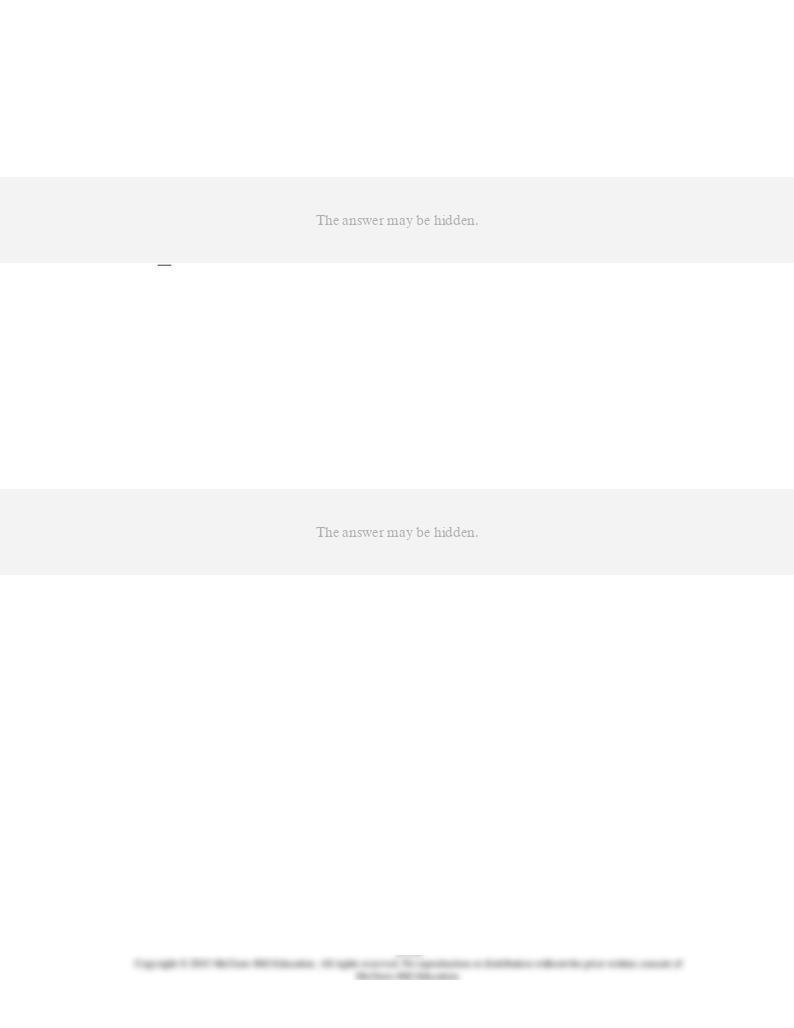
125.
Asymmetric information in a market transaction occurs when there is unequal knowledge
possessed by the:
AACSB: Communication
Accessibility: Keyboard Navigation
Blooms: Remember
Difficulty: 1 Easy
Learning Objective: 04-06 (Appendix) Describe how information failures may justify government intervention in some
markets.
Topic: Information Failures
126.
Which of the following does
not
illustrate the asymmetric information problem:
AACSB: Communication
Accessibility: Keyboard Navigation
Blooms: Understand
Difficulty: 2 Medium
Learning Objective: 04-06 (Appendix) Describe how information failures may justify government intervention in some
markets.
Topic: Information Failures
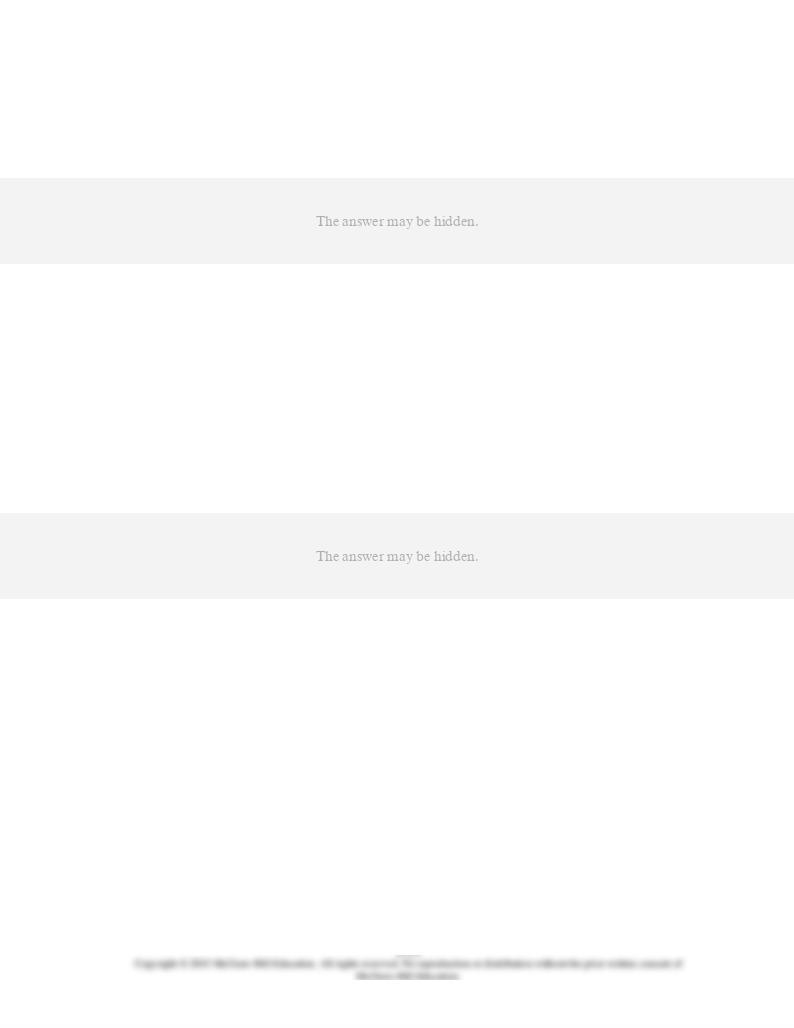
127.
If Congress decreases the amount of government insurance on bank deposits, then this
action would:
AACSB: Analytic
Accessibility: Keyboard Navigation
Blooms: Apply
Difficulty: 1 Easy
Learning Objective: 04-06 (Appendix) Describe how information failures may justify government intervention in some
markets.
Topic: Information Failures
128.
When sellers are unable to distinguish "good" buyers from "bad" ones, they face the
problem of:
AACSB: Communication
Accessibility: Keyboard Navigation
Blooms: Remember
Difficulty: 1 Easy
Learning Objective: 04-06 (Appendix) Describe how information failures may justify government intervention in some
markets.
Topic: Information Failures

129.
The moral hazard problem arises primarily because of:
AACSB: Analytic
Accessibility: Keyboard Navigation
Blooms: Remember
Difficulty: 1 Easy
Learning Objective: 04-06 (Appendix) Describe how information failures may justify government intervention in some
markets.
Topic: Information Failures
130.
Which of the following would be an example of government intervention to correct a
market failure caused by buyers having inadequate information about sellers?
AACSB: Reflective Thinking
Accessibility: Keyboard Navigation
Blooms: Apply
Difficulty: 3 Hard
Learning Objective: 04-06 (Appendix) Describe how information failures may justify government intervention in some
markets.
Topic: Information Failures
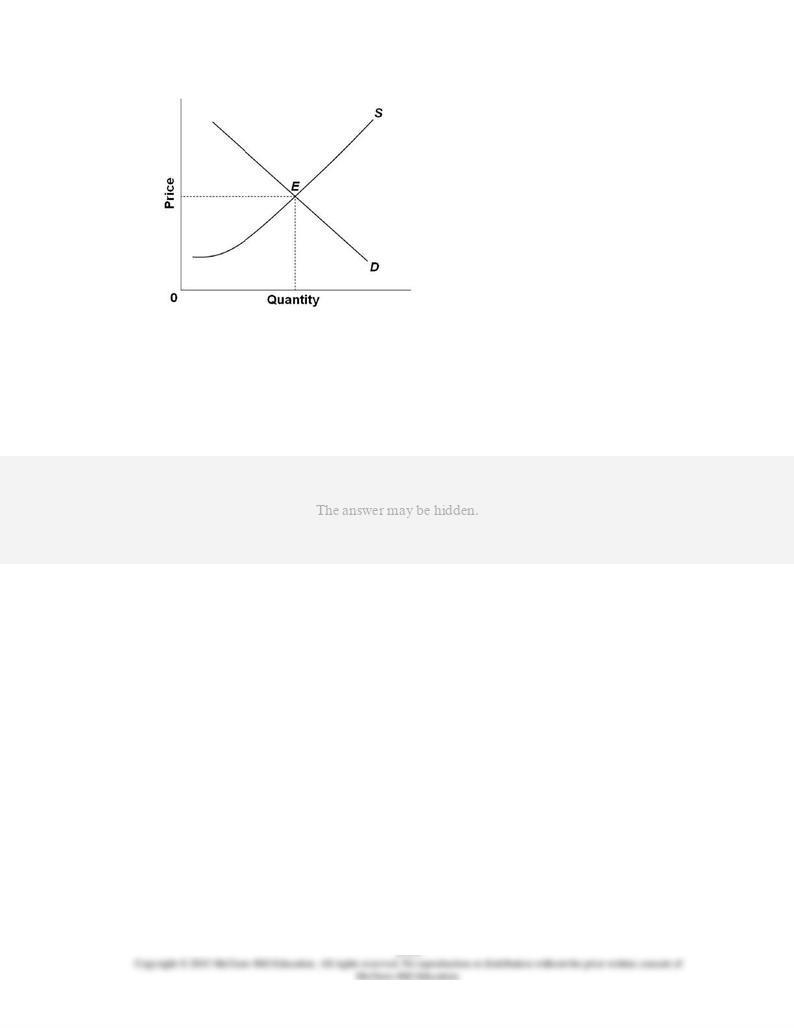
131.
Refer to the graph above. Suppose consumers do not know the safety risks associated
with a particular good, and that the free-market equilibrium is at E as shown in the
diagram above. If an independent agency now provides accurate information about the
harmful characteristics of the product, then:
AACSB: Analytic
Blooms: Apply
Difficulty: 2 Medium
Learning Objective: 04-06 (Appendix) Describe how information failures may justify government intervention in some
markets.
Topic: Information Failures
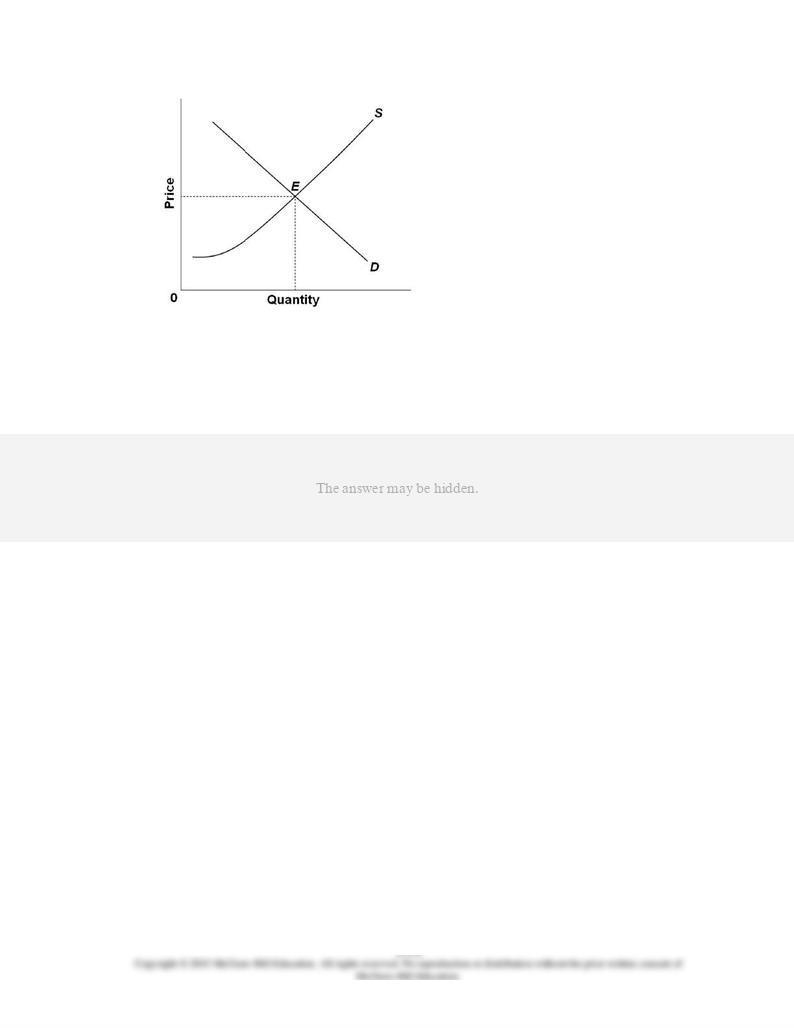
132.
Refer to the graph above. Suppose consumers do not fully appreciate the benefits of the
product whose market shown in the graph. If an external agency is able to provide full
information about the benefits of the product, then:
AACSB: Analytic
Blooms: Apply
Difficulty: 2 Medium
Learning Objective: 04-06 (Appendix) Describe how information failures may justify government intervention in some
markets.
Topic: Information Failures
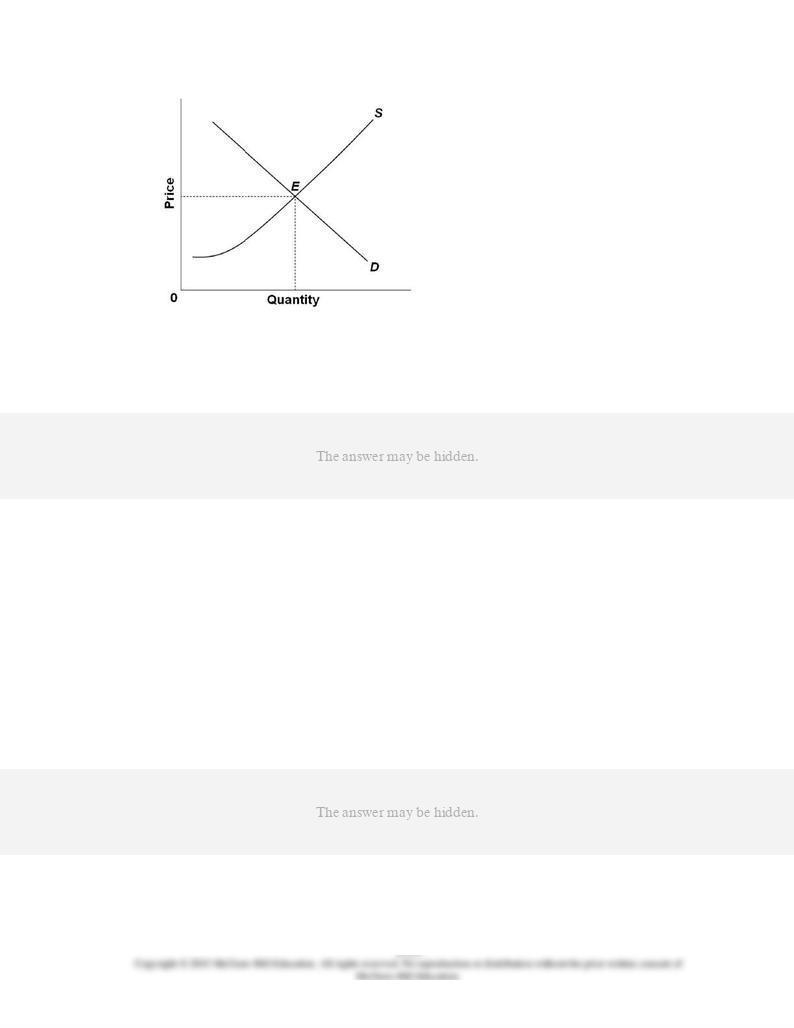
133.
Refer to the graph above. Suppose that it is shows the market for an insurance product. If
something happens to heighten the adverse selection problem in this market, then:
AACSB: Analytic
AACSB: Reflective Thinking
Blooms: Apply
Difficulty: 3 Hard
Learning Objective: 04-06 (Appendix) Describe how information failures may justify government intervention in some
markets.
Topic: Information Failures
134.
The 2010 Health Care Reform Law, also known as "Obamacare", includes a part known as
universal coverage
which requires everyone to have health insurance. One reason for this
is to address the problem of:
AACSB: Reflective Thinking
Accessibility: Keyboard Navigation
Blooms: Apply
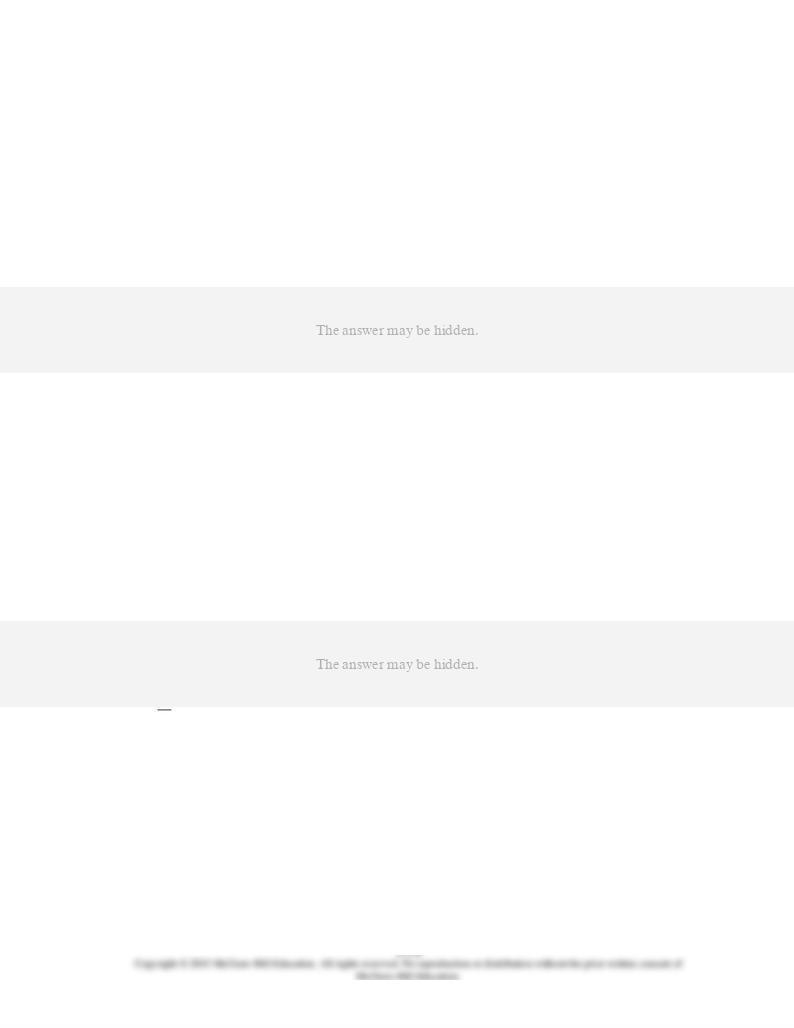
Difficulty: 2 Medium
Learning Objective: 04-06 (Appendix) Describe how information failures may justify government intervention in some
markets.
Topic: Information Failures
135.
The "too big to fail" policy of the Fed, whereby some banks are bailed out if they are in
danger of failing because they are too big and could bring the system down, leads to which
of the following problems?
AACSB: Reflective Thinking
Accessibility: Keyboard Navigation
Blooms: Apply
Difficulty: 2 Medium
Learning Objective: 04-06 (Appendix) Describe how information failures may justify government intervention in some
markets.
Topic: Information Failures
136.
If a person drives with less care after purchasing auto insurance, this situation would be
an example of a(n):
AACSB: Reflective Thinking
Accessibility: Keyboard Navigation
Blooms: Apply
Difficulty: 1 Easy
Learning Objective: 04-06 (Appendix) Describe how information failures may justify government intervention in some
markets.
Topic: Information Failures
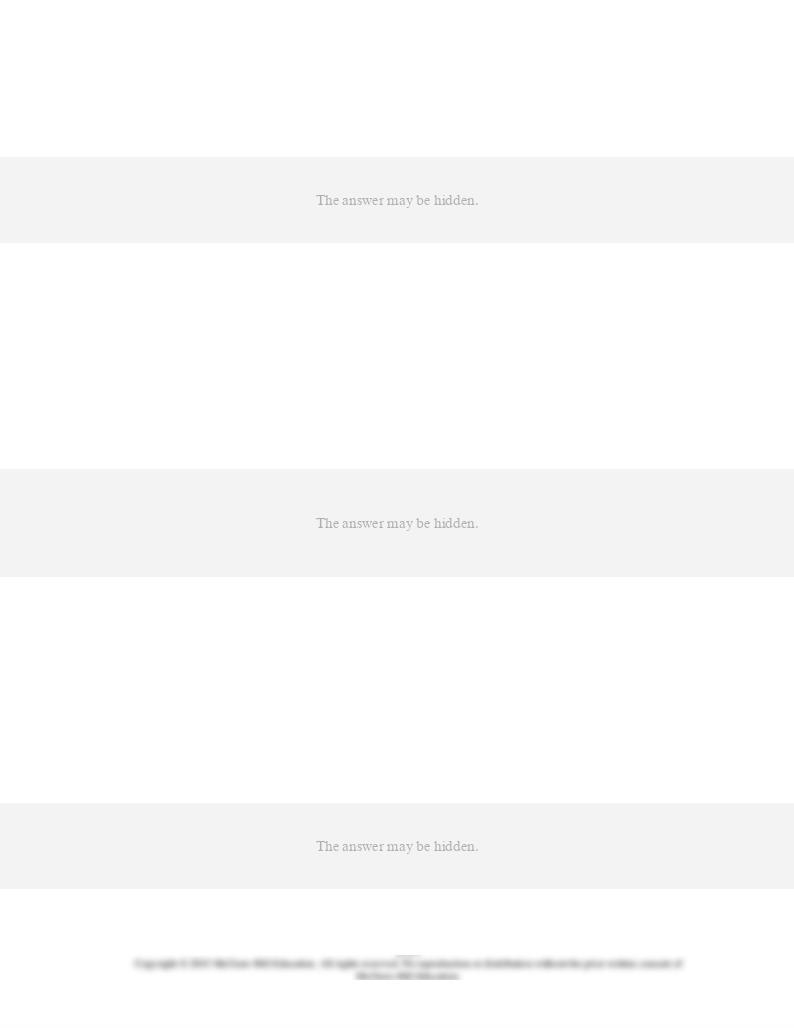
137.
Which of the following would be an example of a moral hazard problem?
AACSB: Reflective Thinking
Accessibility: Keyboard Navigation
Blooms: Apply
Difficulty: 1 Easy
Learning Objective: 04-06 (Appendix) Describe how information failures may justify government intervention in some
markets.
Topic: Information Failures
138.
Which of the following would be considered an example of adverse selection?
AACSB: Reflective Thinking
Accessibility: Keyboard Navigation
Blooms: Apply
Difficulty: 2 Medium
Learning Objective: 04-06 (Appendix) Describe how information failures may justify government intervention in some
markets.
Topic: Information Failures
139.
The franchising of fast-food restaurants would be an example of how a private business:
AACSB: Reflective Thinking
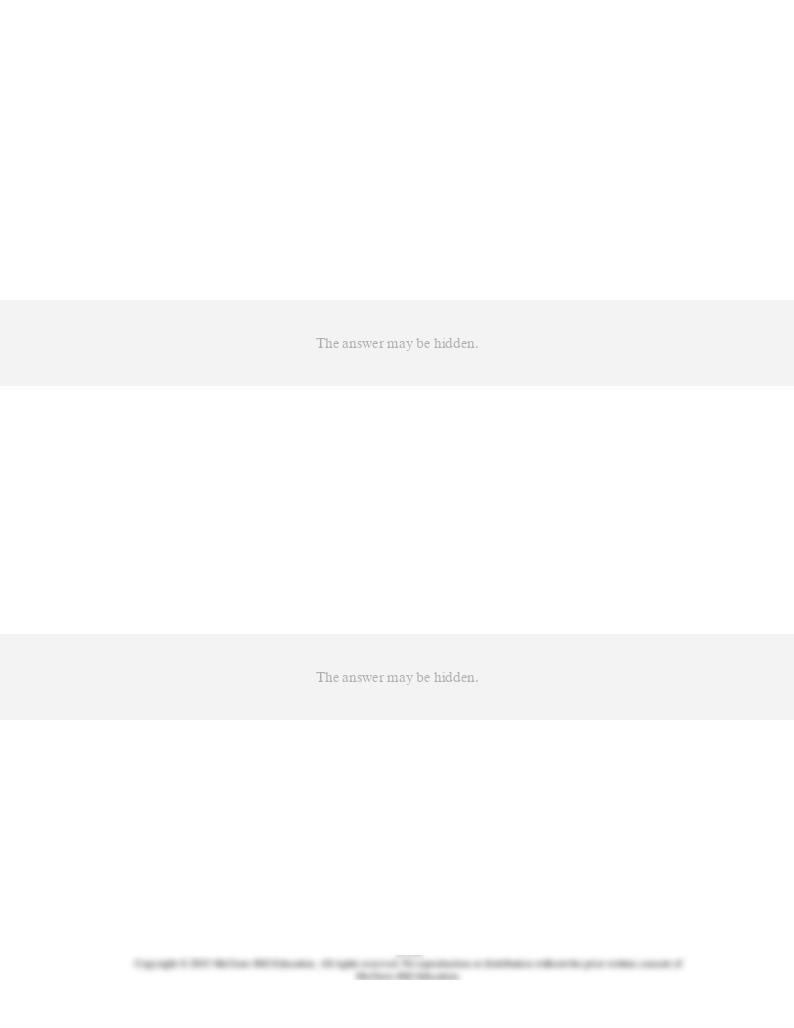
Accessibility: Keyboard Navigation
Blooms: Apply
Difficulty: 2 Medium
Learning Objective: 04-06 (Appendix) Describe how information failures may justify government intervention in some
markets.
Topic: Information Failures
140.
Insurance policies typically stipulate a deductible amount which the insured must
shoulder; this is to address the problem of:
AACSB: Reflective Thinking
Accessibility: Keyboard Navigation
Blooms: Apply
Difficulty: 2 Medium
Learning Objective: 04-06 (Appendix) Describe how information failures may justify government intervention in some
markets.
Topic: Information Failures
141.
Depositors do not check their banks carefully for stability anymore, because of the Federal
deposit insurance program. This illustrates the problem of:
AACSB: Reflective Thinking
Accessibility: Keyboard Navigation
Blooms: Apply
Difficulty: 2 Medium
Learning Objective: 04-06 (Appendix) Describe how information failures may justify government intervention in some
markets.
Topic: Information Failures

142.
E-bay, Amazon and other Internet shopping sites provide "seller ratings" done by previous
buyers, in order to help deal with the problem of:
AACSB: Reflective Thinking
Accessibility: Keyboard Navigation
Blooms: Apply
Difficulty: 2 Medium
Learning Objective: 04-06 (Appendix) Describe how information failures may justify government intervention in some
markets.
Topic: Information Failures
143.
Credit bureaus provide credit histories to banks and insurance companies, in order to help
deal with the problem of:
AACSB: Reflective Thinking
Accessibility: Keyboard Navigation
Blooms: Apply
Difficulty: 2 Medium
Learning Objective: 04-06 (Appendix) Describe how information failures may justify government intervention in some
markets.
Topic: Information Failures

144.
There is an adverse selection problem in the market for used cars because:
AACSB: Analytic
Accessibility: Keyboard Navigation
Blooms: Remember
Difficulty: 3 Hard
Learning Objective: 04-06 (Appendix) Describe how information failures may justify government intervention in some
markets.
Topic: Information Failures
145.
One consequence of the asymmetric-information problem in the used car market, if left
unresolved, is the higher probability of:
AACSB: Analytic
Accessibility: Keyboard Navigation
Blooms: Apply
Difficulty: 3 Hard
Learning Objective: 04-06 (Appendix) Describe how information failures may justify government intervention in some
markets.
Topic: Information Failures
True / False Questions

146.
Asymmetric information occurs when the two parties in a market transaction do not have
the same amount of information regarding the product or process involved in the
transaction.
AACSB: Analytic
Accessibility: Keyboard Navigation
Blooms: Remember
Difficulty: 1 Easy
Learning Objective: 04-06 (Appendix) Describe how information failures may justify government intervention in some
markets.
Topic: Information Failures
147.
The licensing and regulation of financial advisers is one way by which the government
tries to deal with the problem of inadequate information that financial firms about their
customers.
AACSB: Analytic
Accessibility: Keyboard Navigation
Blooms: Understand
Difficulty: 2 Medium
Learning Objective: 04-06 (Appendix) Describe how information failures may justify government intervention in some
markets.
Topic: Information Failures
148.
Better Business Bureaus in various cities exist partly in order to try to deal with
inadequate buyer information about sellers.
AACSB: Analytic
Accessibility: Keyboard Navigation
Blooms: Remember
Difficulty: 1 Easy
Learning Objective: 04-06 (Appendix) Describe how information failures may justify government intervention in some
markets.
Topic: Information Failures

149.
A moral hazard problem occurs before a transaction - when people alter their behavior
before they sign a contract, imposing costs on the other party.
AACSB: Analytic
Accessibility: Keyboard Navigation
Blooms: Understand
Difficulty: 2 Medium
Learning Objective: 04-06 (Appendix) Describe how information failures may justify government intervention in some
markets.
Topic: Information Failures
150.
Adverse selection is when someone with home insurance decides to take the chance that
a dying tree would fall on the garage, rather than spend the money to have the tree cut
down.
AACSB: Analytic
Accessibility: Keyboard Navigation
Blooms: Apply
Difficulty: 2 Medium
Learning Objective: 04-06 (Appendix) Describe how information failures may justify government intervention in some
markets.
Topic: Information Failures
151.
When the government bails out large banks when the banks become unstable, it could
lead to a moral hazard problem.
AACSB: Analytic
Accessibility: Keyboard Navigation
Blooms: Apply
Difficulty: 3 Hard
Learning Objective: 04-06 (Appendix) Describe how information failures may justify government intervention in some
markets.
Topic: Information Failures
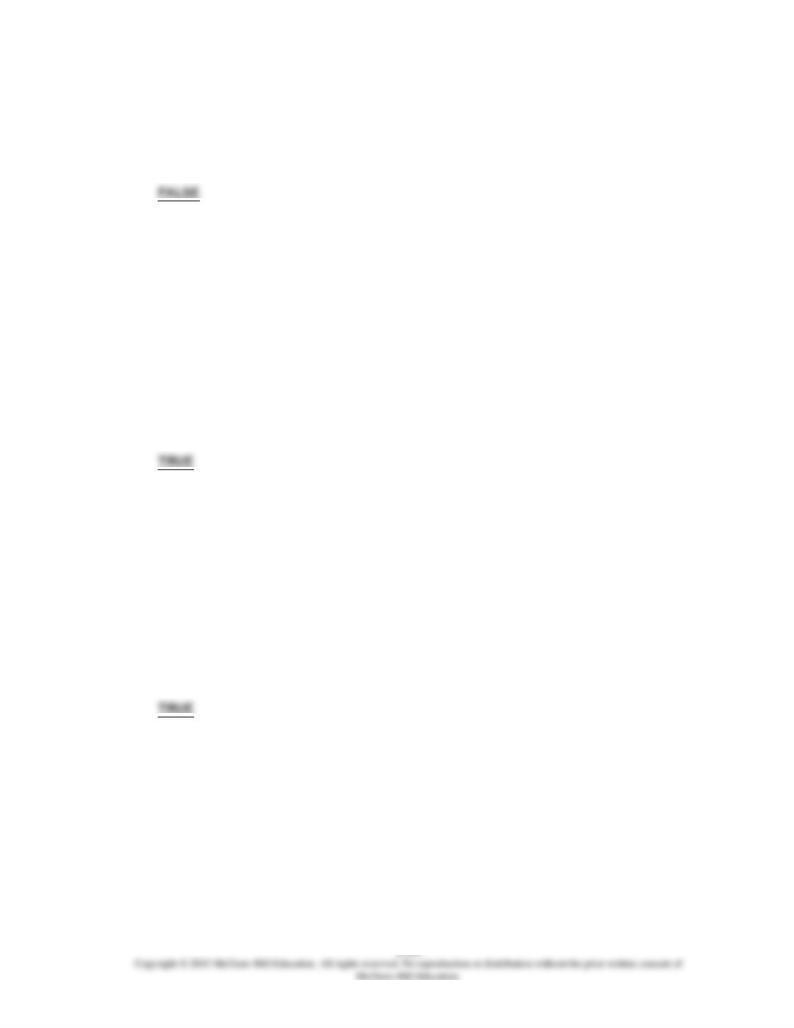
152.
When the government bails out failing banks, it creates a moral hazard problem; but when
the government bails out homeowners who are defaulting, there is no moral hazard
problem.
AACSB: Analytic
Accessibility: Keyboard Navigation
Blooms: Apply
Difficulty: 3 Hard
Learning Objective: 04-06 (Appendix) Describe how information failures may justify government intervention in some
markets.
Topic: Information Failures
153.
When critics of unemployment insurance claim that some of the unemployed are not
exerting much effort to find jobs because of the unemployment benefits, they are referring
to the moral hazard problem.
AACSB: Analytic
Accessibility: Keyboard Navigation
Blooms: Apply
Difficulty: 2 Medium
Learning Objective: 04-06 (Appendix) Describe how information failures may justify government intervention in some
markets.
Topic: Information Failures
154.
E-bay and Amazon provide "sellers' ratings" information based on the experiences of past
buyers. This is to help resolve the adverse selection problem faced by potential buyers.
AACSB: Analytic
Accessibility: Keyboard Navigation
Blooms: Apply
Difficulty: 2 Medium
Learning Objective: 04-06 (Appendix) Describe how information failures may justify government intervention in some
markets.
Topic: Information Failures

155.
An example of an adverse selection problem is in insurance, where the people most likely
to claim insurance payouts are the people who will seek to buy the most generous
policies.
AACSB: Analytic
Accessibility: Keyboard Navigation
Blooms: Apply
Difficulty: 2 Medium
Learning Objective: 04-06 (Appendix) Describe how information failures may justify government intervention in some
markets.
Topic: Information Failures